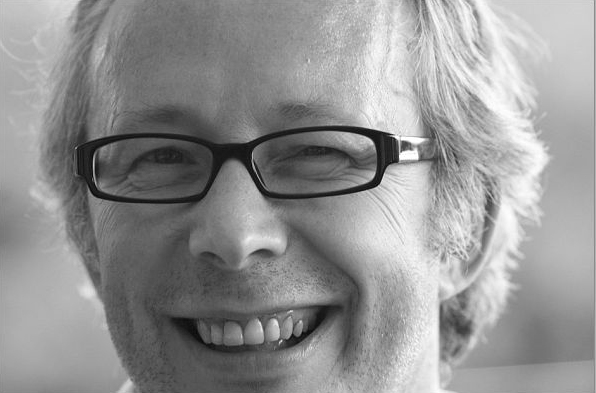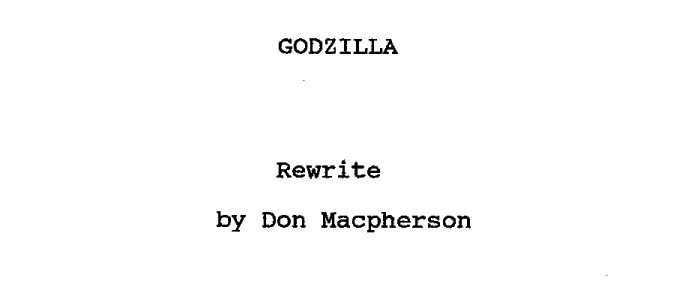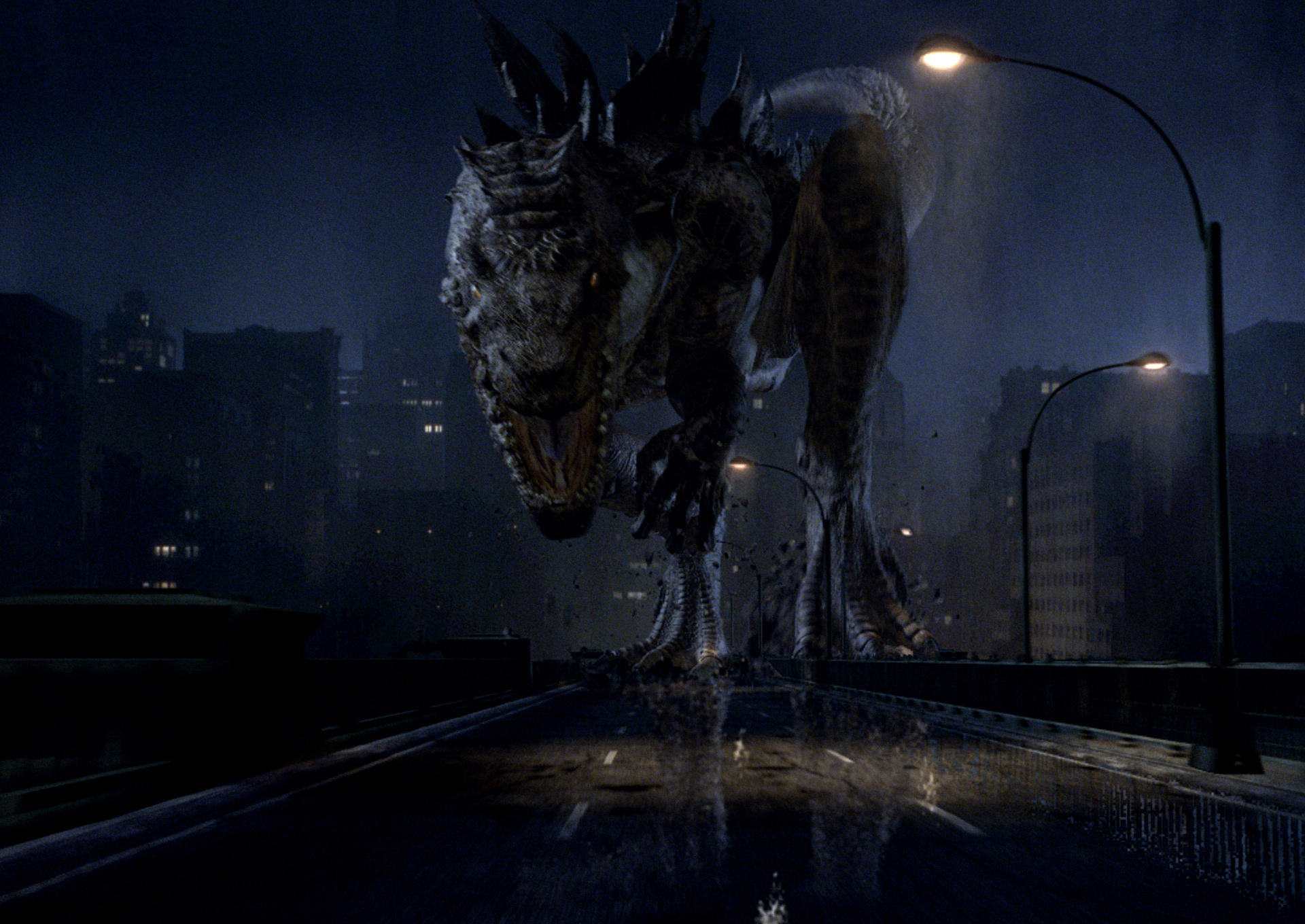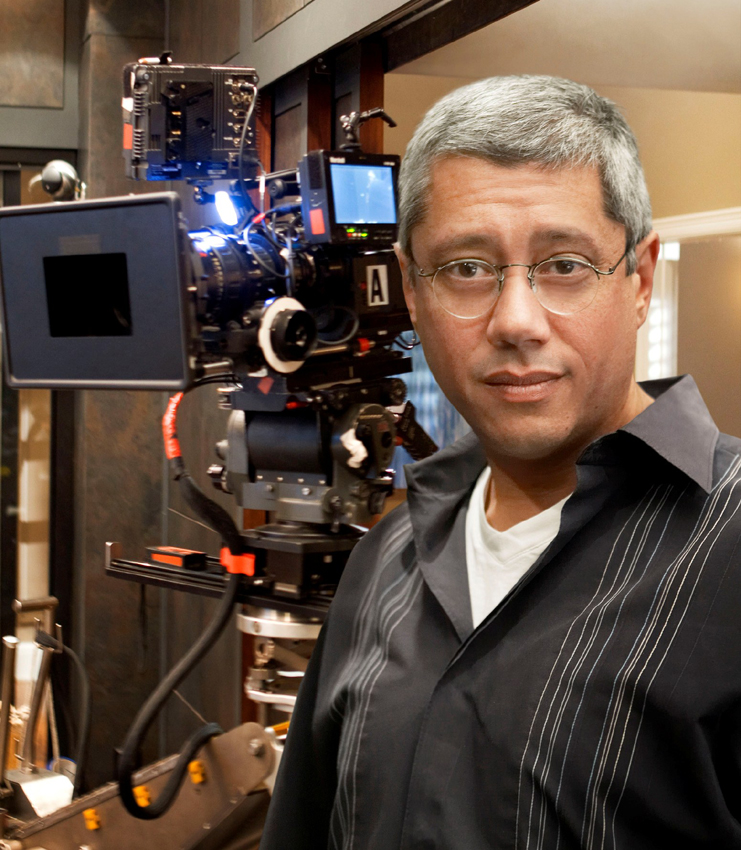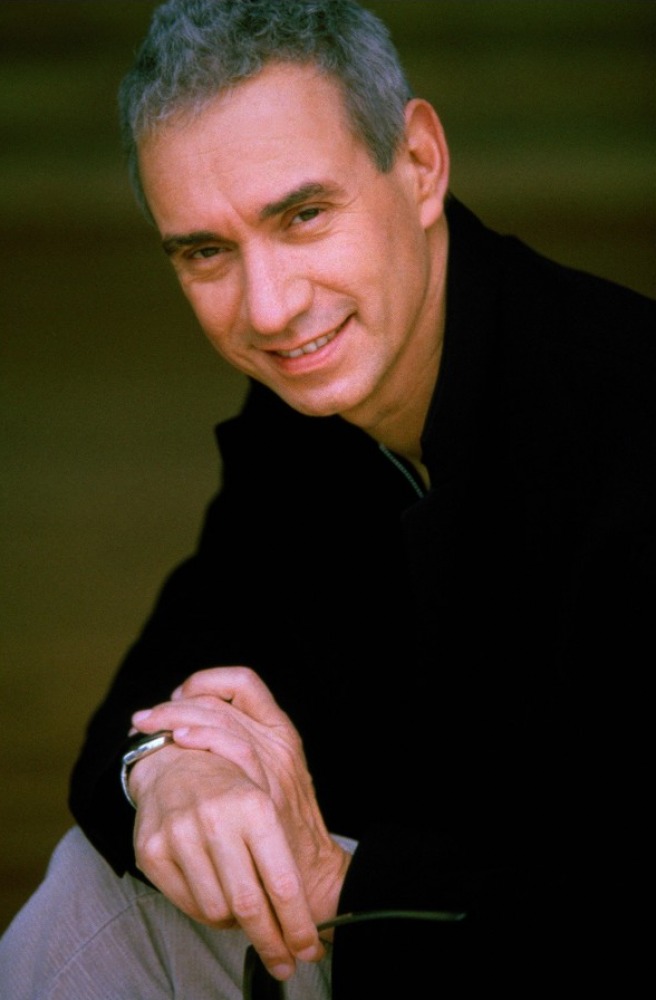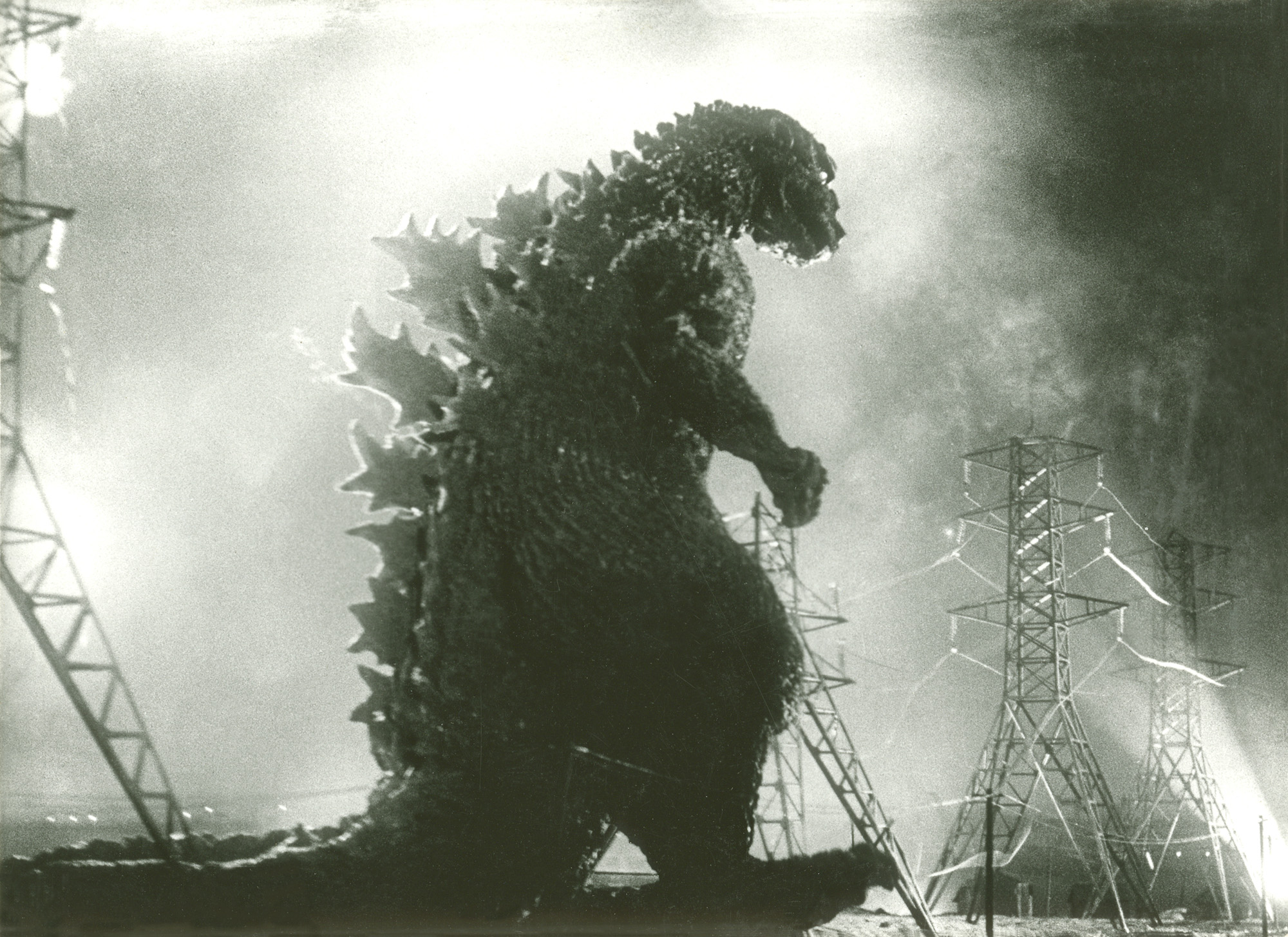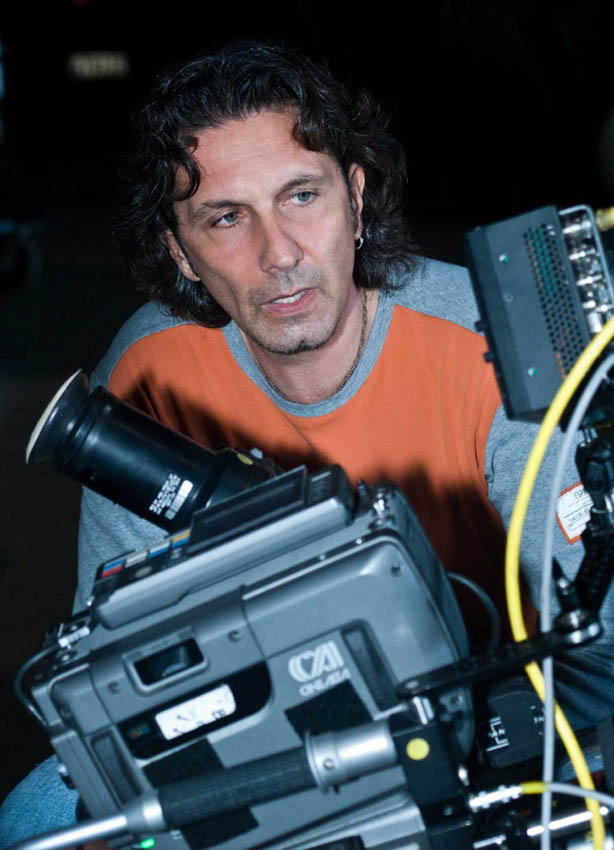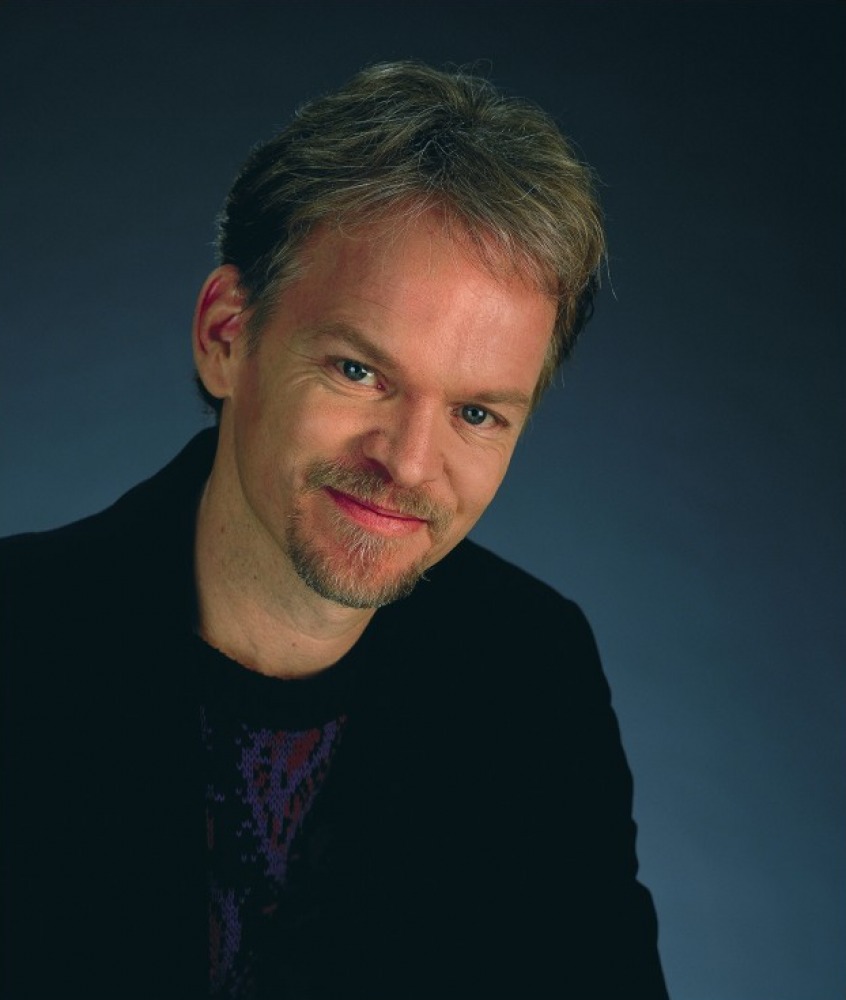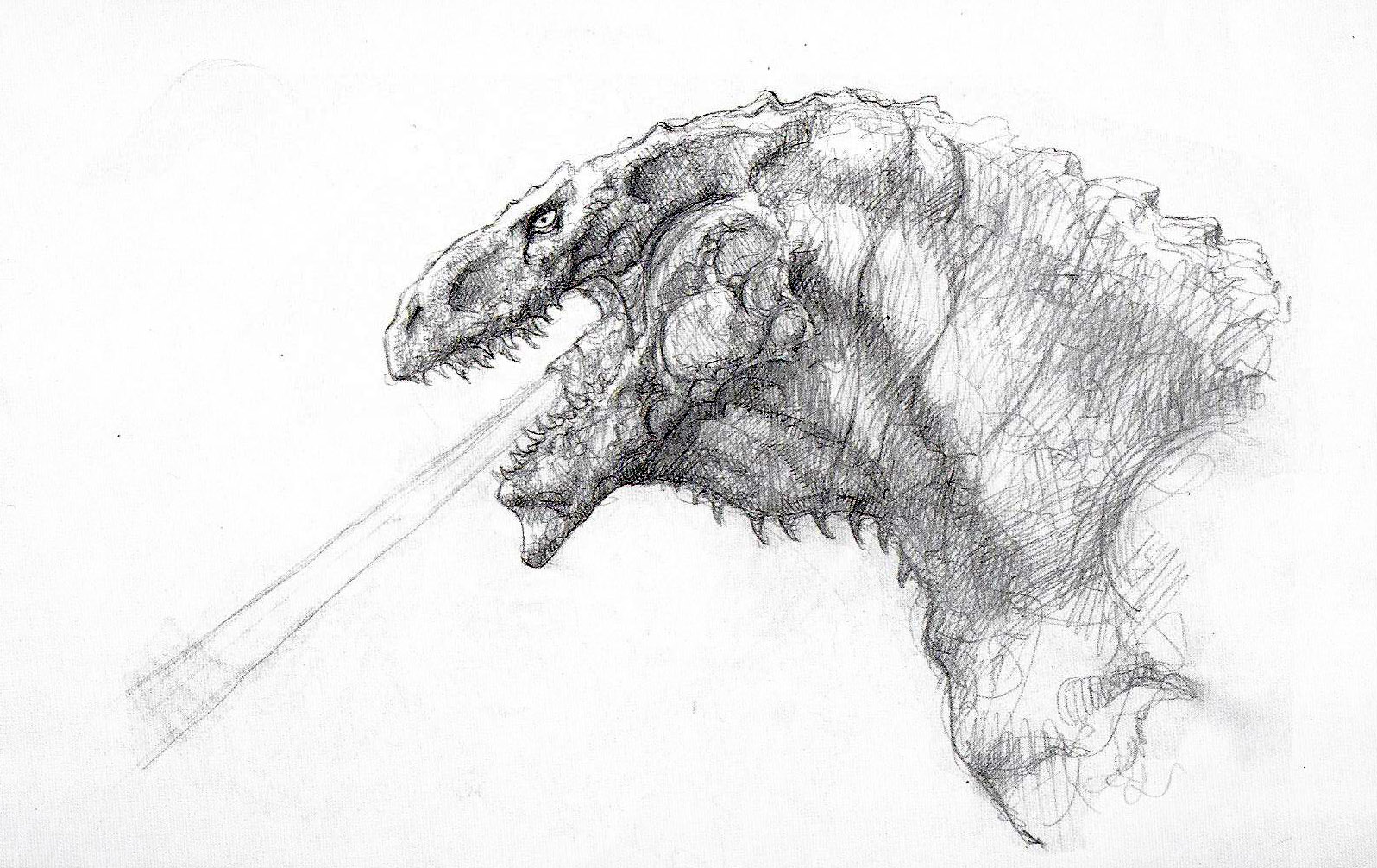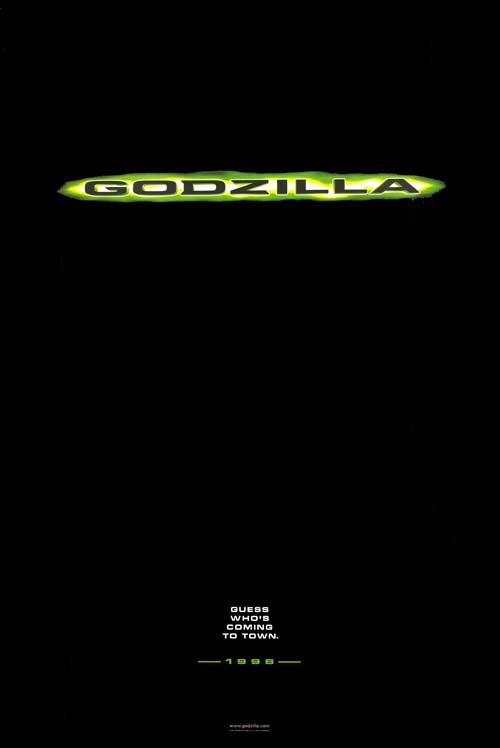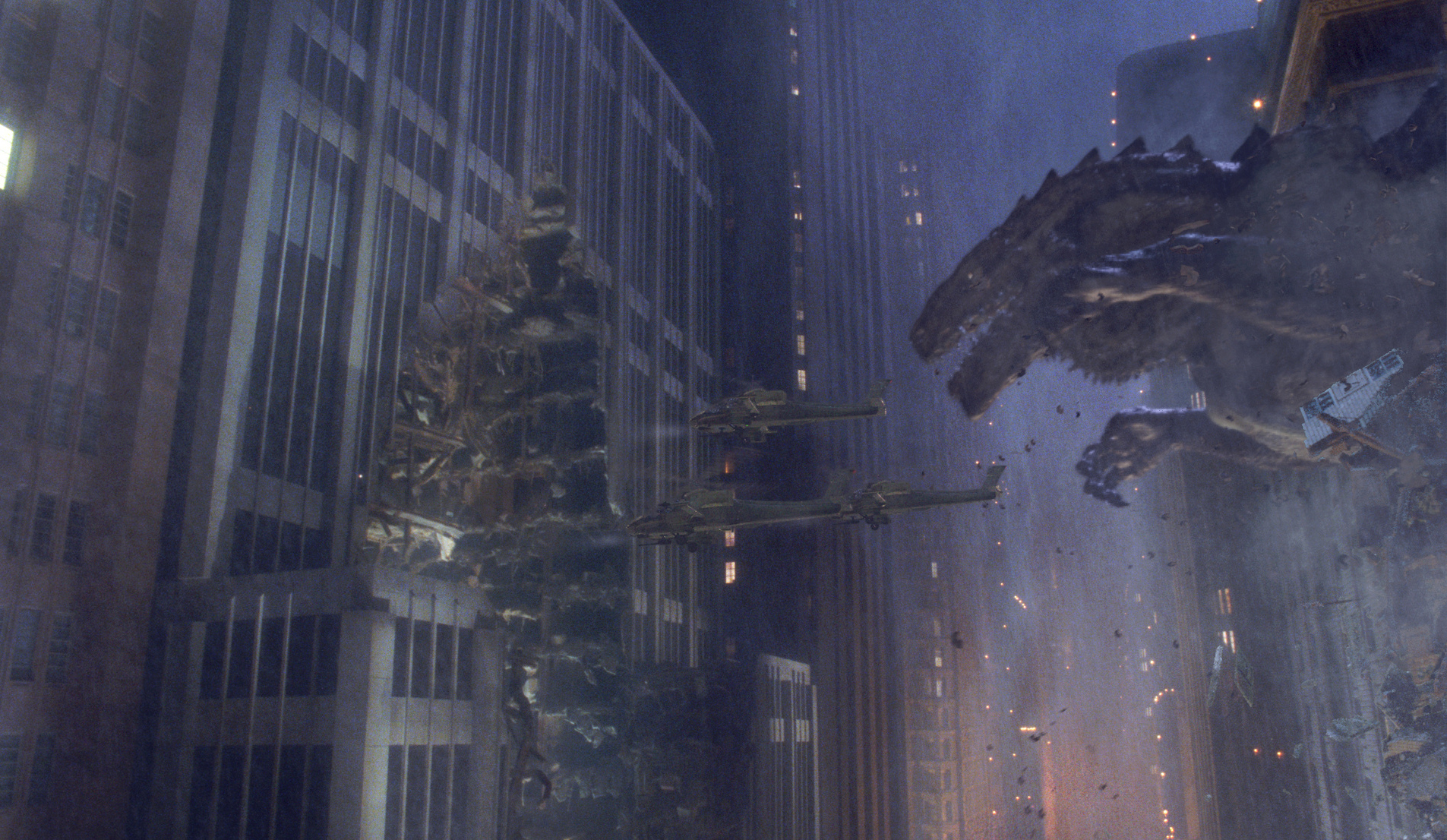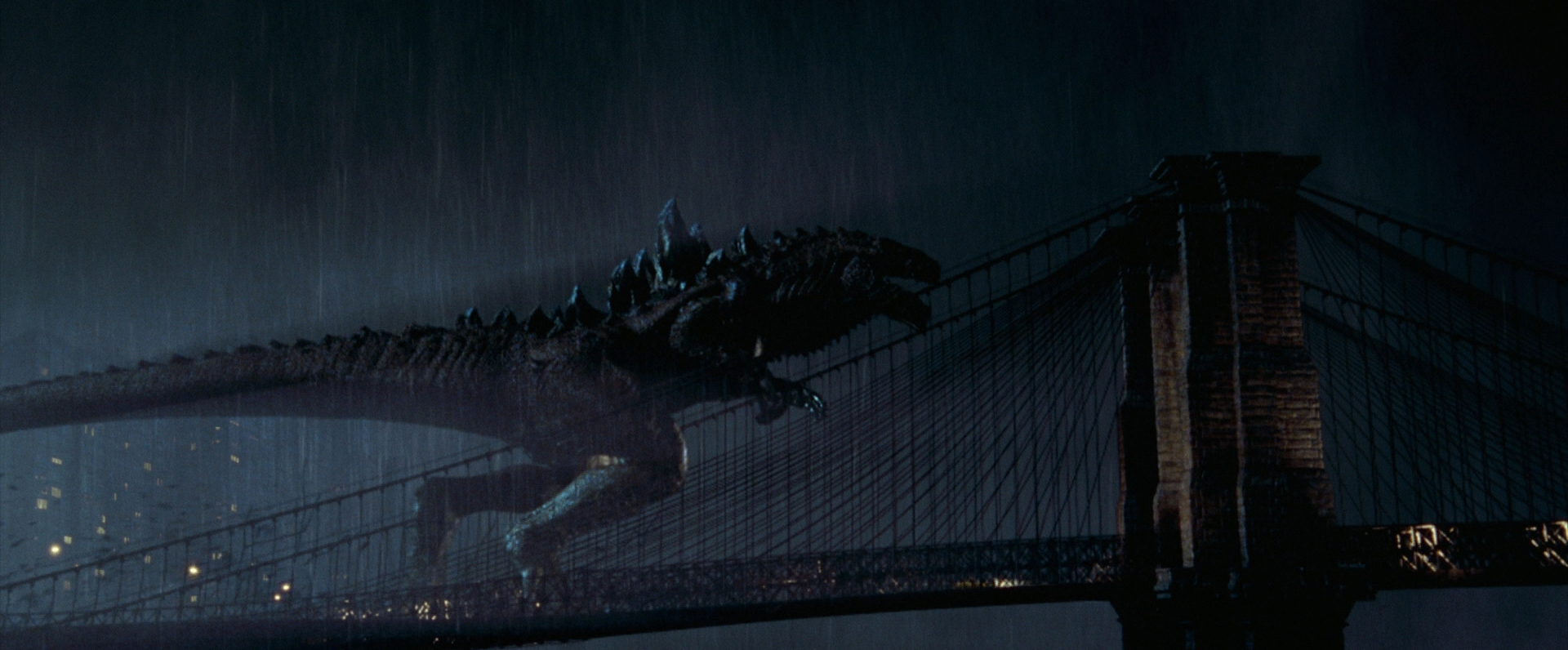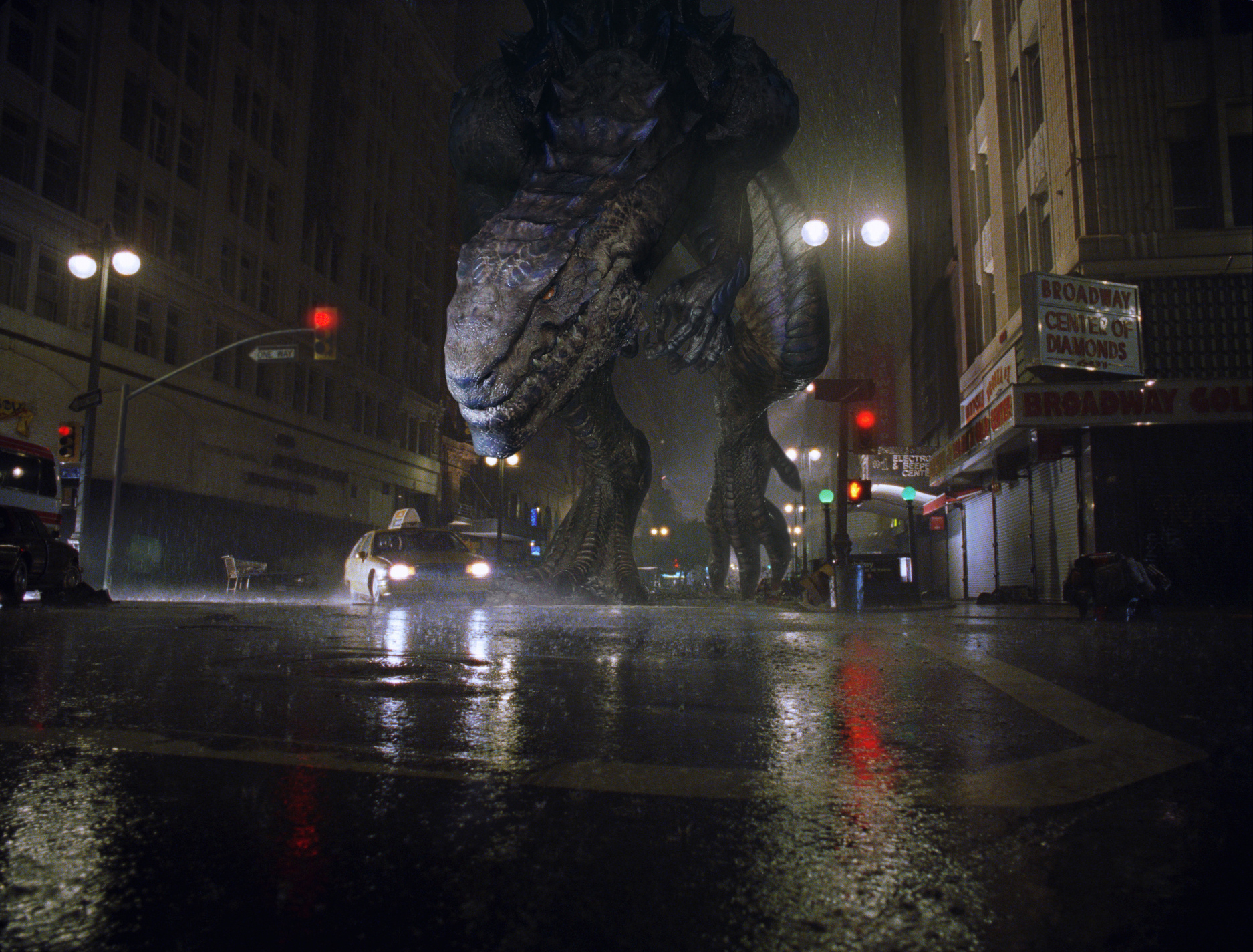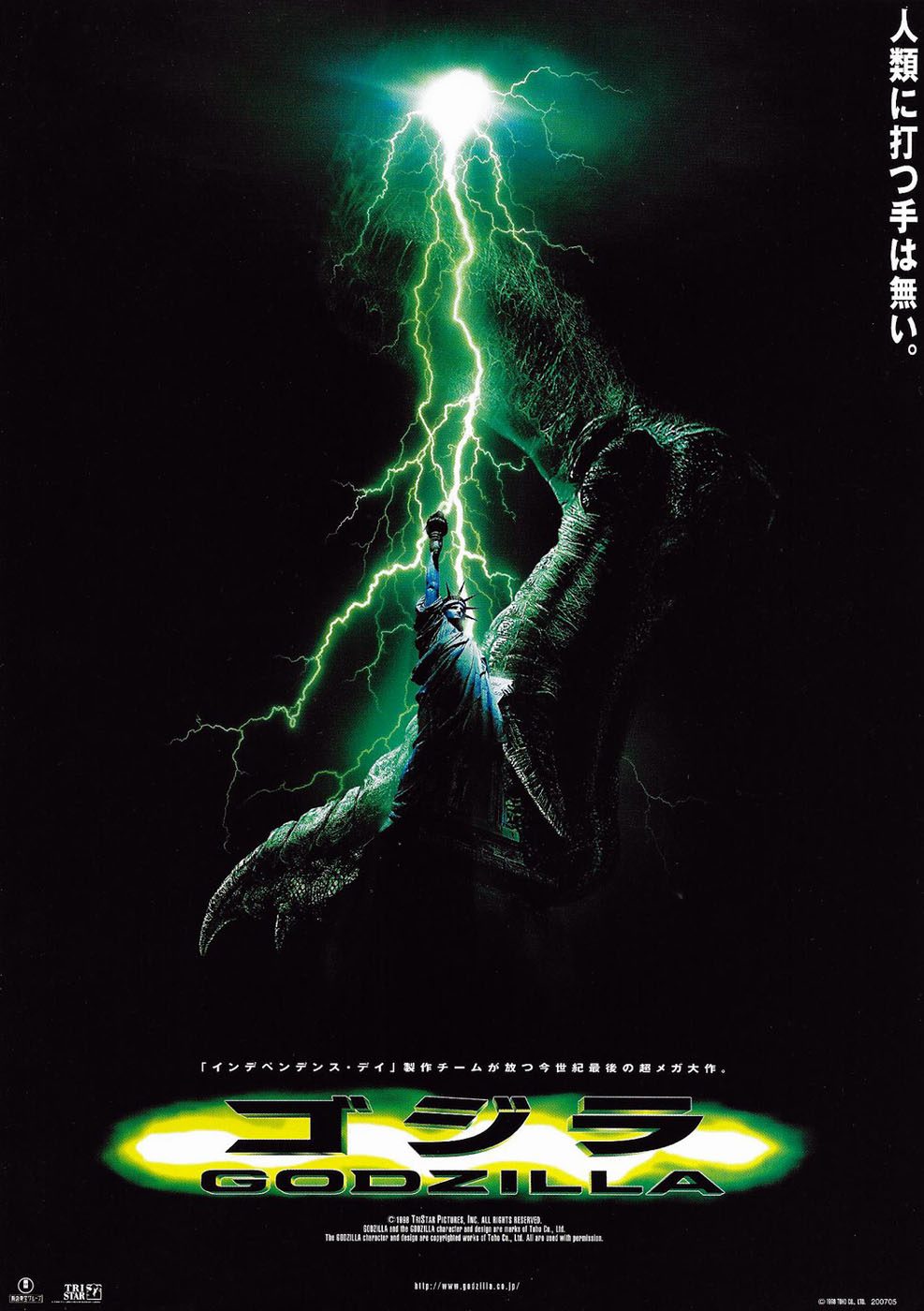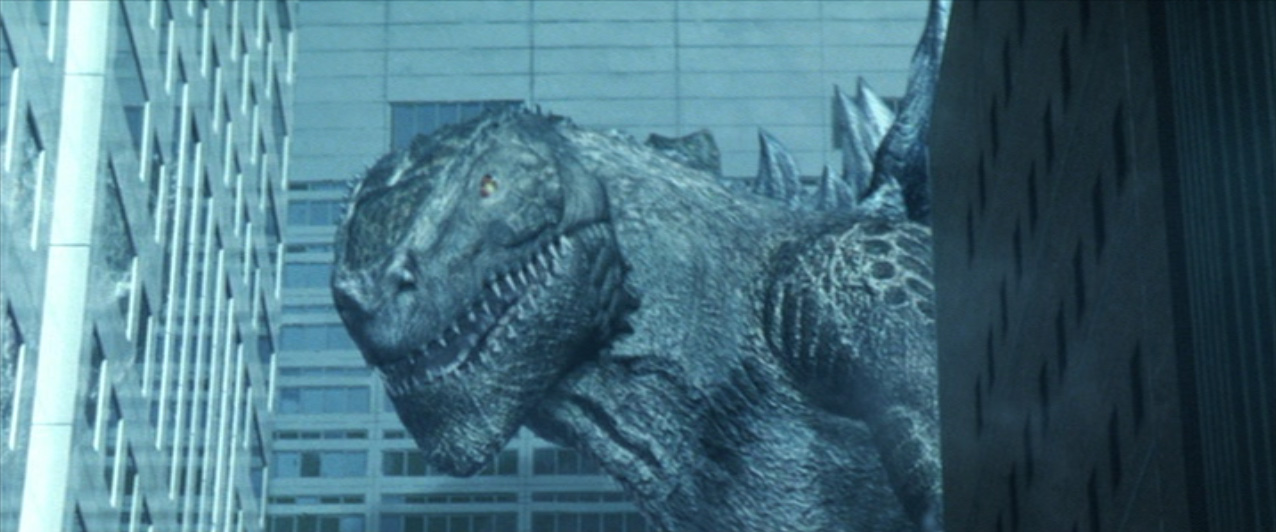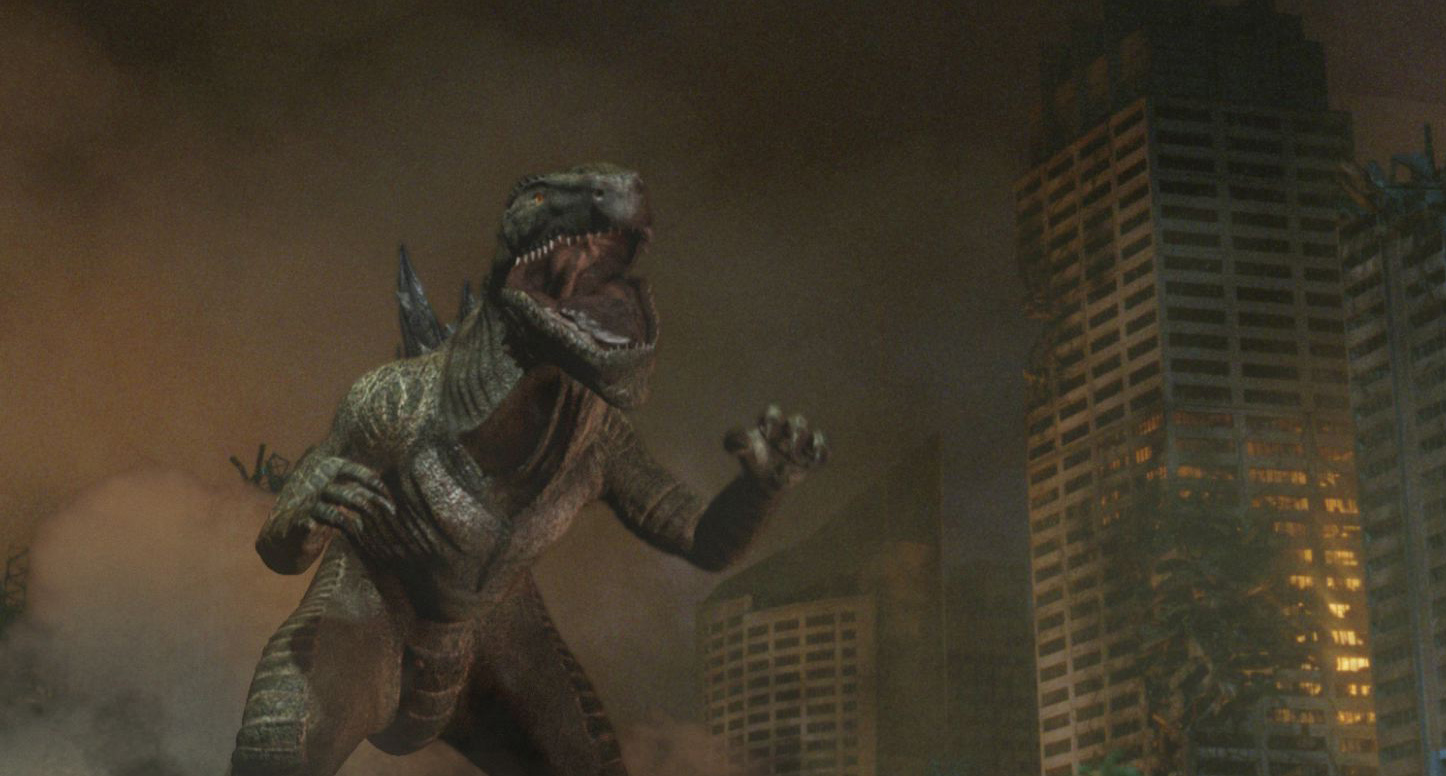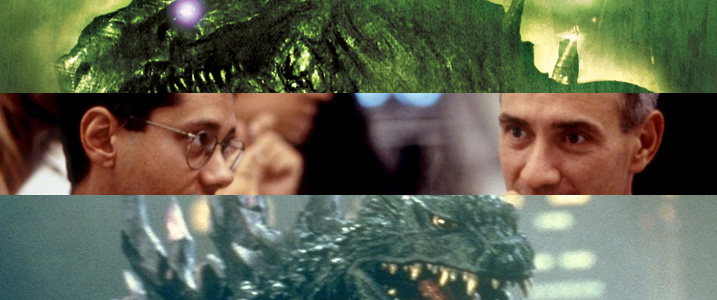 After passing on Jan De Bont`s version of GODZILLA, TriStar turned to Dean Devlin and Roland Emmerich with disastrous results. © 1998 TriStar Pictures, Inc./ Toho Co., Ltd. © 1999 Toho Co., Ltd.
After passing on Jan De Bont`s version of GODZILLA, TriStar turned to Dean Devlin and Roland Emmerich with disastrous results. © 1998 TriStar Pictures, Inc./ Toho Co., Ltd. © 1999 Toho Co., Ltd.
The Rise, Fall and Aftermath of Roland Emmerich and Dean Devlin`s GODZILLA
Author: Keith Aiken
Special Thanks to: Please See ACKNOWLEDGEMENTS in Part 1
A SCIFI JAPAN EXCLUSIVE
- FACE TO FACE WITH THE MISSING LINKS
- ACKNOWLEDGEMENTS
- ORIGINS
- DEVELOPING THE STORY
- THE SCREENPLAY
- DIRECTOR HUNT
- THE FIRST FX TEST
- JAN De BONT
- PRE-PRODUCTION BEGINS
- CONCEPTUAL DESIGN, ROUND ONE: GOJIRA PRODUCTIONS and STAN WINSTON
- STORYBOARDS
- DIGITAL EFFECTS
- CONCEPTUAL DESIGN, ROUND TWO: WINSTON STUDIO
- FINAL PREPARATIONS: CASTING plus MINIATURE and PRACTICAL EFFECTS
- THINGS FALL APART
Part 4
RETRENCHMENT
"To realize they had embarked on a screenplay entirely composed of problems, without anybody pointing this out, seemed amazing to me." --–GODZILLA rewrite screenwriter Don Macpherson
"We are going to make GODZILLA," an unnamed TriStar rep told Variety in December 1994. "We`re going to reconceive it so it won`t be over $100 million. Anything over $100 million is too much."1
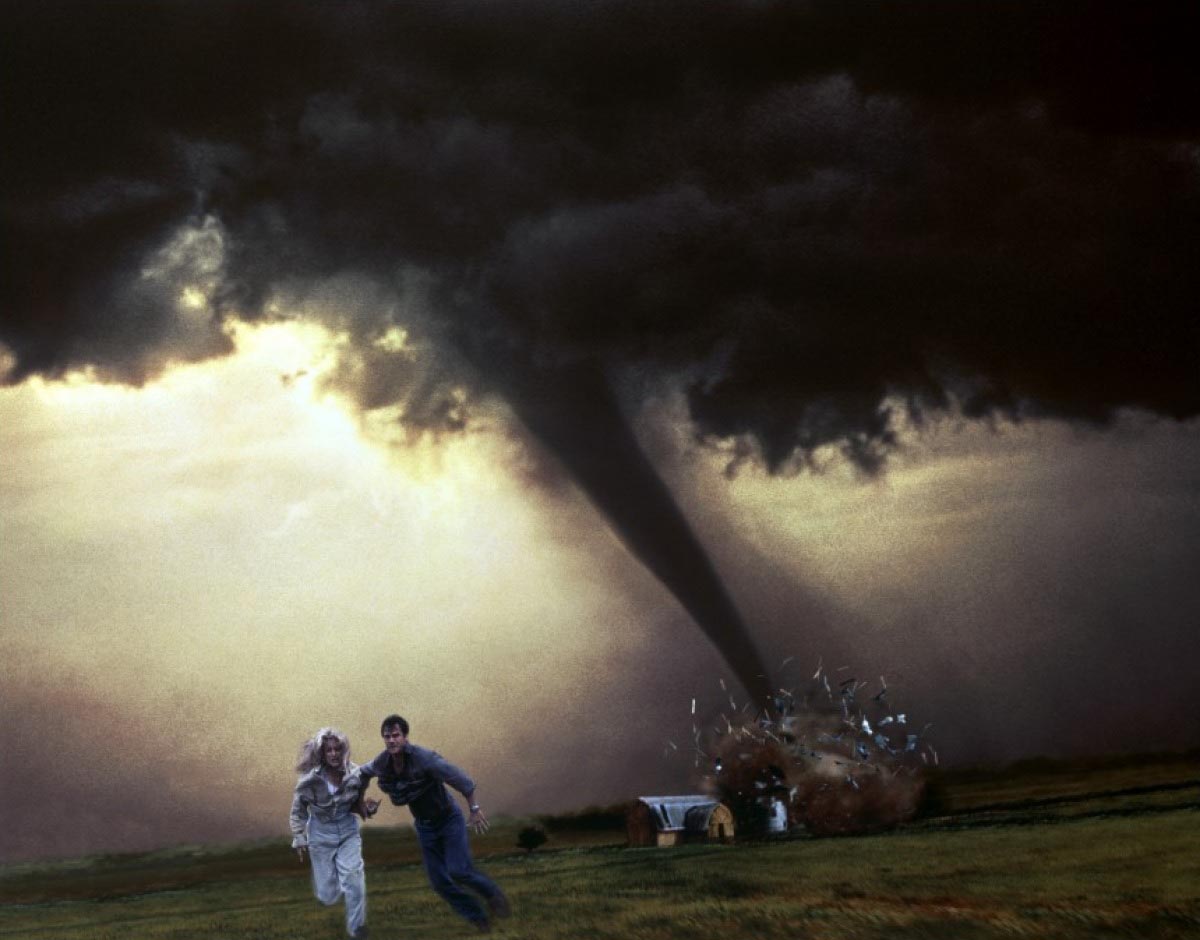 Jan De Bont moved on to direct the box office hit TWISTER. © 1996 Warner Bros and Universal Pictures
Jan De Bont moved on to direct the box office hit TWISTER. © 1996 Warner Bros and Universal PicturesNo longer attached to GODZILLA, Jan De Bont wasted little time in lining up his next assignment. In the last week of January 1995, he signed to direct TWISTER for an upfront fee of $3 million plus a percentage of the film`s merchandising. "It occurred to me that a twister is a little like Godzilla," said the director. "You never know if it`s going to touch down here or there."2
Digital Domain was contracted to provide visual effects for GODZILLA, but had to wait while Sony Pictures retooled the project. "The studio is now rewriting GODZILLA to try to reduce the budget," said James Cameron. "I was involved on a day-to-day basis on the biggest effects contract in history on that film. It`ll be interesting to see what the studio comes back with after rewriting the script. We`ve given them all of our input on how to maximize the bang for their buck. I was front-and-center ready, willing and able to play as creative a role as they wanted me to play to reconceptualize the visuals so that they were manageable from a budget standpoint."3
Henry Saperstein, meanwhile, continued to push for a low budget, traditional FX approach to GODZILLA with minimal digital effects. "They’ve been revising the script to pare the budget down to something that is more workable," he declared. "That`s a joke in itself: is $80 million better, or $70 million? What happens is that you get caught up talking in these boxcar numbers and suddenly someone says, `I just saved $30 million on the Godzilla movie,` and somebody else says, `that`s like we earned $30 million.` The trouble is, you never see a quarter in your pocket. But the budget has now been pared to $100 million. They cut $30 million out of it, and I am told out of Culver City that their goal was to get it down to about $75 million to make it a viable project." "I say to you, $70 million? Come on, we never made one for more than $7 or $8 million, and we did okay. It boggles my mind. I don`t want to make high tech movies like JUDGE DREDD or JOHNNY MNEMONIC, that die in one day. They`re very slick, but everybody sits there and there`s no entertainment. I like that Godzilla is corny and hokey, and he dies every so often and he comes back to save the day again."4
Ted Elliott and Terry Rossio completed their final GODZILLA rewrites in the spring of 1995. "Technically we never left the project," said Rossio. "A screenwriter signs a contract with a series of steps. We executed all of our steps, fulfilled our obligation, and then we were done. At any point they could have exercised optional steps, they just didn`t." He expected the next director, whoever that might be, would choose his own writers for the project.
But Sony decided not to wait on a new director, opting instead to hire British screenwriter Don Macpherson to do a fresh rewrite of the Elliott/Rossio screenplay. A former journalist with credits at Screen International, Time Out, City Limits, The Face and The Sunday Times, Macpherson had written the BBC TV miniseries THE DARK ANGEL (1989) starring Peter O’Toole and received a great deal of positive buzz for his screenplay based on Henry Fielding`s 18th century novel Jonathan Wild which had been optioned by Jodie Foster`s Egg Productions. Based on the interest in JONATHAN WILD, he was tapped to do scripts for Terry Gilliam`s A TALE OF TWO CITIES and Tim Burton`s FRANKENSTEIN for Warner Bros.
Macpherson also did rewrites for ALIEN 3, the feature film debut of David Fincher (who, coincidentally, had directed the Rolling Stones music video that had so impressed Jan De Bont and others on the GODZILLA crew). The third ALIEN film had been mired in development hell for years, going through multiple directors and screenplays. By the time Fincher was signed, 20th Century Fox already had the movie`s release date locked, sets were being built, and there was still no final script. Regardless, the studio demanded that the director make their deadline, even as they second-guessed his decisions and offered daily changes to the story. Don Macpherson was brought in to work directly with David Fincher revising the ALIEN 3 screenplay as the film was being shot. His efforts helped get the film done on schedule, and word began to spread that Macpherson could deliver quality scripts that also catered to studio concerns. "I had done screenplays which were smart and had both character and action. Apparently, that is a rare combination."
These qualities led TriStar to want Macpherson for GODZILLA. "I was working on a very different project, POSSESSION, from a literary novel by A.S. Byatt at Warners. My agent David Lonner at CAA called with the proposal to work on GODZILLA. I was thrilled and immediately accepted," he revealed. "I traveled to LA regularly and was working on projects for the studios, including Warners. But I was living and working in London when I was offered the job. That was a strength, since I was unaware of and unaffected by the current Hollywood flavours of soup available in all the restaurants. So I always approached it from the outside: essentially from what was right for the movie. I didn’t feel I had to please anyone. But I had been a movie critic for Time Out magazine in London so I knew and respected the original Godzilla movies as a fan. That wasn’t a position I felt others in LA necessarily shared."
"I was a big fan of the Toho movie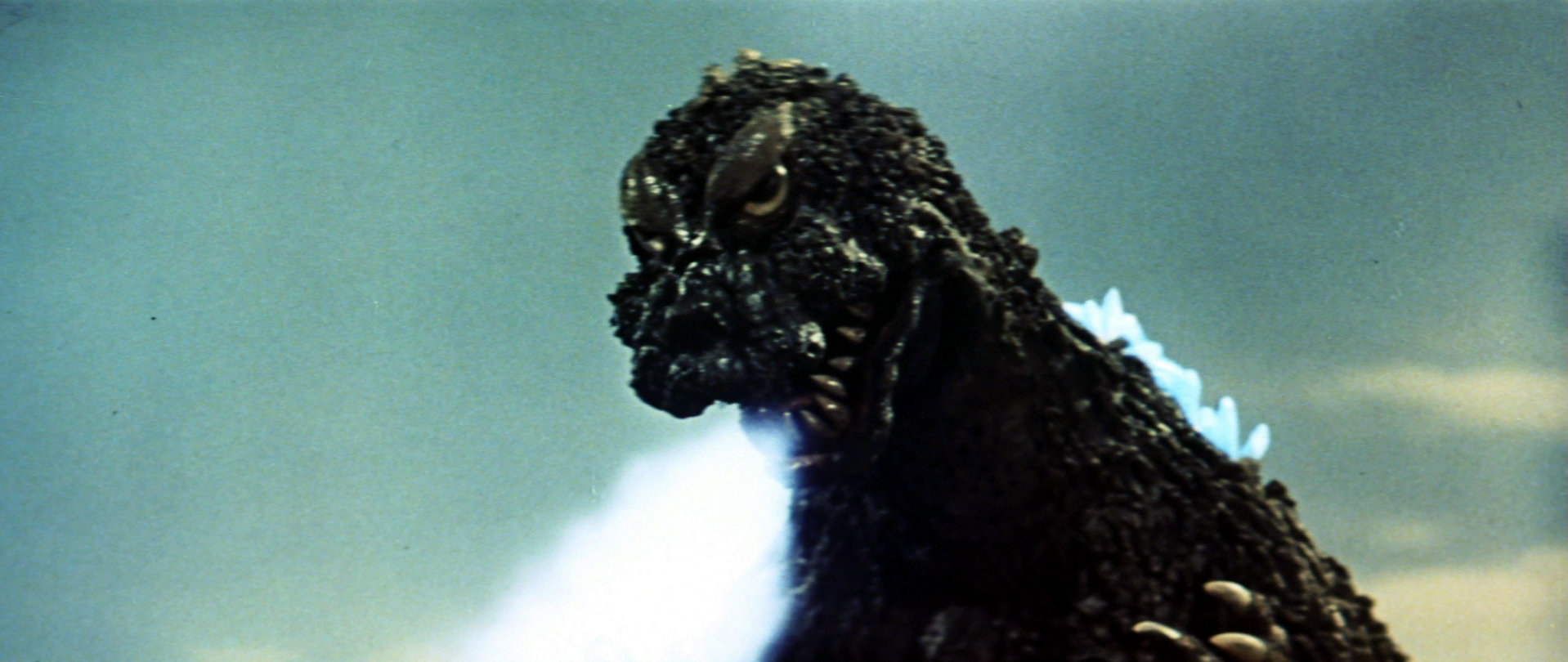 Macpherson was a fan of Toho`s Godzilla movies. © 1964 Toho Co., Ltd.s. I had watched them in London at repertory theatres. I thought they were pop classics and dealt with emotions and aspects of morality and revenge which were difficult to deal with in any other way -- basically the post-war confusion, anger and remorse of a Japanese society which had been taken over by America. I realized I couldn`t get quite so ambitious in a big US popcorn movie, but I understood the purely cinematic way of storytelling of the earlier movies. The SFX were of their time, but the magical world they conjured up was fabulous. I liked the dreamlike, or nightmarish, quality of the movies, even though they were seen as camp or kitsch. But I always respected their pulp intensity, which had always stayed with me."
Macpherson was a fan of Toho`s Godzilla movies. © 1964 Toho Co., Ltd.s. I had watched them in London at repertory theatres. I thought they were pop classics and dealt with emotions and aspects of morality and revenge which were difficult to deal with in any other way -- basically the post-war confusion, anger and remorse of a Japanese society which had been taken over by America. I realized I couldn`t get quite so ambitious in a big US popcorn movie, but I understood the purely cinematic way of storytelling of the earlier movies. The SFX were of their time, but the magical world they conjured up was fabulous. I liked the dreamlike, or nightmarish, quality of the movies, even though they were seen as camp or kitsch. But I always respected their pulp intensity, which had always stayed with me."
Macpherson soon met with TriStar president Marc Platt at Sony Pictures to discuss the project. "I got the impression that there was a lot of division over the course taken: a lot of anxieties specifically over the budget," he recalled. "There was a big disagreement between the director Jan De Bont and the studio. The problem was how to make the script for a budget. This was at a time when digital effects were much more expensive, but also more time-consuming than today. They were also much less realistic and less effective. So everything was a big gamble and people were getting nervous," he related. "Basically the budget for the original script was something like $120 million -- already much too expensive for what the studio saw as basically a monster movie. De Bont had done tests and was insisting that they go entirely digital with the effects. The problem was that, in this version of the movie, it was ALL effects. Godzilla was in virtually every scene. So everything was an SFX scene. The figures came in for a revised version at something like $200m -- way too high. Possibly this was a slightly political estimate to leave in enough slack for what was basically unknown territory. Anyway, they wanted ideally to get the budget down to about $80m, still very high for that period. But I think people were also nervous about the monster -- and De Bont -- running amok. If they budgeted at $200m, then what would happen if it went over-budget?"
"I was brought in because I could do action plus character, and had a reputation for thinking `outside the box`. Basically I assume because the studio thought I could save them money, but in a clever way. They don`t hire you because you`re an intellectual, but they like someone who can justify their thinking in movie terms."
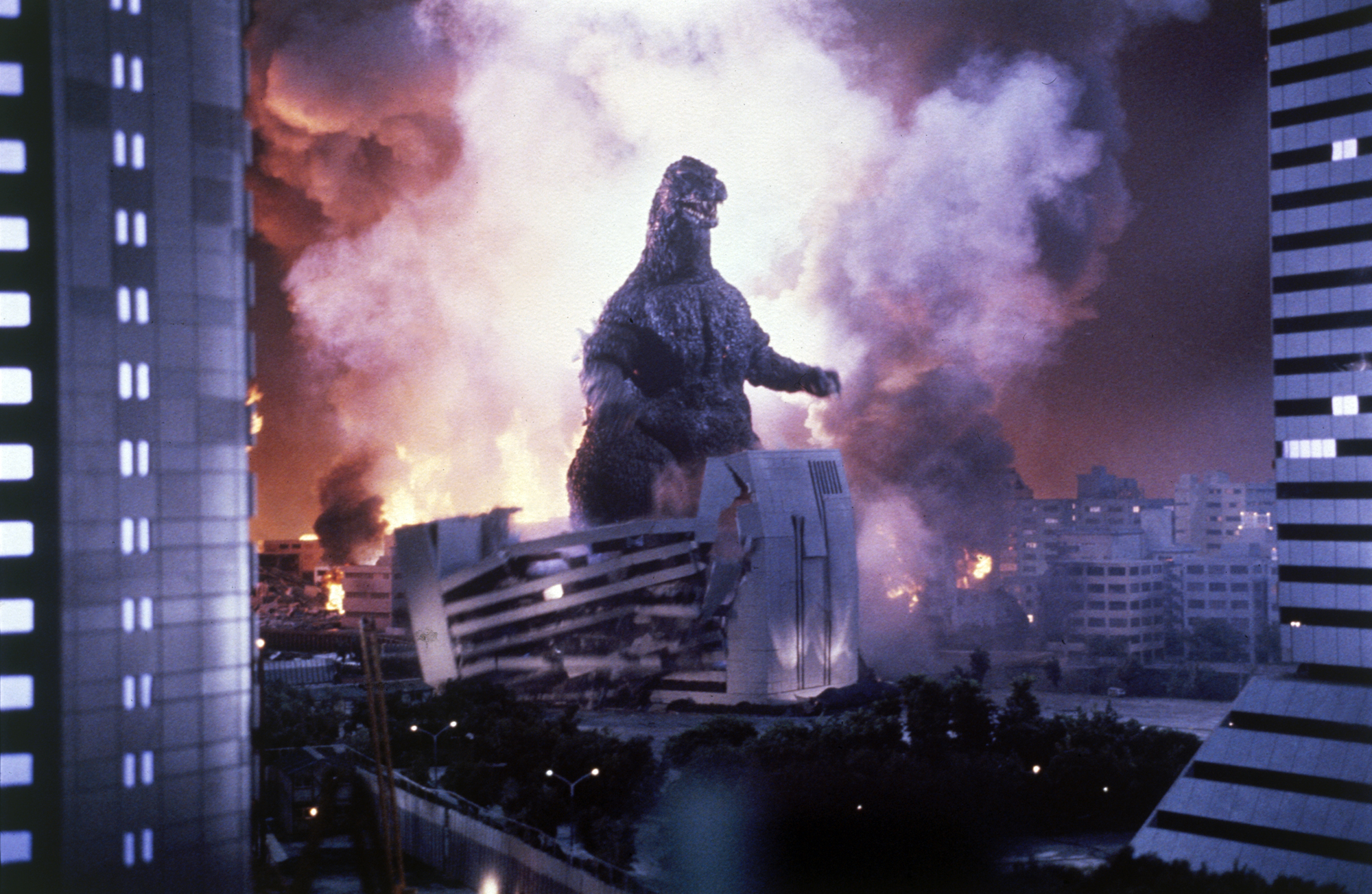 TriStar felt that trying to copy the large scale destruction displayed in the Japanese Godzilla movies was driving up the budget of their own film. © 1989 Toho Co., Ltd.
TriStar felt that trying to copy the large scale destruction displayed in the Japanese Godzilla movies was driving up the budget of their own film. © 1989 Toho Co., Ltd."I met with Marc Platt and -- I think -- one of the studio’s budget heads. But I was always surprised at the separation in the studio between `creative` and `money`... it seemed that nobody could think round these two obviously related boxes. The creative and industrial sides literally did not speak to each other. Normally that’s quite a wise thing, but in this case it had literally become a dialogue of the deaf. I suppose it helped that I could see both sides, but essentially my approach was more creative rather than just technical."
"Anyway, I had no problem asking about the budget, so I asked for a meeting with production to work out what scenes were making it so expensive. I think this was regarded as odd from a writer, but I got my wish. I thought it was nuts not knowing what were the most expensive types of scenes before I started a rewrite so I asked straight away what were the main budget problems. You have to remember the studio already has a script with a giant monster, Godzilla, emerging from the sea and tearing down whole cities in complete mayhem. That was the whole idea of Godzilla, right? The production people said there were three main problems: 1) the size of Godzilla -- big was much more difficult and costly than small; 2) Godzilla`s interaction with water was also difficult and costly; 3) Godzilla`s `interaction with masonry` was also difficult and costly." "So in other words, their main problems were with exactly the main identifying principles of Godzilla in the original movies and the new screenplay! Basically, he`s huge and he comes out of the sea and destroys buildings in a 2 hour orgy of destruction. I was shocked. To realize they had embarked on a screenplay entirely composed of problems, without anybody pointing this out, seemed amazing to me. It still does -- but, hey, that`s Hollywood..."
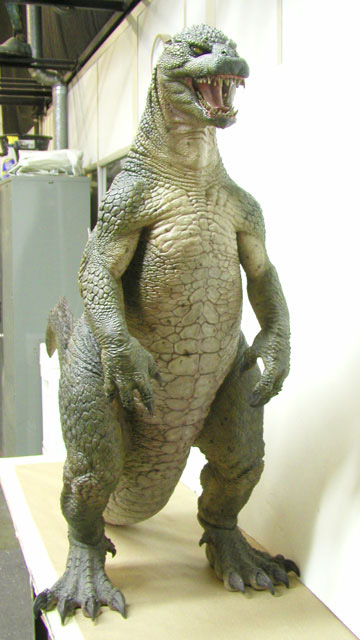 Macpherson saw some of TriStar`s Godzilla designs but believed they would evolve based on budgetary demands. Photo courtesy of Paul Mejias. © Stan Winston Studio © 1994 Sony Pictures Entertainment/ Toho Co., Ltd.
Macpherson saw some of TriStar`s Godzilla designs but believed they would evolve based on budgetary demands. Photo courtesy of Paul Mejias. © Stan Winston Studio © 1994 Sony Pictures Entertainment/ Toho Co., Ltd.Macpherson was shown a few examples of the concept art and storyboards created for De Bont`s version, but they didn`t have much of an impact on his approach to the material. "The creature design would vary with the budget decisions so I just kept the original in mind and used that," he explained. "People get obsessed with minutiae of the monster`s appearance, but I wasn`t like that." But there was something he saw at the studio that did stick with him. "I remember in the TriStar building seeing a white board with the release dates of next summer`s movies. It was terrifying. Basically, you saw the crowded summer of titles your movie was going up against. A shift of a release date meant that you`d blinked. So it was all about confidence, fear, gambling... building a $200m juggernaut to go out into the world and fight for survival."
"So you can see how the Godzilla legend appeals to the studio executives: they`re misunderstood, they`re angry, they feel persecuted, they want to destroy stuff. For an audience, it`s a kind of giddy fantasy, but for the executives it`s a daily reality. Anyway, armed with the budget calculations, I was able to work out a way of attacking the problem and, hopefully, coming up with some movie solutions which would improve and give the project more chance of getting made."
"The balance between studio and creatives can be like a bloodthirsty boxing match, a tactical sumo wrestling round, a refined chess game, or a delicate French court like Louis XIV in which the king is surrounded by ‘yes’ men and power is indulged irresponsibly until the king’s head is eventually cut off. At the time I worked on GODZILLA, the studios were vainly trying to turn themselves from bastions of court-like personality-led power into more Japanese -- or what they thought were Japanese -- systems of rational self-interest, group and committee work, and a harmonious outcome with profits for all."
"Of course, real life didn’t work out like that. GODZILLA got caught up in this transition and became a project in which the sort of directors that the studio ‘wanted` to recruit were exactly the ones that this process despised; they said they wanted strong, creative directors. But they wanted them as a kind of ‘badge’ of creative excitement and had no intention of allowing them their freedom. So as a result, all the ‘hot’ directors had turned the project down. They instinctively knew what the job entailed and were rightly extremely wary."
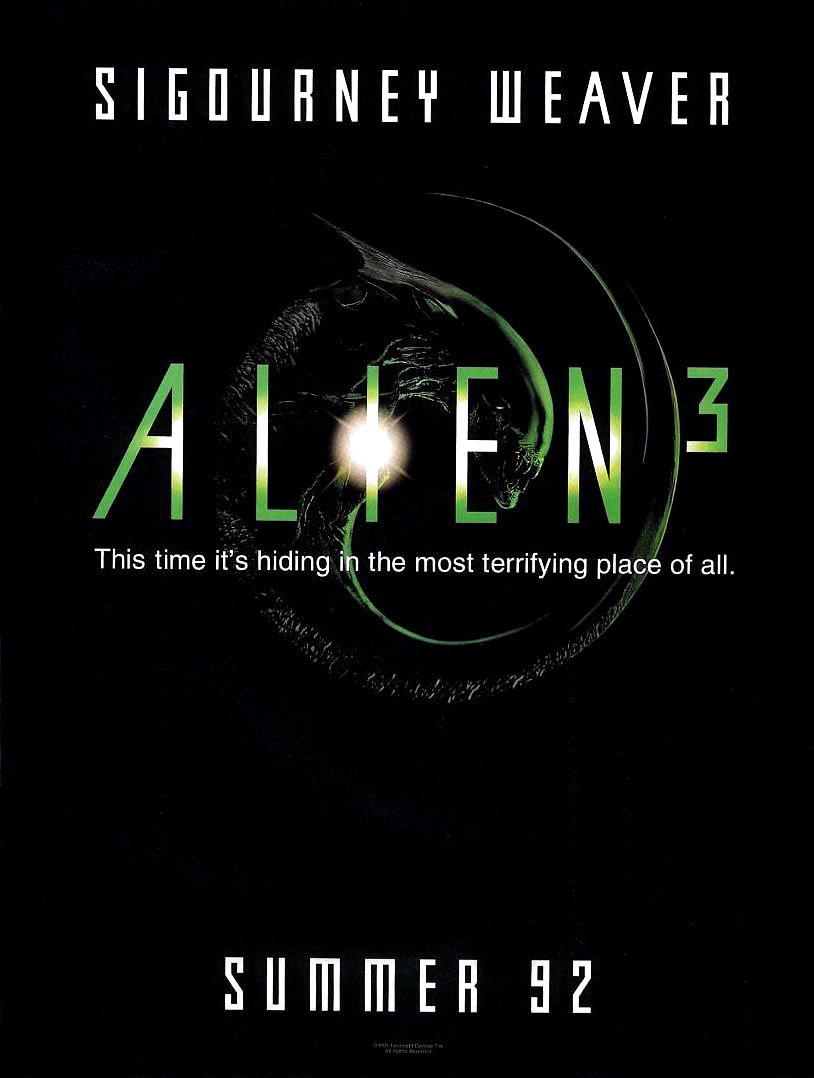 Macpherson had done rewrites for ALIEN 3 while the movie was being filmed. © 1992 Twentieth Century Fox Film Corporation
Macpherson had done rewrites for ALIEN 3 while the movie was being filmed. © 1992 Twentieth Century Fox Film Corporation"In a production environment, that could end up badly. For example, before GODZILLA I had worked with David Fincher during production on the set of ALIEN 3 at Pinewood. The producers and writers had all fallen out, and the studio was very down on Fincher, who was temperamentally against satisfying any studio demands. They tried to f**k him over, he fought back, he won most of the creative battles, he did a terrific job, even though the movie didn’t do well, now he’s respected as a terrific Hollywood director -- but he didn’t work again on big studio projects for a number of years. I saw David on the set of SE7EN, and he was still ‘out of the loop’ back then. No big studio would hire him because he was ’trouble`."
"On these big projects -- and GODZILLA was a huge project -- the tension between studio and creatives is difficult. It’s a constant anxiety which can drive projects into the ditch. I think the original Elliott/Rossio script for GODZILLA was terrific, but the studio had got greedy -- and the writers had given in too much. The screenplay was a strong but overly Americanized take on the Godzilla legend. It took away the very Japanese element of post-war nuclear politics and left Godzilla as a threat to America rather than the whole world, with a kind of moral dimension of regret and awe. That neglected the poetic aspect of fear and wonder from the original Toho movies, and the idea of a prior ’sin’ which had caused the mutation and revenge of Godzilla."
"It was great on imagining the reality of a monster`s attack in America, the tension between the government desire for secrecy and the sudden -- and very public -- shock of the monster`s appearance. But, like many studio-developed screenplays, it was short on character and had too many extra sequences which didn`t deliver. It then started to wander and meander, not good if you’re trying to go for a tight story and each extra sequence is $10-20 million. That sort of studio pressure on writers eventually breaks them -- never a good thing.”
"It was also so deft on the cute story and character beats that it felt very pre-fabricated, so that these moments pile on top of each other and erase their effectiveness. It got bogged down in the world of military bureaucracy -- which is very like a studio bureaucracy -- and so oddly became more about the process rather than the thrills. In the world of ALIEN, ‘the company’ is the studio while in GODZILLA the military is the studio. So all these big projects -- like the current crop of Marvel movies -- are really all about the people making them."
"My theory is that Hollywood doesn’t really ‘get’ Godzilla, and once you get the special FX department in on the script, the tail starts to wag the dog. The only way is to go with story, character, like all the old great stories. And even then, it’s a tough battle. The studio always wants more from the writers, and Elliott/Rossio are more talented at that than most. So as a result, you could say -- as the studio did say -- it had lost its way. The irony with all this is that it`s usually the studio itself which makes the writers lose their way, but that is another story."
"Also I thought the original script suffered from one central problem. I think it was De Bont`s idea to portray Godzilla basically as the Terminator; it was relentless, very much a Godzilla POV, so you neither identified with Godzilla nor with the scientists trying to protect the world. So from the beginning you were watching wholesale destruction and mayhem on a big scale. This was both expensive and -- more importantly -- wearying. Godzilla was on the rampage so it was all `look out, he`s a`coming!` That sounds exciting, and it was exciting... for a while. The problem was that by about the middle of the story, you had lost patience with the whole proposition of Godzilla. What`s the encore? There was nowhere left to go; you had `monster fatigue`. Plus the monster didn`t develop over the course of the story. So I thought the audience would be fatigued and ready for something new -- and the new thing wasn`t delivered. The debate was how best to resolve that, while preserving some of the great sequences and moments Elliott/Rossio had constructed."
 Macpherson thought GODZILLA would benefit by employing the style of 1940s filmmaker Val Lewton, who effectively used sounds and lighting rather than expensive FX to tell his stories. © 1942 RKO Pictures
Macpherson thought GODZILLA would benefit by employing the style of 1940s filmmaker Val Lewton, who effectively used sounds and lighting rather than expensive FX to tell his stories. © 1942 RKO Pictures"So although the studios are often portrayed as mindless, they actually had a real problem: how do you portray Godzilla?" he asked. "My solution was a time-honoured technique, borrowed from the 1940s B-movie producer Val Lewton in his movies like CAT PEOPLE. Basically, it was the idea that a shadow or a sound could be more sinister than a monster glimpsed on screen. So the idea was to go from `Here`s Godzilla -- get out of the fu**king way` to `Where is Godzilla? Oh my god, I`m so scared what`ll happen if he shows`. It`s cheap and it`s effective. Also it allows you to spend more time with the humans on their character relationships, which you can pay off later. In that way you could build on anticipation and a kind of sensory world of sound and shadows, before finally revealing Godzilla in all his majesty. You could imagine it as building in a kind of foreplay before the reveal that could make the moment of release more pleasurable... I`m sure you get the point. In any case, as I recall, my bet was to reveal Godzilla fully only when he appears in San Francisco out of the water attacking the Golden Gate Bridge -- and even then to leave some items behind to reveal later."
"I cut out a lot of costly sequences, including a great sequence set in a tunnel going into New York as cars are trying to evacuate. Godzilla was stamping on the tunnel roof and people were trying to escape from their cars. Fantastic and really scary, but I thought it seemed to be like a 20 minute movie all on its own. I thought it didn`t add much to Godzilla`s powers and took away from the projected finale. Plus it was also going to be super expensive. I later discovered this sequence seemed to have been based on another script for Stallone called DAYLIGHT about an attack on a tunnel, so I don`t think I was wrong to cut it out. It had probably been put in as a `spoiler` to another studio, but in reality it only spoiled the Godzilla movie."
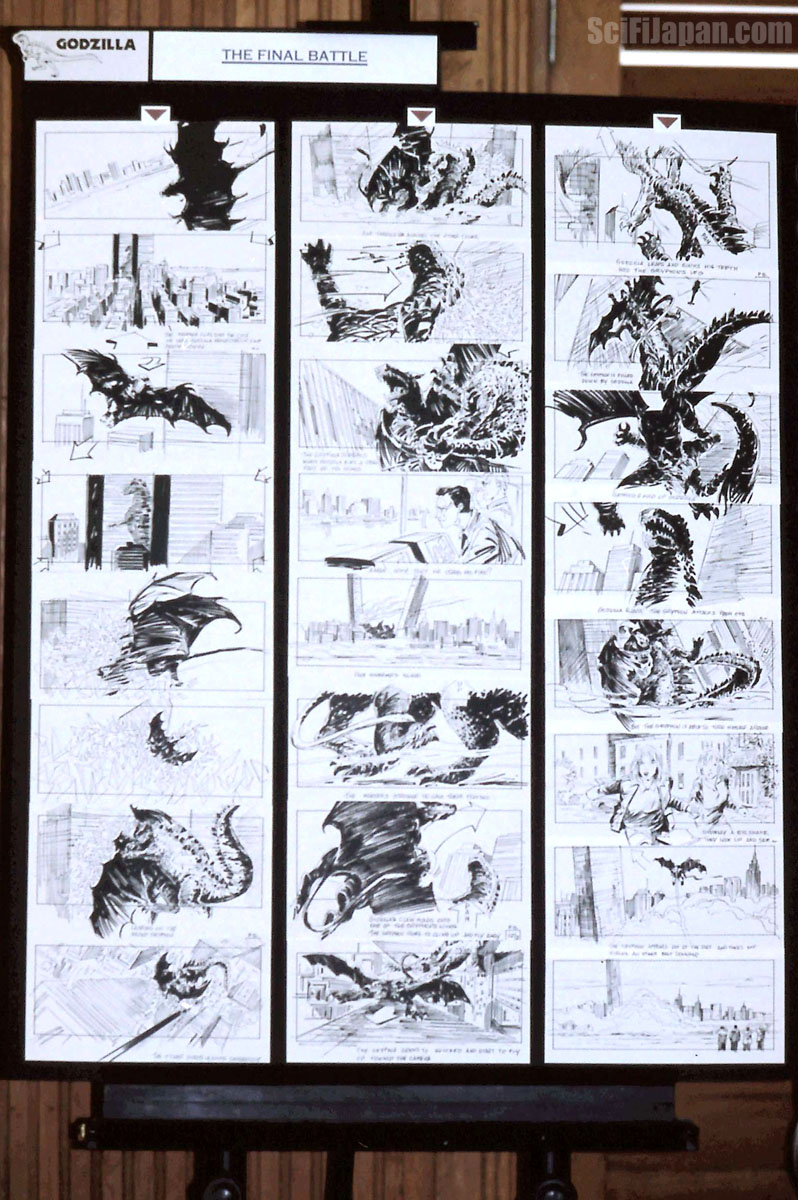 Display of storyboards for the NYC battle, produced during Jan De Bont`s time on the film. Photo courtesy of Jan De Bont. © 1994 Sony Pictures Entertainment/ Toho Co., Ltd.
Display of storyboards for the NYC battle, produced during Jan De Bont`s time on the film. Photo courtesy of Jan De Bont. © 1994 Sony Pictures Entertainment/ Toho Co., Ltd."So it was going to be very much `Where is Godzilla?`," Macpherson explained, unaware that his take on the character matched that of concept designer Ricardo Delgado... each used the same words to describe the monster: "I wanted to see him as a kind of destructive `id`, so his exact shape or form was never the most important thing..."
"I also redid much of Godzilla`s later attack on New York, resetting much of the action from the water onto dry land. I remember trying to set a sequence in the Dakota building, just going in on the detail of escaping from a monster. My main goal was to try and restore the tragic elements of the Godzilla story, at the same time as keeping the goal of him tearing up and destroying stuff as much as possible. For me Godzilla was always like a warning, a kind of wrathful spirit or demon at war with society, angry at being disturbed by a modern civilization which was out of joint."
"That`s the great opportunity of working on a pop classic for a big studio, you`re dealing with the most potent mythological characters ever. A lot of other writers think of this type of movie as schlock, but I`m the opposite: I think these are the heart and soul of cinema. It goes right back to the silent days of cinema, linking up between the real world and an imaginary world you build up as realistically as possible. I`m not sure we made it with GODZILLA, but that was always the goal."
The new script was submitted to Sony Pictures in May 1995. Describing the rewrite, Terry Rossio said, "The basic structural elements were still there, but were being written in such a way that the budget would come down. Part of that process involved emphasizing the human characters and their story a little more." But Rossio felt it missed the mark. "If there is one thing off about the draft I would say tone. You can always make changes or take a different approach, but especially on a Godzilla film, you have to get the tone right."
But the studio was happier with MacPherson`s work, keeping him on for additional drafts while they began shopping the script to potential directors beginning that June. "They showed it around to directors, but I wasn`t involved in the process," Macpherson acknowledged. "I believe David Fincher was enthusiastic and positive. He made a pitch to direct it, set in Chicago for some reason. I think the studio was intrigued, but dubious about going with Fincher`s ideas. You have to remember he was still seen as a risky director in those days. But I can only imagine what he could have done with it. He was also going to do a script of THE AVENGERS back then and did a Honda commercial as a test for some ideas. But they decided not to go down that road." Producer Cary Woods reported that he strongly wanted David Fincher to direct GODZILLA, but couldn`t convince the upper management at Sony Pictures to even take a meeting with the filmmaker.5 Woods and co-producer Robert Fried felt utterly discouraged by the studio`s attitude, while Chris Lee felt the best thing to do was step away from GODZILLA and wait for the right time to take a fresh approach.
Don Macpherson continued revising the screenplay, doing several drafts before Sony put GODZILLA on the back burner once again. "You don`t ever leave," he disclosed, echoing Terry Rossio. "You just discover the studio has moved on."
Fumio Tanaka, producer of Toho`s RETURN OF GODZILLA (ゴジラ, Gojira, 1984), believed GODZILLA was over at TriStar. "I don`t think the film will be made," he said. "It`s very difficult to create an interesting story that features Godzilla [without another monster to battle]. I`ve heard the production budget has been cut. I don`t think that there are many American filmmakers that would want to work on a Godzilla movie that lacked a large production budget."6
But the management at Toho were feeling a bit more optimistic about Godzilla`s future in America. To make way for the expected Sony film, the Japanese studio decided to end their Godzilla series with the 22nd installment, GODZILLA VS DESTOROYAH, in which the monster would suffer a fatal meltdown. "When Godzilla dies at the end of the first movie, a Japanese professor says there may be more than one Godzilla," explained DESTOROYAH producer Shogo Tomiyama. "This time, even though he dies, the one who comes back for TriStar could be a different Godzilla."7
THE REWRITE
"Gojira... I know that name." --GODZILLA rewrite by Don Macpherson
On May 31, 1995, Don Macpherson finished his first draft rewrite for GODZILLA. The following synopsis is taken from that draft...
An alien probe rises from the surface of Saturn on a trajectory for Earth, striking -- and destroying -- an American deep space satellite in its path. June 10, 1999, the Arctic: Junji, a young man, and his son Hiro are ice fishing when a red, blood-like fluid begins seeping up through the ice all around them. A fissure forms nearby, the crevasse filling with the strange liquid.
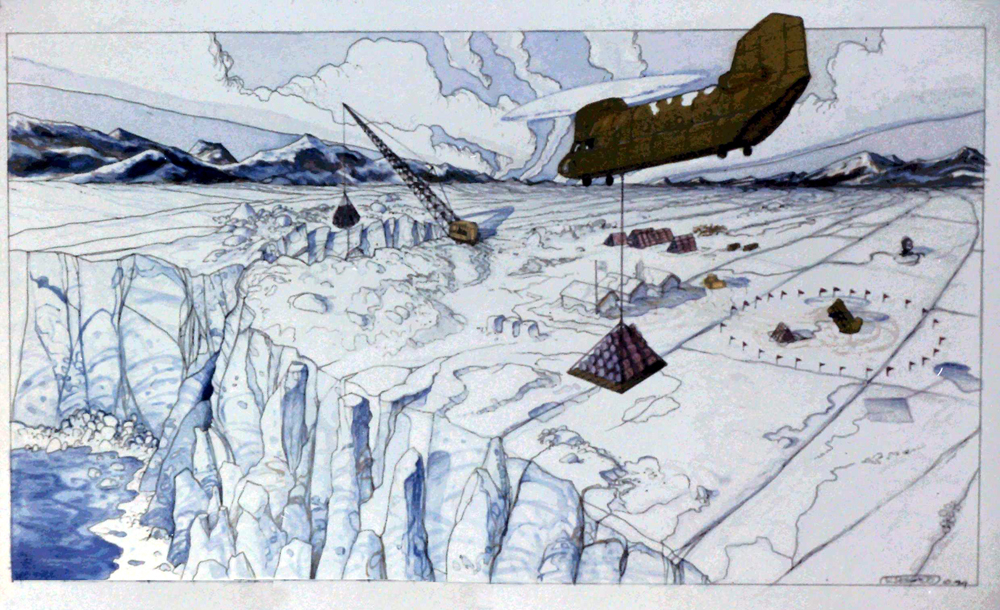 Art by Ricardo Delgado. Image courtesy of Jan De Bont. © 1994 Sony Pictures Entertainment/ Toho Co., Ltd.
Art by Ricardo Delgado. Image courtesy of Jan De Bont. © 1994 Sony Pictures Entertainment/ Toho Co., Ltd.June 15, 1999, San Francisco: In the middle of the night, Government scientists Richard and Jill Llewellyn are called into service, leaving their 15 year-old daughter Tina in the care of Jill`s younger sister. Two days later they arrive at the Arctic location, now an American scientific/military outpost where Junji and Hiro are being detained. Soldiers cart away drums full of the mysterious red liquid which, initial tests show, resembles an amniotic fluid. As Jill begins running additional tests on the liquid, Richard explores the underground fissure. He sees what at first appears to be a huge stalactite formation but, upon inspection, is actually the teeth of a huge creature imbedded in the sediment. Richard finds the head of the perfectly preserved creature -- a huge dinosaur -- and climbs atop its muzzle to look down the length of its 247-foot-long body. Suddenly, the beast opens one of its eyes... it’s alive!
A massive tremor strikes the outpost, upending Jill`s lab. Junji and Hiro try to reach her, but are separated as the compound bursts into flame and a massive form rises from underground. Jill sees two massive rows of teeth before blacking out. She briefly awakens on a stretcher aboard a helicopter with Pike, a NSC agent who repeatedly cracks his neck. Pike says that she is the sole survivor of an earthquake. As the helicopter flies off, soldiers go to work on the disaster site, bulldozing colossal footprints in the ice.
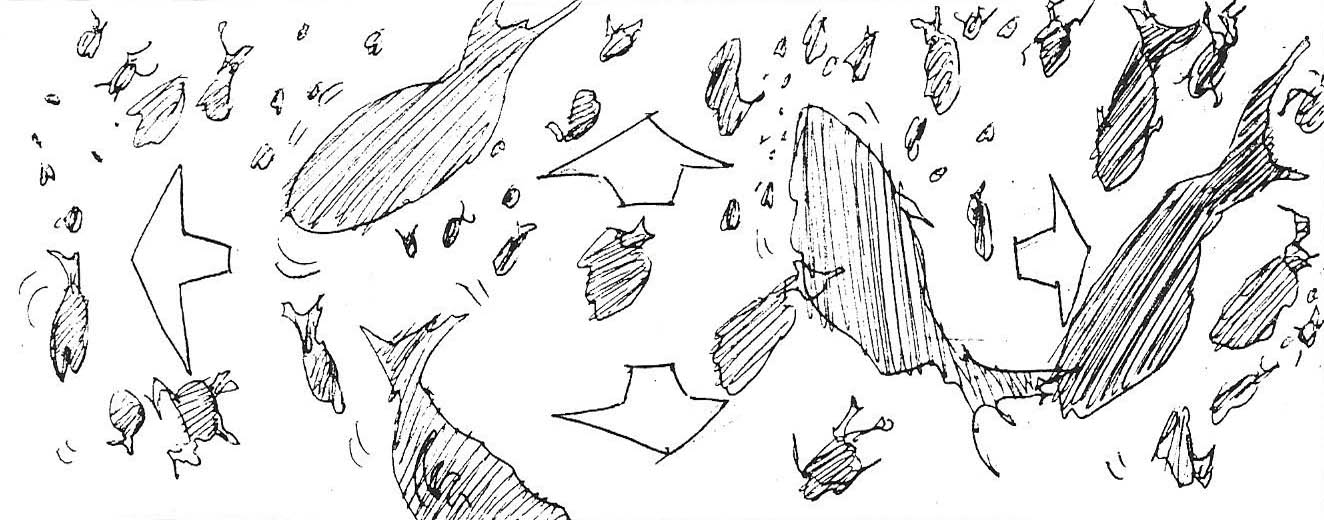 Fish rain from the sky. Image courtesy of Terry Rossio. © 1994 Sony Pictures Entertainment/ Toho Co., Ltd.
Fish rain from the sky. Image courtesy of Terry Rossio. © 1994 Sony Pictures Entertainment/ Toho Co., Ltd.Meanwhile, in rural Utah, the alien probe plunges into Lake Apopka, eerily raining fish and frogs on the nearby town of Traveller.
June 29, 1999, San Francisco: After Richard`s memorial service, Jill is visited by Aaron Vaught, a former student of Richard`s whose theories about dragons and dinosaurs have made him a best-selling author. Aaron reveals his suspicions that the outpost was destroyed -- not by an earthquake -- but by a giant creature. He also thinks other survivors of the disaster may be being held at the hospital where Jill was treated.
At the same time, the alien probe enters a cave opening at the bottom of Lake Apopka. Rising from water, the probe grabs dozens of bats and absorbs them into its own matter. The probe then forms dozens of “Probe Bats”, evil creatures standing 5 feet tall that sail out of the cave and into the night sky.
Aaron and Jill sneak into the Hawking Post-Trauma Care Unit and find Junji. Junji tells them the outpost was destroyed by Gojira, a legendary dragon that Aaron recognizes as Godzilla. The fisherman shows them his drawings... in one picture, Godzilla is locked in battle with a Gryphon. The discussion is interrupted by Pike. Jill demands answers, and Pike admits that he doesn`t know what they`re dealing with. After much wrangling, Pike agrees to take Jill, Aaron and Junji back to the Arctic crevasse in the hopes of determining what Godzilla is and where it came from.
June 30, 1999, the Arctic: The quartet discover that red-black amniotic fluid has been flowing from Godzilla’s "womb". As they search further, Aaron details some of the Godzilla legends, theorizing that the monster must have an adversary; an opponent he was meant to destroy. They enter a newly opened ice cave, which is lined with intricate organic formations, a strange remnant of an ancient civilization with advanced biotechnology. Suddenly, a microscopic alien object swoops down and burrows into Junji’s eye. He screams in shock and pain. Pike, Jill and Aaron rush him to the infirmary.
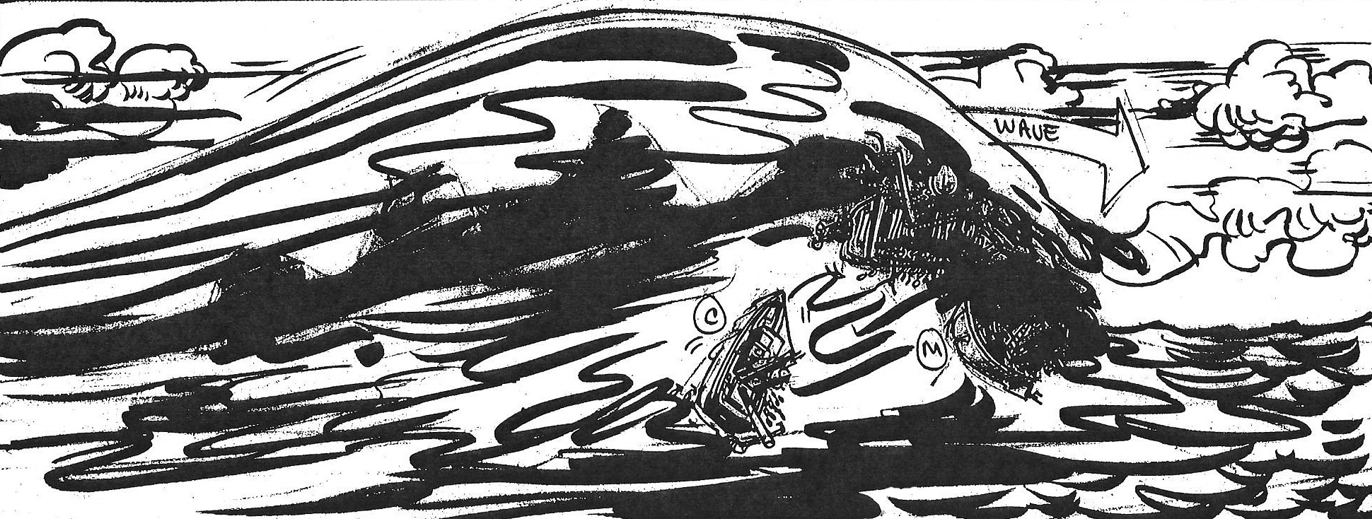 Three fishing boats are capsized by Godzilla`s wake. Image courtesy of Terry Rossio. © 1994 Sony Pictures Entertainment/ Toho Co., Ltd.
Three fishing boats are capsized by Godzilla`s wake. Image courtesy of Terry Rossio. © 1994 Sony Pictures Entertainment/ Toho Co., Ltd.Medics examine Junji and are horrified to discover the man`s collarbone and shoulder bones are shifting and distorting beneath his skin. Junji is medivacked aboard a C-130 loaded with the canisters of the mysterious red fluid.
In Utah, a herd of cows is slaughtered by the Probe Bats, their carcasses removed of limbs and organs. Survivalist Nelson Fleer spots the flying creatures as they return to their cave. The Probe Bats deliver pieces of their prey the alien probe, which assimilates the biological material.
In the Pacific Ocean, three fishing boats are capsized when Godzilla passes beneath at 40 knots, heading in the direction of San Francisco.
July 1, 1999: Pike brings Jill and Aaron to the Presidio, where a command post is set up. A submarine is sent to intercept Godzilla, but the monster easily destroys it. The military considers using a small nuclear bomb to stop Godzilla, but Aaron believes it won’t work. He concludes that the red fluid that encased Godzilla was not food, but actually a tranquilizer that kept the monster in hibernation. Barrels of the liquid are brought to San Francisco and a plan is concocted to stop Godzilla with it. Helicopters spray the surface of the water entering the bay with the fluid, and as Godzilla arrives, he swims right into the trap. He bolts upright, nearly blasting Jill`s helicopter out of the sky with his heat breath, but the scientist manages to spray the red fluid directly down the monster`s throat. Godzilla slowly comes ashore, then, roaring weakly, collapses on the south side of the Golden Gate bridge.
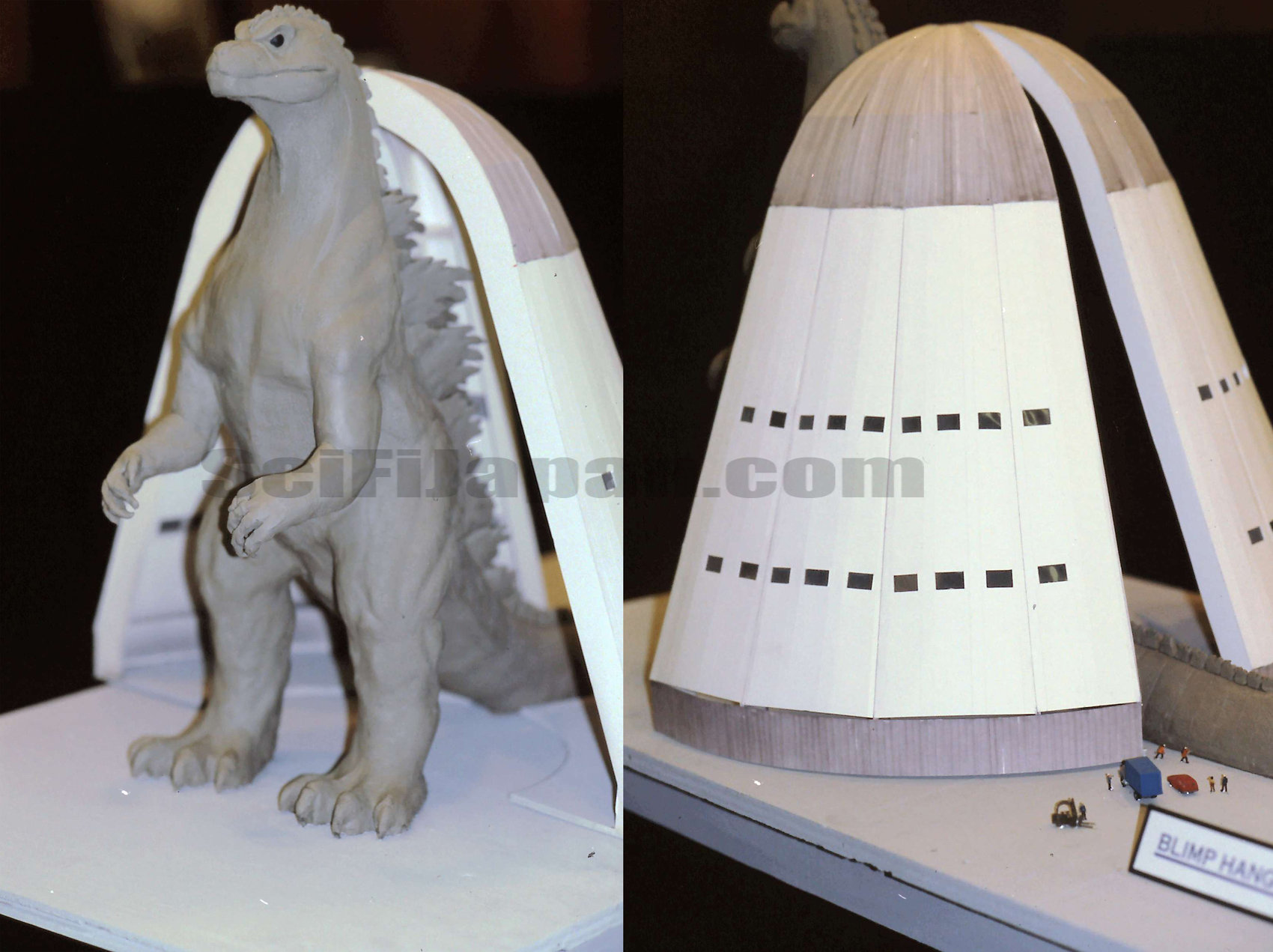 Model of Godzilla held captive in a blimp hangar. The location was changed to a large metal tank in Don Macpherson`s rewrite. Photo courtesy of Jan De Bont. © 1994 Sony Pictures Entertainment/ Toho Co., Ltd.
Model of Godzilla held captive in a blimp hangar. The location was changed to a large metal tank in Don Macpherson`s rewrite. Photo courtesy of Jan De Bont. © 1994 Sony Pictures Entertainment/ Toho Co., Ltd.Using six super-helicopters, the military transports Godzilla, suspended from cables, to a holding tank in Massachusetts. En route, the convoy passes Traveller, UT, where Nelson Fleer is about to marry his girlfriend, Rose. But as the ceremony get underway the church is attacked by Probe Bats, which fly off with several of the guests in tow.
July 3, 1999: Godzilla is stored in a huge tank at Fort Tuscarora, the tail sticking out one end. Aaron pushes for Godzilla to be studied while Jill insists that monster must be killed. They are joined by Tina who, wise beyond her years, says Godzilla is a force of nature and should be respected. Jill sends her daughter to Manhattan to stay at her sister`s for a while.
At a hospital on the base, Junji’s infection is consuming his internal organs, and has turned his face into a flat, eyeless surface. Whatever has invaded his body is taking over, and begins speaking through him. Before he dies, Junji tells Jill and Aaron about an alien race colonizing the universe by sending out probes that create a “doomsday beast” out of the local genetic material -- by the time the alien colonists arrive, the beast has already conquered the planet. An ancient, biotech Earth civilization guarded itself against these invaders by creating Godzilla out of dinosaur genes, placing him in suspended animation to awaken when the alien probe arrives and kill it before it can reproduce.
Aaron deduces that Godzilla was headed for the spot where the huge fireball landed, and convinces Jill to accompany him to Traveller. There, they are driven to Lake Apopka by Nelson Fleer. The three don diving gear and explore the lake bottom, and discover a tunnel that leads to a series of caves. Jill finds what first appear to be a giant paw and, upon further inspection proves to be attached to the Gryphon, a giant monster with the body of a cougar, wings of a bat, and a tongue of snakes, created by the alien probe out of the smaller creatures. The dormant monster is awakened when Aaron lights a flare to get a better view. The trio submerge and swim for safety, and the huge monster’s roar is heard behind them; when they reach the lake’s surface, all seems normal for a moment until the monster rises with a roar and takes to the air.
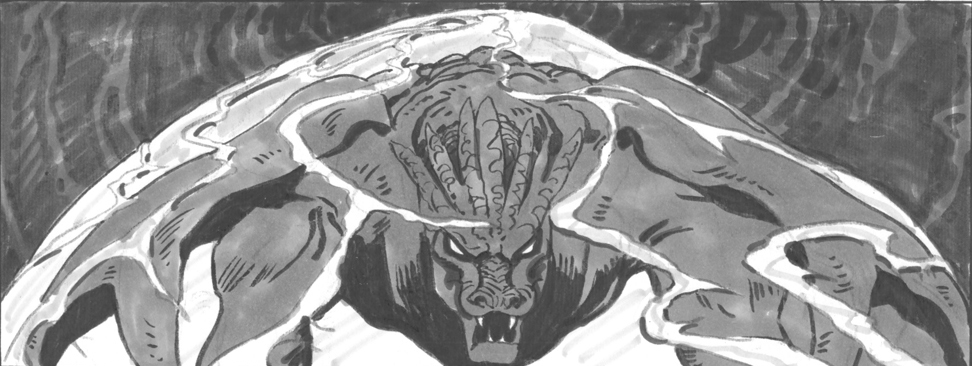 They Gryphon in its lair. Image courtesy of David Russell. © 1994 Sony Pictures Entertainment/ Toho Co., Ltd.
They Gryphon in its lair. Image courtesy of David Russell. © 1994 Sony Pictures Entertainment/ Toho Co., Ltd.After destroying Fleer`s jeep with a blast of bio-electricity from its wings, the Gryphon lands in Traveller. It demolishes the town, killing people, and exploding a gasoline storage tank before flying off. Rose is among the casualties. Hungry for revenge on the Gryphon, Fleer joins Aaron and Jill as they return to Fort Tuscarora.
Back in Massachusetts, Godzilla senses his rival’s appearance and awakens, despite a constant stream of amniotic fluid being force-fed to him. Pike initiates a plan to kill the monster, but the great beast breaks free and destroys the tank. Ignoring artillery fire, Godzilla walks to the shoreline, where he drops down on all fours before going into the water.
July 4, 1999: The arch-enemies are heading straight for each other and if they hold course, they’re set for a showdown in New York City. As Manhattan is evacuated, Jill takes a helicopter into the city, hoping to save Tina. The chopper pilot drops her off in Central Park, thirty blocks from Tina`s location.
The Gryphon flies over NYC, leaving destruction in its wake. A date clock on the United Nations Building is damaged, the inverted numbers reading "666".
Godzilla comes ashore, his foot smashing down on a gang of looters. As the battle of the monsters begins, Jill finds Tina and they try to figure out how to get off the island safely. The Gryphon takes flight and crashes into Godzilla, knocking him back. The Gryphon keeps charging, slashing with its talons then unleashing energy bolts that knock Godzilla into the rows of buildings. Godzilla slumps against the ruins, unconscious. Aaron says Godzilla can’t beat the Gryphon because of a restraining device implanted in the monster’s neck by the military, which gives him a constant dose of the fluid and prevents him from breathing fire. Using gunship helicopters, the military diverts the Gryphon while Aaron and Fleer remove the device from Godzilla. From a helicopter, the men are lowered on wires onto Godzilla and rig explosives to destroy the restraining device.
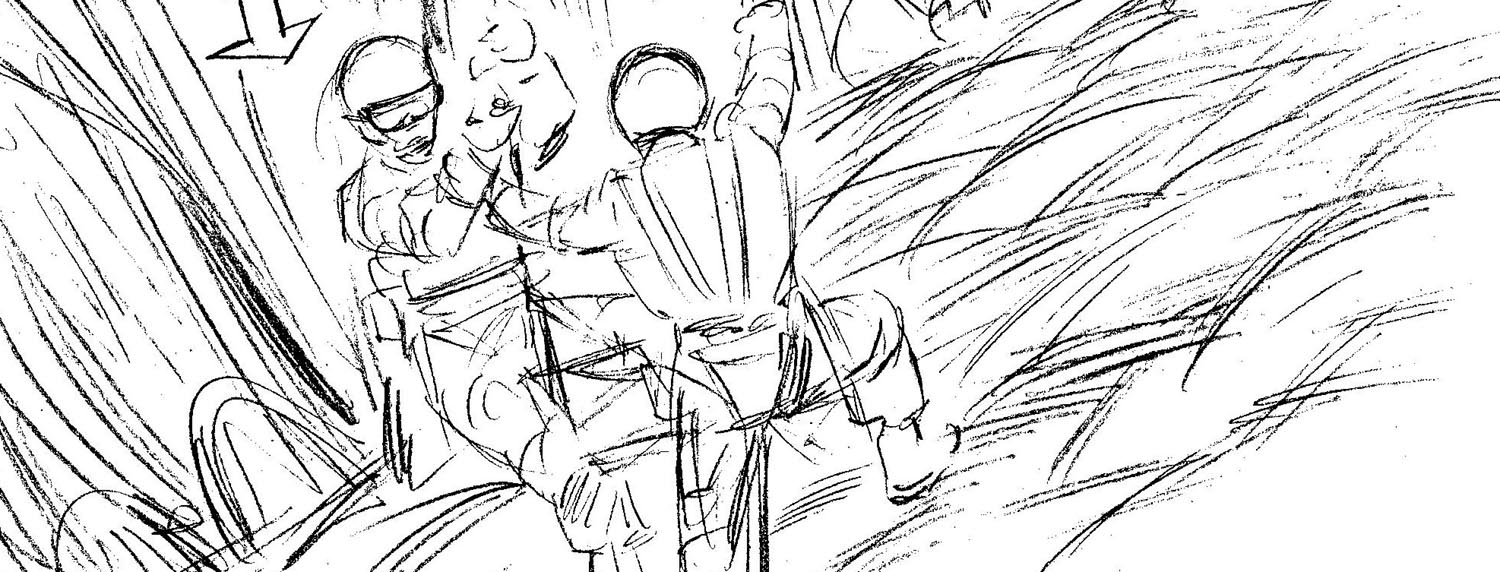 Aaron and Fleer remove the restraining device from Godzilla. Image courtesy of Jan De Bont. © 1994 Sony Pictures Entertainment/ Toho Co., Ltd.
Aaron and Fleer remove the restraining device from Godzilla. Image courtesy of Jan De Bont. © 1994 Sony Pictures Entertainment/ Toho Co., Ltd.Aboard one of the gunships, Pike lures the Gryphon to the Empire State Building. The helicopter shoots through the building, causing the top to crash down on the Gryphon and knock the beast down to the streets below. Pike turns his attention on Godzilla -- hoping to kill the monster while its weakened -- but the Gryphon flies up and smacks the helicopter from the sky.The Gryphon lands and stalks towards Godzilla, but Jill and Tina stall it briefly by crashing a gasoline tanker into a gas main near the monster. The eruption forces the Gryphon back into the sky.
The restrainer is removed from Godzilla. As the monster rises to his feet, Fleer and Aaron use their line to repel to a nearby rooftop. The Gryphon dives at Godzilla, who fires his breath at his opponent, wounding him, and pursues the fleeing Gryphon more vigorously. Meeting up with Jill and Tina, Aaron and Fleer run for the Brooklyn Battery Tunnel. The four cross paths with Pike who fires on the Gryphon when it crashes to the ground nearby. His attack proves futile; the Gryphon`s snake-tongues lash out and drag Pike into the monster`s gaping maw. The Gryphon shudders, then cracks its neck in Pike`s habit... the monster has assimilated the government agent.
Now aware that the red fluid can stop Godzilla, the Gryphon grabs the discarded restraining device and takes to the skies. Godzilla backs away from the on-rushing Gryphon, stepping on the tunnel, which begins to flood. The monster suddenly flicks its tail and smacks the restraining device out of the Gryphon`s claws and out into New York Harbor. Jill, Tina, Aaron and Fleer flee the flooding tunnel, dodging the monsters` feet as they fight. The helicopter pilot that dropped off Jill returns looking for Pike; he picks up Jill`s group instead.
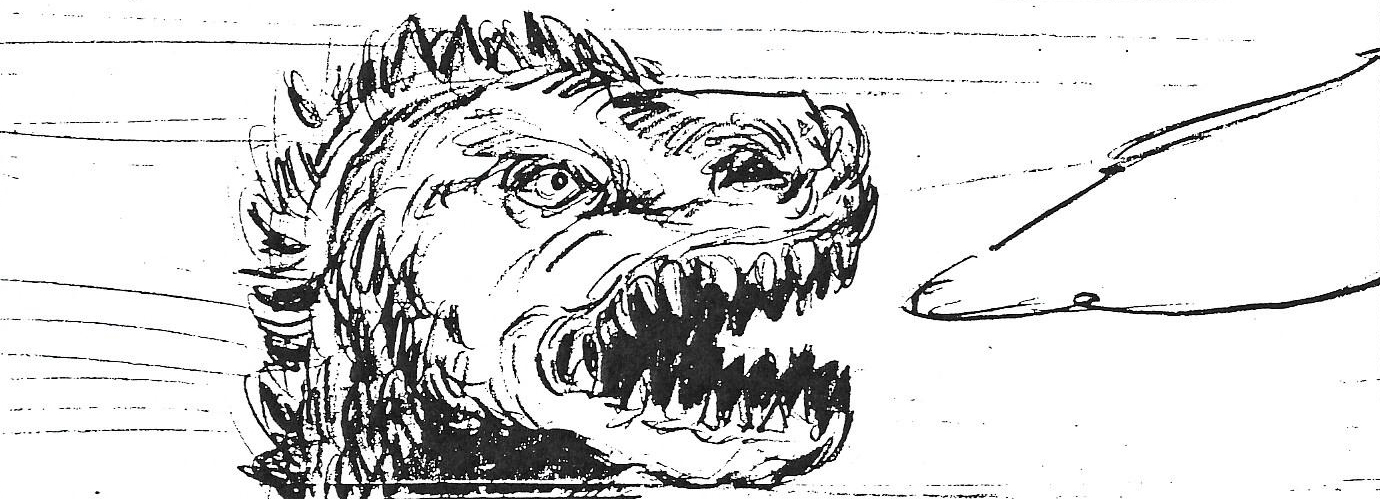 Godzilla fires his breath. Image courtesy of Terry Rossio. © 1994 Sony Pictures Entertainment/ Toho Co., Ltd.
Godzilla fires his breath. Image courtesy of Terry Rossio. © 1994 Sony Pictures Entertainment/ Toho Co., Ltd.The battle royal takes place in the East River. Godzilla breathes fire across the water’s surface, creating a steam cloud that blinds the Gryphon. Godzilla swims out to Liberty Island and sets off a compound of July 4th fireworks that bring the Gryphon racing to attack. Godzilla waits for his foe, then suddenly bends forward at the last moment and the Gryphon is sliced open on Godzilla’s dorsal plates. Godzilla reaches into the Gryphon`s chest and cracks its ribcage in half, then bites off his foe`s head and sets fire to the body. Godzilla tops off his victory by spiking the Gryphon`s head on the Statue of Liberty`s torch.
Jets move in to kill the wounded beast, but Jill convinces the military commander to call off the strike... Godzilla may be needed again. Their helicopter is struck by a rogue missile from one of the jets, but is caught by Godzilla before it can crash into the harbor. He sets it on the crown of the Statue of Liberty, roars victoriously and sets out for the sea.
THE DISCONNECT
"I didn`t want to make the original Godzilla, I wanted nothing to do with it. I wanted to make my own." --GODZILLA (1998) writer/director Roland Emmerich
"When you look at our Godzilla, you won`t feel any nostalgia." --GODZILLA (1998) writer/producer Dean Devlin
In the final months of 1995, rumors began to swirl that Sony Corporation would be bringing in a new management team to run the studio. Chris Lee realized that a transition period would give him the opportunity to get GODZILLA back in development. And he knew exactly who he wanted to make the film: his old friends, Roland Emmerich and Dean Devlin, who had scored their first big box office success with STARGATE (1994).
GODZILLA had been sidelined in part due to budgetary concerns. But Emmerich and Devlin had developed a reputation for delivering big, eye-catching movies -- and, more importantly, big profits -- on relatively modest budgets (Devlin once stated, "We`re making high-budget movies with a low-budget attitude."). Their UNIVERSAL SOLDIER, produced for $23 million, earned more than $102 million worldwide while STARGATE grossed $197 million worldwide from a budget of $55 million. And their upcoming $75 million alien invasion film INDEPENDENCE DAY was generating tremendous buzz in the wake of a successful Super Bowl commercial campaign.
Emmerich and Devlin were now the hottest filmmaking team in Hollywood, courted by all of the studios just as Jan De Bont had been two years before. Lee suspected that bringing their low-cost/high buzz style to GODZILLA would be too good a prospect for Sony to pass on... it was his own brand of Peter Guber`s “Big Mo” policy.
"I think they do these kinds of movies really well because they have their finger on the pulse of the public," Lee explained. "And they can synthesize elements of pop culture that we`ve all grown up on -- the idea of an alien invasion, the notion of Area 51. They can take an icon like Godzilla and keep the essence of what is best from what was popular and has become sort of cheesy over time and reinvent it. They stay true to the myth but reinvent it for current audiences. And they never forget the humor, not broad humor but comedy that comes out of situations. They`re great storytellers and while they provide amazing visual set pieces, they recognize that those effects must always be in service of the story and characters. They never talk down to their audiences and they understand what they`re doing, which is broad-based, event entertainment. I thought they`d be perfect for GODZILLA."1
Lee had already pitched GODZILLA to Roland Emmerich and Dean Devlin several times without success. "They`d already closed down one production for budget reasons, and they were constantly offering it to me, but I didn`t know," Roland Emmerich recalled.2 Undeterred, he went back to the pair once again, visiting them on the set of INDEPENDENCE DAY. "Chris came back to us again and said, `Why are you not doing this?`"
But the reason for not doing GODZILLA was obvious to Dean Devlin. "Both of us thought it was a dopey idea the first time we talked," he recounted. "When Chris came back to us, we still thought it was a dopey idea."3
Emmerich intended to follow ID4 with GROUND ZERO, a disaster pic inspired by one of his favorite movies, THE RIGHT STUFF. "At that time I had an idea about a movie about a meteor striking Earth," he revealed. "And I had a whole idea how to do it. I wanted to do something like THE RIGHT STUFF, combined with a meteor strikes Earth. So, you have to go up there on a mission."4 But then he and Devlin learned two films with a similar premise were already in development at Disney and Paramount. "We were on our promotion tour for INDEPENDENCE DAY and we`d been talking about some other ideas that didn`t pan out," said Devlin. "We wanted to do an asteroid movie, but when we learned about DEEP IMPACT and ARMAGEDDON we backed away. And then one day in Paris I looked over and saw Roland sketching on his pad. They were Godzilla sketches. And I know when Roland starts sketching, he`s got the fever."5
"It took Dean and I a couple of years to figure out that there could be a way," Emmerich asserted.6 "Godzilla was one of the last concepts of the `50s that had never been done in modern form -- that idea of the giant monster as in TARANTULA or THE BEAST FROM 20,000 FATHOMS. Why not do them again? Big Lizard eats Big Apple. I like it."7
But the retro qualities the appealed to Roland Emmerich had been a major stumbling block for Dean Devlin. "Over the course of one year, I was asked to do GODZILLA several times. Each time I said `No` -- because this was the product of a certain time period, and the qualities it possessed belonged to that time," he argued. "But finally I realized that THE WAR OF THE WORLDS was a product of its time, and yet we re-thought that and came up with INDEPENDENCE DAY. This picture could retain a certain `monster movie` feel while featuring our own, original elements."8
Chris Lee was thrilled by Devlin and Emmerich`s new-found interest in GODZILLA. But, even so, he did not have the authority to green light the film. Instead, Lee offered a "step deal", an agreement that they would be paid to develop GODZILLA one step at a time until a new studio head took over Sony Pictures and made the final call. The filmmakers accepted Lee`s offer, but with certain conditions of their own.9 "I told Sony that I would do the film -- but on my own terms, with Godzilla as a fast-moving animal out of nature, rather than some strange kind of creature," insisted Dean Devlin.10
The Devlin/Emmerich development deal was announced May 2, 1996, much to the surprise of Cary Woods and Robert Fried, the producers who had brought GODZILLA to Sony and shepherded the project through four years of ups and downs. "We understood that we would be shoved to the sidelines," Woods lamented. "That is the way it seems to work: you start something, you keep pushing, and when it finally becomes a reality everyone seems to forget your name."11
Now that they would be doing GODZILLA, Emmerich and Devlin decided to familiarize themselves with the character by watching Toho`s 1954 film. "Roland and I were surprised by the serious tone of the original, but also impressed with the high quality of the model work," Devlin acknowledged. "They had been smart enough to set a lot of the action at night and in the rain, which helped out a helluva lot."12 But Emmerich admitted that he was much less impressed by the sequels, saying that he tried to sit though them, "Then I gave up. It`s just the same movie over and over again. They always had another monster in it, and I never get anything out of two monsters fighting. For reasons I can`t explain myself, kids all over the world kept watching these movies, in cassettes and at matinees."13
Downplaying Roland Emmerich`s criticism, Devlin told the press that, "We`re huge fans of Godzilla. We think it`s an opportunity to do a really enormous film, to take it beyond what anyone has ever imagined could be done with Godzilla. We`d like to make a Godzilla that`s meaner, faster, wilder than anything seen before. But there`s no script yet, and there`s a long way to go."14
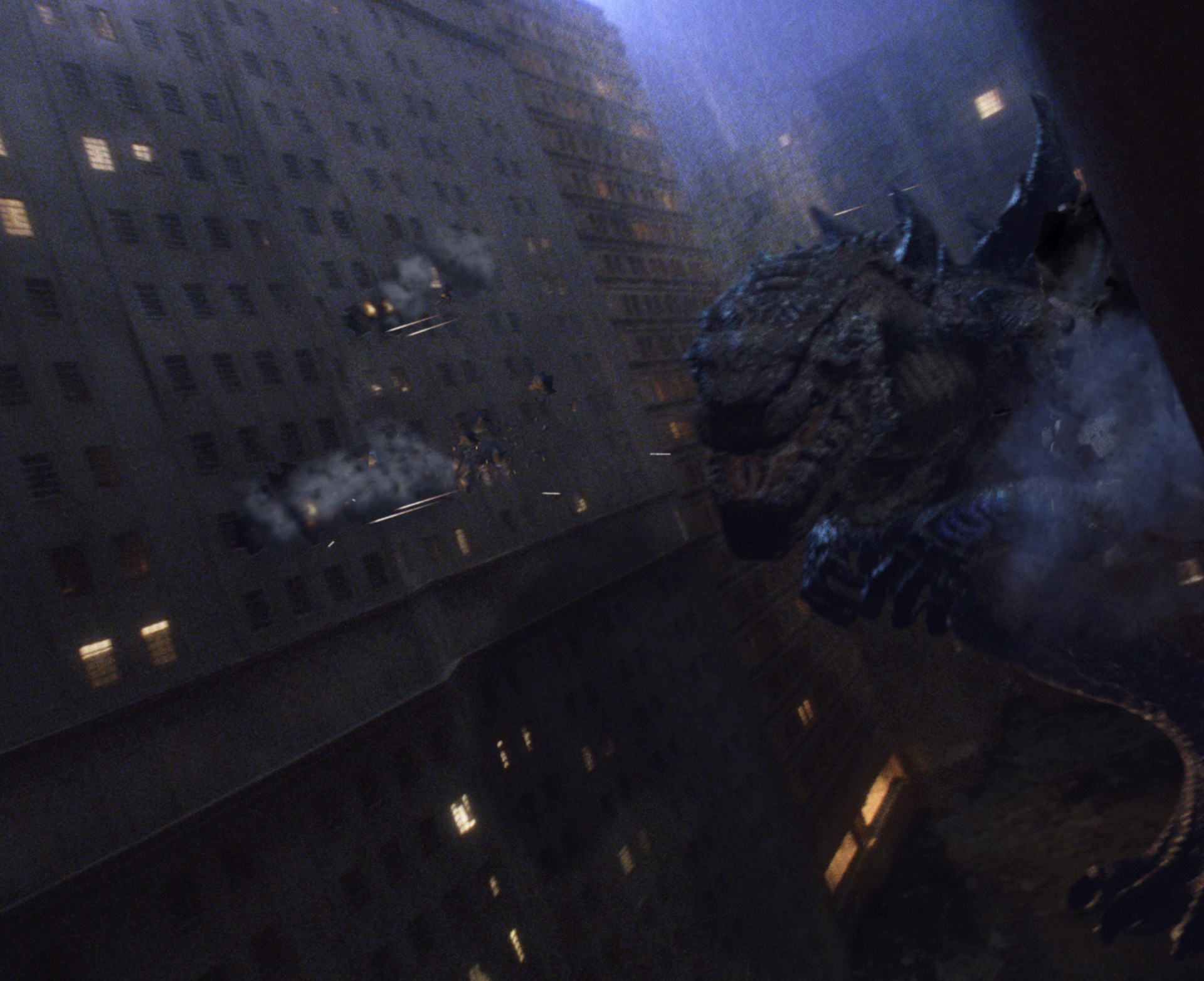 Devlin and Emmerich wanted a faster Godzilla than had ever been seen in the Japanese films. © 1998 TriStar Pictures, Inc./ Toho Co., Ltd.
Devlin and Emmerich wanted a faster Godzilla than had ever been seen in the Japanese films. © 1998 TriStar Pictures, Inc./ Toho Co., Ltd.Devlin revealed that he and Emmerich were drawn to the project, in large part, by the Terry Rossio/Ted Elliott/Don Macpherson screenplay drafts. "When Jan De Bont got involved, he developed a really good script and even though we decided to abandon that script and take a completely different direction, what it did tell us was that it can be done elegantly and you can do it straight. And when I say `straight`, I mean still with a lot of humor, but respectfully."15 But he added that, "We`re not even rewriting those scripts; we`re starting from scratch."16
Jan De Bont found Devlin`s words to be faint praise. "At that time, Ted and Terry were some of the best screenwriters you could get in the business... you couldn’t get many better than that," he told SciFi Japan. "They were the one who really understood Godzilla. And it was a slap in their faces, because the moment that Roland took over they were immediately replaced."
De Bont`s sentiments were echoed by Cary Woods, who had originally hired Terry Rossio and Ted Elliott to write GODZILLA. “I get it, Emmerich was the hottest director in town, but the Rossio & Elliott back story was so rich, Sony would have gotten three hit movies out of it had they only followed the plan.”17
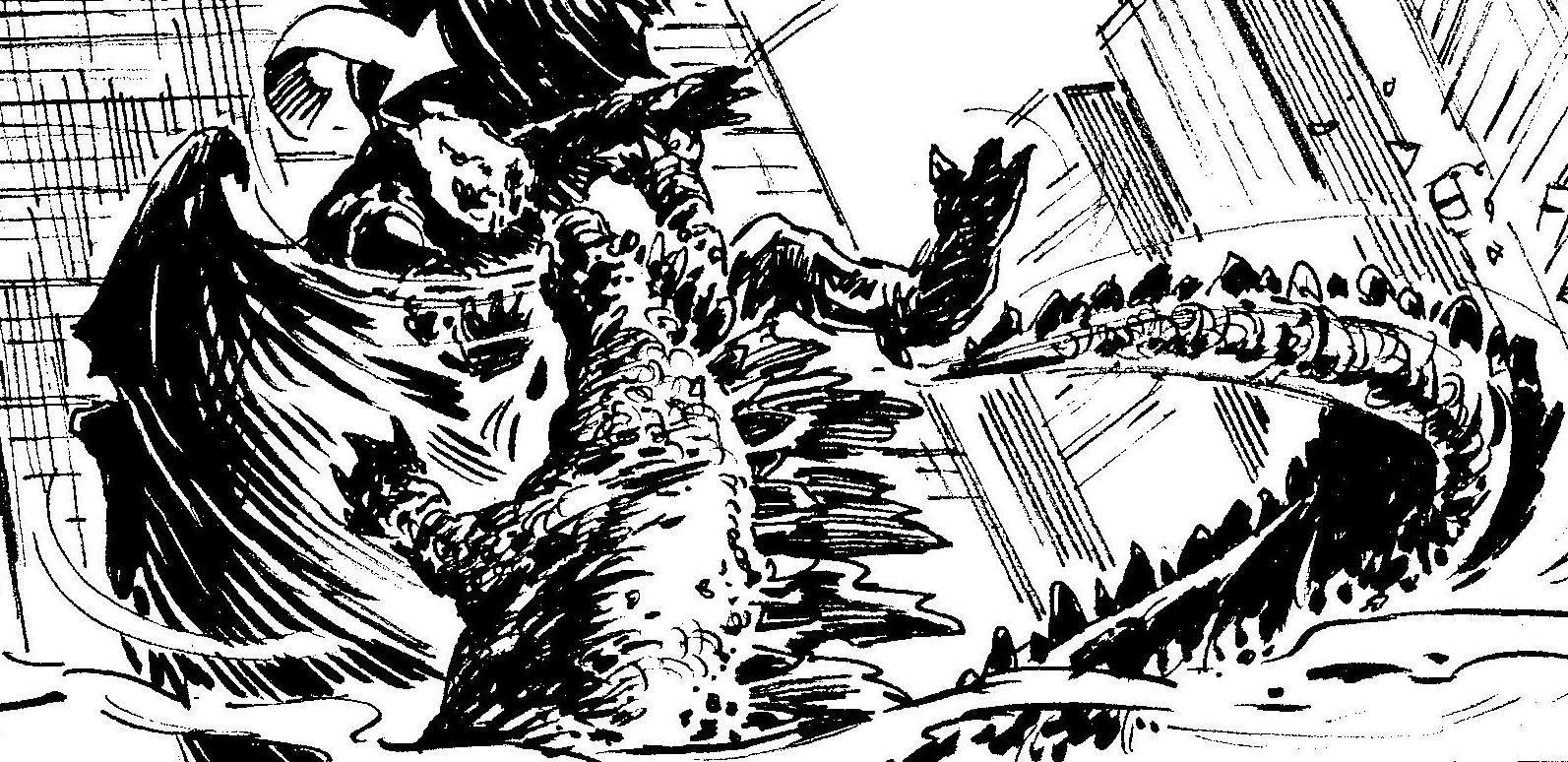 Emmerich refused to do a movie with Godzilla fighting another monster. © 1994 Sony Pictures Entertainment/ Toho Co., Ltd.
Emmerich refused to do a movie with Godzilla fighting another monster. © 1994 Sony Pictures Entertainment/ Toho Co., Ltd."It was a very well-written script," Roland Emmerich conceded on TNT ROUGH CUT. "It had some really cool things in it, but it is something I never would have done. The last half was like watching two creatures go at it... I simply don`t like that."
For Emmerich, the only way to create a great Godzilla film was to completely ignore the traditions established in the Toho movies. “I didn’t want to make the original Godzilla, I wanted nothing to do with it. I wanted to make my own," he explained in an interview with CNN. "We took part of [the original movie`s] basic storyline, in that the creature becomes created by radiation and it becomes a big challenge. But that`s all we took. Then we asked ourselves what we would do today with a monster movie and a story like that. We forgot everything about the original Godzilla right there," insisted Emmerich.18
From the moment Cary Woods and Robert Fried had first pitched Godzilla to Sony Pictures, there had been two diametrically opposed views on how an American version should be handled. Woods and Fried saw Godzilla as a world famous icon primed for an update with modern Hollywood FX technology. This vision had been shared by director Jan De Bont and the team he assembled, as well as the management at Toho. But there were also executives at the studio -- including those at TriStar and Columbia who had initially turned down licensing the character -- who saw Godzilla as nothing but a campy, kitschy character that could never appeal to a wide, international audience without a complete overhaul. De Bont said this attitude was what eventually forced him off the project. And now Roland Emmerich and Dean Devlin were willing to take on the film but only if they were allowed to completely reinvent Godzilla into something wholly their own. This was music to Sony`s ears.
With the studio`s blessing, Emmerich and Devlin began developing their take on what an American Godzilla should be. Once that was decided on, the duo would make their pitch to Toho. "We had been warned by Jan De Bont that if you want to make the slightest change to Godzilla, you meet enormous resistance [from Toho]," Devlin said. "That`s been part of the problem with getting any of these films done. And Roland and I didn`t want to do slight changes, we wanted a complete overhaul."19 But the producer was confident they would win Toho over, stating, "So whatever direction we go we`re going to have to get approval from them. But we are very optimistic they`re going to like the direction we`re going."20
"The Japanese want to have it looking exactly like Godzilla because they own the trademark," Roland Emmerich explained.21 But the director wasn`t interested in that, saying, "The original, how Godzilla looked, didn`t make sense to me."22 He also disliked TriStar`s previous Godzilla designs: "I saw the creature that they designed for [TriStar`s first attempt]. Jan De Bont created a Godzilla that was very close to the original, but it was not right because today we wouldn`t do it like that."23
Rather than create a more `realistic` interpretation of the classic design, Emmerich wanted to use the latest FX techniques to take the new Godzilla in a radically different direction. "We are living in a time when people have seen JURASSIC PARK and THE LOST WORLD and we don`t have the same kind of limitations the Japanese had when they made their GODZILLA. There is an American movie called THE BEAST FROM 20,000 FATHOMS, shot in the early 1950s. This movie was done with stop-animation and it was one of Ray Harryhausen`s best works. Obviously, the Japanese saw that movie and said, oh, we should do something like that, too. But they had no clue how to do stop-animation,"24 he claimed, seemingly unaware the Toho FX director Eiji Tsuburaya had been well-versed in stop-motion animation and had even used the technique in the original GODZILLA and other Toho films. It was tight schedules and budgets -- not a lack of technical knowledge -- that prevented Tsuburaya from using stop-motion as much as he may have liked.25
"They couldn`t do stop-motion animation, so they just built a big suit and put a stuntman in -- and that`s why it`s so bottom heavy. That`s why it looks a little bit silly," he laughed.26 "They built a big rubber suit, but a rubber suit was much bulkier because, if it was too close to the human body, it gave away that there was a person inside it. It had these big, fat legs, and couldn`t walk very fast. It developed this kind of `Godzilla walk`. Now with the new effects technology we don`t have that limitation and it slims down the creature enormously."27
A slimmer Godzilla meant a faster Godzilla which, surprisingly, was an idea the filmmakers said they got from watching the Toho films. "We realized that the reason behind the whole lumbering Godzilla was that they had to shoot a guy in a heavy-rubber monster suit and film in slow motion to give him some sense of scale," said Devlin. And considering Godzilla`s size, "if you do the math, even if it walked at a gingerly pace, it`s covering a lot of territory quickly." Emmerich added, "Godzilla can outrun any taxi, and that was the core idea for the movie. No one can catch it. Dean and I realized we could make a different Godzilla, a movie about a hunt, about hide-and-seek."28
To visualize their overhaul of Godzilla, Emmerich and Devlin turned to another longtime collaborator, STARGATE and INDEPENDENCE DAY production designer Patrick Tatopoulos. "The original GODZILLA was one of the first movies I saw as a kid," Tatopoulos wrote in his book, The Art of Godzilla. "It may well be the reason I got in this business. Godzilla is the monster all creature effects designers dream of designing. When Roland asked me if I wanted to design the new Godzilla, how long do you think it took me to say yes?"29
While enthusiastic, Tatopoulos also realized the pitfalls in redesigning such a well-known character. "On GODZILLA, I think there was a lot of pressure based on the fact that the concept was to create the lead character of the movie. Like the lead actor, basically. And also knowing that if people didn`t like the creature -- if the creature didn`t work out -- ultimately that would kill the movie. Obviously there was a psychological pressure."
Like Emmerich, Tatopoulos had seen the Godzilla designs for the Jan De Bont version and felt that Ricardo Delgado, Crash McCreery and Joey Orosco had taken a completely wrong approach. "What they did which was a mistake in my mind was, rather than going in a new direction they tried to alter and make the old one better," he said in an interview for Centropolis` online magazine, EON. "And when you do that, first of all I think it`s very disrespectful. It`s more disrespectful for me to alter something existing than to take a fresh new direction. It means `Oh, your Godzilla is what it is, but we can make it better.` I`m not saying that`s what their intent was, but I`m saying that to go to Japan and say `Well, we made the eyes and the scales more realistic on your Godzilla`, they just wouldn`t go for that... Roland pushed me and said to go wild. `We want something that will run 500 miles an hour through the streets of New York.` That obviously dictates the design in that it can`t be like the old one, which was more slow and heavy. It`s really Roland`s pushing, telling me not to limit myself and that they would worry about selling it to the Japanese."
"I could have just tweaked the old design, essentially modernizing it; but after hearing Roland`s views that seemed less respectful than taking a whole new direction with it. The old Godzilla was a lumbering beast, whereas this one would be a sleek and agile animal -- Godzilla after fitness training."
Emmerich faxed Toho`s list of rules regarding Godzilla`s appearance to Tatopoulos, but the artist never received the message. Regardless, Tatopoulos began drawing dozens of Godzilla sketches in between doing production designs for Alex Proyas` DARK CITY in Sydney, Australia. "It was a very easy job because it was something completely new," he recalled. "The only challenge was not to make this creature look like a T-rex or a gigantic dinosaur because we`ve seen this in JURASSIC PARK and even more in THE LOST WORLD when the T-rex runs through the street. But fortunately this guy doesn`t look like a dinosaur. It is a dragon more than anything else."30
"I did some tweaking to give it something different. I gave him a chin. It gives him a lot of nobility. One of the inspirations was a character I loved as a kid, the tiger in JUNGLE BOOK, Shere Khan. He had this great chin thing and I always loved it; he looked scary, evil but you respected him. I thought, let`s try to give him a chin and I felt it still looked realistic but he had this different thing that you hadn`t seen before."31
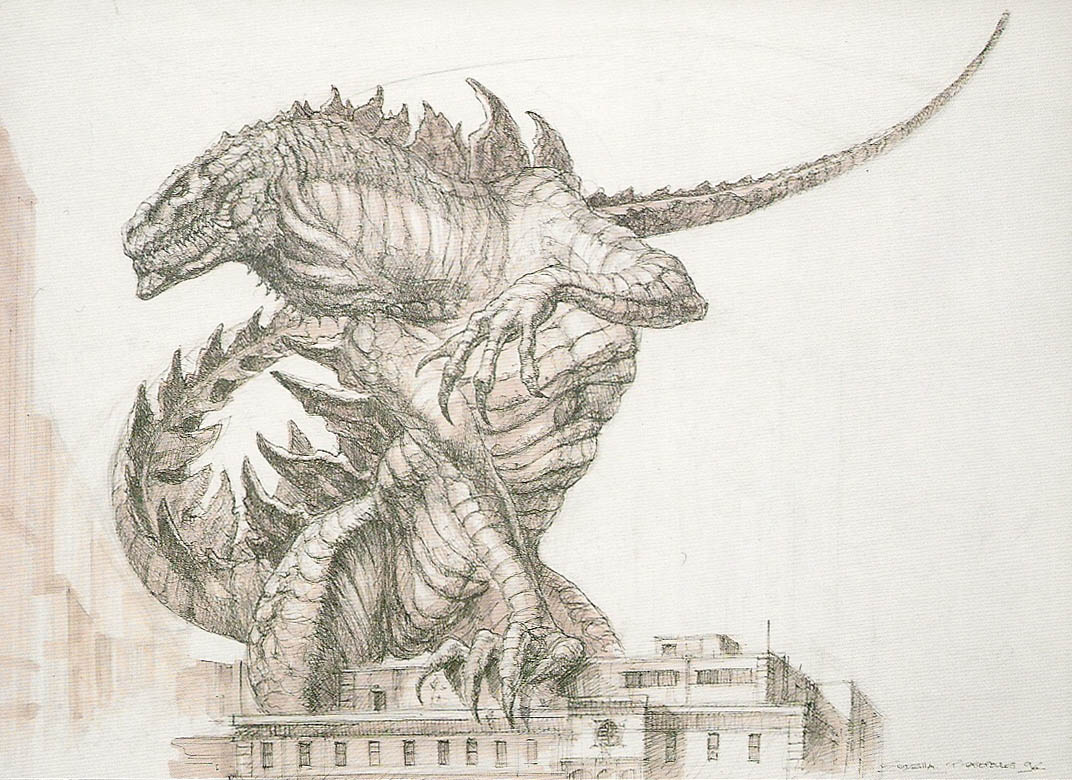 Patrick Tatopoulos` favorite of his new Godzilla designs was also the one Roland Emmerich and Dean Devlin chose for their movie. © 1998 TriStar Pictures, Inc./ Toho Co., Ltd.
Patrick Tatopoulos` favorite of his new Godzilla designs was also the one Roland Emmerich and Dean Devlin chose for their movie. © 1998 TriStar Pictures, Inc./ Toho Co., Ltd.In May 1996, Patrick Tatopoulos met with Dean Devlin and Roland Emmerich, who were already losing interest in the project due to "event picture fatigue" from INDEPENDENCE DAY and growing concerns that Toho would veto their vision for Godzilla. "I ended up meeting them at Cannes; I finished DARK CITY and they were promoting ID4 in Cannes at the time, and when I met them they said they were thinking about not doing it," he revealed. "I said `oh no, no way, come on! This is the coolest thing we could do together!` I just ended up bringing them two drawings rather than the 40 I`d been working on because I didn`t want to get them confused, and specifically there was one that I was really excited about, that was my best one. And they both looked at it and said `Wow!` and they said they would do it."
"When Roland and I saw the drawings we just looked at each other and said `That`s it... that`s our next picture`,"Devlin recalled.32 "I don`t think Roland and I would have been doing GODZILLA without his creature designs, and his new concept of what it could be like." Emmerich agreed, stating, "We had a very talented designer in Patrick and I thought he nailed it on the first try. I never wanted to change it."33
With the design decided upon, the next major hurdle would be to convince Toho to sign off on the new Godzilla. So, while the filmmakers continued their promotional campaign for INDEPENDENCE DAY, Tatopoulos created four different color Godzilla concept art pieces and had a 2 foot tall maquette sculpted for a presentation at Toho`s Tokyo headquarters. "And that was actually the first time we showed it to Sony, right before we showed it to Toho," said Dean Devlin. Chris Lee was overjoyed by the new design, saying "It was just so different. So improved."34 But others at the studio were taken aback by how far Emmerich and Devlin had gone with their Godzilla. "
When Sony saw it they had a complete heart attack. They said, `Toho will never accept it! You`ve ruined it! Why did you do this?`" Devlin recalled. Sony advised Devlin and Emmerich to reveal their revised Godzilla to Toho gradually, telling them, "You have to do this in stages! Show them the face first, then show them the body."35 But the filmmakers felt that would be misleading and inappropriate.36 "And we said, `Look, either they want to do it this way or not. And that`s fair to everybody," said Devlin.
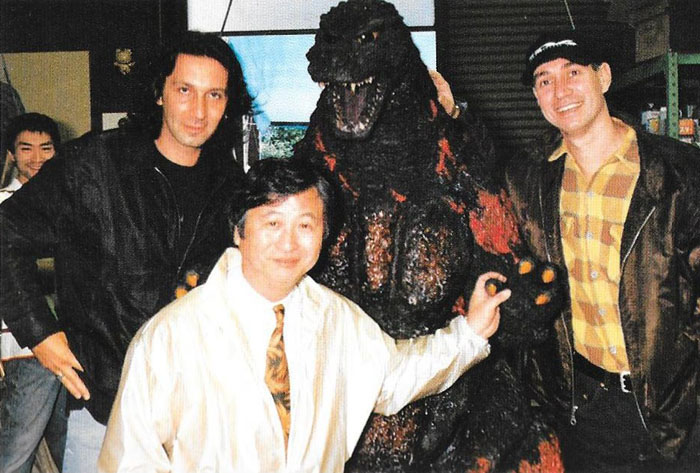 Patrick Tatopoulos and Roland Emmerich at Toho Studios with FX director Koichi Kawakita and Godzilla. © Toho Co., Ltd.
Patrick Tatopoulos and Roland Emmerich at Toho Studios with FX director Koichi Kawakita and Godzilla. © Toho Co., Ltd.Regardless of their initial shock, Sony`s desire to have Emmerich and Devlin make GODZILLA had only grown stronger. The duo`s INDEPENDENCE DAY had opened to record-breaking box office that July 3rd and was well on the way to becoming the smash hit of 1996... the film would make more than $306 million in the US with a total worldwide gross of $817 million (the year`s second-biggest hit would be Jan De Bont`s TWISTER).
The movie’s blockbuster success also gave them additional clout in their dealings with Toho. In September 1996, Patrick Tatopoulos and Roland Emmerich flew to Tokyo to present their take on Godzilla to Toho. Dean Devlin, who normally handled studio pitches for Centropolis, was hospitalized in Germany with a stomach ailment, forcing Emmerich to make his case to Godzilla`s owners. The visit started off, Emmerich felt, rather awkwardly. "The most embarrassing moment of my life, I was in Japan to show Toho -- who owns the copyright for Godzilla -- my new Godzilla. Before I did the presentation, they brought me to the Toho studios and there was Godzilla standing there with a sign around his neck that said, `Mr. Emmerich, I`m ready for your shooting call`."37 The stunned director joked that Godzilla never got that call.
At a meeting with studio executives -- which included Toho chairman Isao Matsuoka, Godzilla series producer Shogo Tomiyama and FX director Koichi Kawakita -- Emmerich spoke first, describing what he hoped to accomplish if given the opportunity to make GODZILLA. "For the first time, I saw Roland trying really hard to get the job," Tatopoulos recalled. "He`s used to getting what he wants, and I think before we had the meeting he cared, but he felt very comfortable. Until the day that we had the meeting, I could tell that he was throwing his heart out there and he really wanted them to know how much he cared about doing that project."
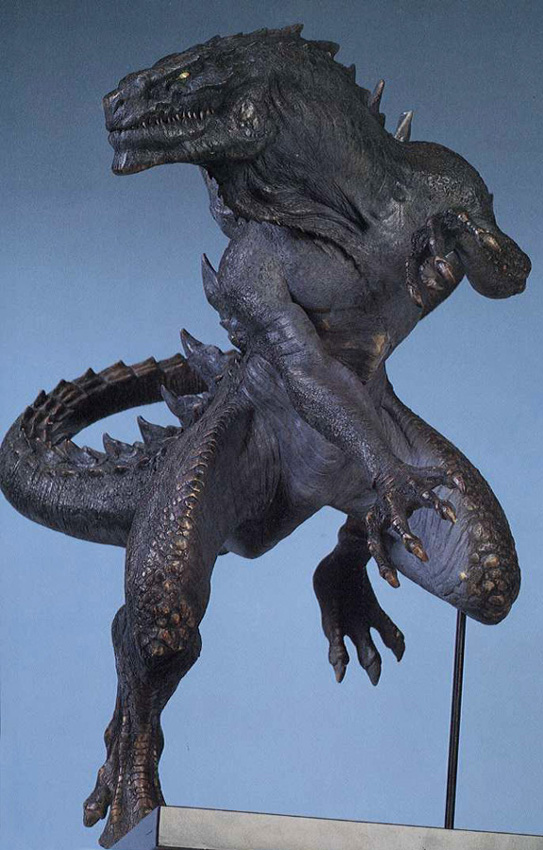 Godzilla maquette created to present the new design to Toho. © 1998 TriStar Pictures, Inc./ Toho Co., Ltd.
Godzilla maquette created to present the new design to Toho. © 1998 TriStar Pictures, Inc./ Toho Co., Ltd.With Emmerich`s introduction out of the way, Tatopoulos unveiled his Godzilla artwork and maquette. It was met with a gasp from the Toho execs, followed by stone silence. "After designing my last Godzilla, the one that wound up in the movie, I felt very secure and I believed we had something great. But the day I sat in front of the Japanese I thought, `what have I done? Am I crazy? They`re not going to go for it`," Tatopoulos worried.
"They were speechless," Emmerich recalled. "They stared at it, and there was silence for a couple minutes, and then they said, `Could you come back tomorrow?` I thought for sure we didn`t have the movie then."
"It was so different we realized we couldn`t make small adjustments," Shogo Tomiyama disclosed. "That left the major question of whether to approve it or not." That night, Tomiyama visited Godzilla co-creator Tomoyuki Tanaka, whose failing health had prevented him from attending the meeting, to bring him up to speed. Tomiyama wasn`t allowed to remove any design art or photos from the studio premises, and found himself at a loss when describing the Tatopoulos Godzilla to Tanaka. "I told him, `It`s similar to Carl Lewis, with long legs, and it runs fast`."38 Tanaka would pass away in April 1997 shortly before the launch of principle photography on the TriStar GODZULLA.
The following morning, Toho chairman Isao Matsuoka gave his blessing to Roland Emmerich and Patrick Tatopoulos. "So the next day we got in at ten in the morning and the head of Toho started speaking to us about how different we had made the character, that we`d taken such a far step away from the old one, but their last sentence was `We feel you`ve kept the spirit of Godzilla. The sense of the character is still there; when we look at him, it`s Godzilla and nothing else. So we`re giving you the green light.` Everybody applauded, and obviously for me that was the strongest moment of the whole show, at least until I go to the premiere and look at it. The whole process of fabrication and selling it to the Japanese was fabulous," Tatopoulos recalled.
Emmerich reported that, "I simply went there and showed them the new Godzilla and said, `Why don`t you call your Godzilla the classic Godzilla and mine the new Godzilla?`, and they were kind of just fine. To the surprise of everybody, they went for it. Now they can market two Godzillas."
"The answer was yes because it was so different," said Dean Devlin. "They felt they could preserve Godzilla as he is, and yet continue him into a whole new generation with this new creature." And, in several interviews leading up to GODZILLA`s release, Devlin repeated that Toho actually preferred the new Godzilla design to the original: "Toho sent word that if the technology had been available to design the creature in such a manner back then, their Godzilla would have probably resembled the creature we came up with. Dollar and technology limitations forced them to go with a man in a suit, but it wasn`t necessarily what they wanted -- it was more a matter of practicality."
"I think, because the previous one [De Bont`s version] fell through, we were lucky that Toho was more willing because they really wanted to make a movie at this juncture," executive producer William Fay acknowledged. "I think it was timing and their confidence in Roland and Dean as filmmakers. They wanted an American GODZILLA movie to put a stamp on their creation and make it a worldwide phenomenon, not just with science fiction fans. And the only way to do that was with a big American movie."39
Time would prove Fay`s comments true. In the years following the release of TriStar`s GODZILLA, many who worked on Toho`s Godzilla films expressed a lack of enthusiasm -- in some cases, abject loathing -- for the Devlin/Emmerich GODZILLA. But it had been many years since a Japanese Godzilla film received a worldwide theatrical release, and most of the recent movies hadn`t been distributed outside Asia so Toho was eager to make Godzilla an international franchise again. An American GODZILLA movie would put the character back in the public eye in a big way and potentially increase the demand for Toho`s own films. And the company stood to make millions from the American GODZILLA... but only if it were made.
Toho was well aware that TriStar had struggled for four years to get the film off the ground; that a number of A-list directors had turned the project down; that Jan De Bont`s attempt had collapsed; and that TriStar would likely abandon GODZILLA if Roland Emmerich and Dean Devlin didn`t make the picture. There was simply too much to lose for Toho to say `no`.
Even so, Toho did ask for small adjustments to the Godzilla design to keep it in line with the rules they`d given TriStar back in 1992. "The first one is that I created the character with two rows of fins on the back," Patrick Tatopolous told EON. "It was funny because the head of Toho said the old Godzilla had one row of fins on his back and all the other Japanese men looked at him and said `no no, it was three rows!` It was actually very funny to realize that the head of Toho f***ed up! He was very nice and everybody laughed and it created kind of a more relaxing atmosphere after that. That was after they gave us the green light. And I added another row of fins in the center but did it in a way that it didn`t distract from the main design, but it`s there and you can see it." Toho also reduced the number of fingers on Godzilla`s hands; the monster had always had four fingers but Tatopoulos had included a fifth vestigial digit in his design. "Everything else really stayed the same, the color and everything else they really went for."
Devlin also found Toho supportive, saying, "Once they signed off on that conceptually, they pretty much let us make the picture we wanted to make. But they still come down and they look at things because they want to make sure it`s being handled properly. And I don`t blame them because it`s been a big franchise for them for a long time."40
With Toho having approved Roland Emmerich and Dean Devlin`s vision, the next step for the filmmakers was to write the screenplay. GODZILLA had still not been given the green light by TriStar, so Emmerich and Devlin agreed to write a screenplay completely on spec, with the condition that the studio would approve it immediately or let the script revert to them. In one of his last acts as head of production for Sony Pictures, Mark Canton approved the deal.
That October, Emmerich and Devlin traveled to Emmerich`s vacation home in Puerto Vallarta, Mexico to craft the film`s story. "We wrote the first draft fairly quickly, in five and half weeks in Mexico," said Devlin. "And of course we revise it as we work on it, but for the most part, structurally, it hasn`t changed at all."
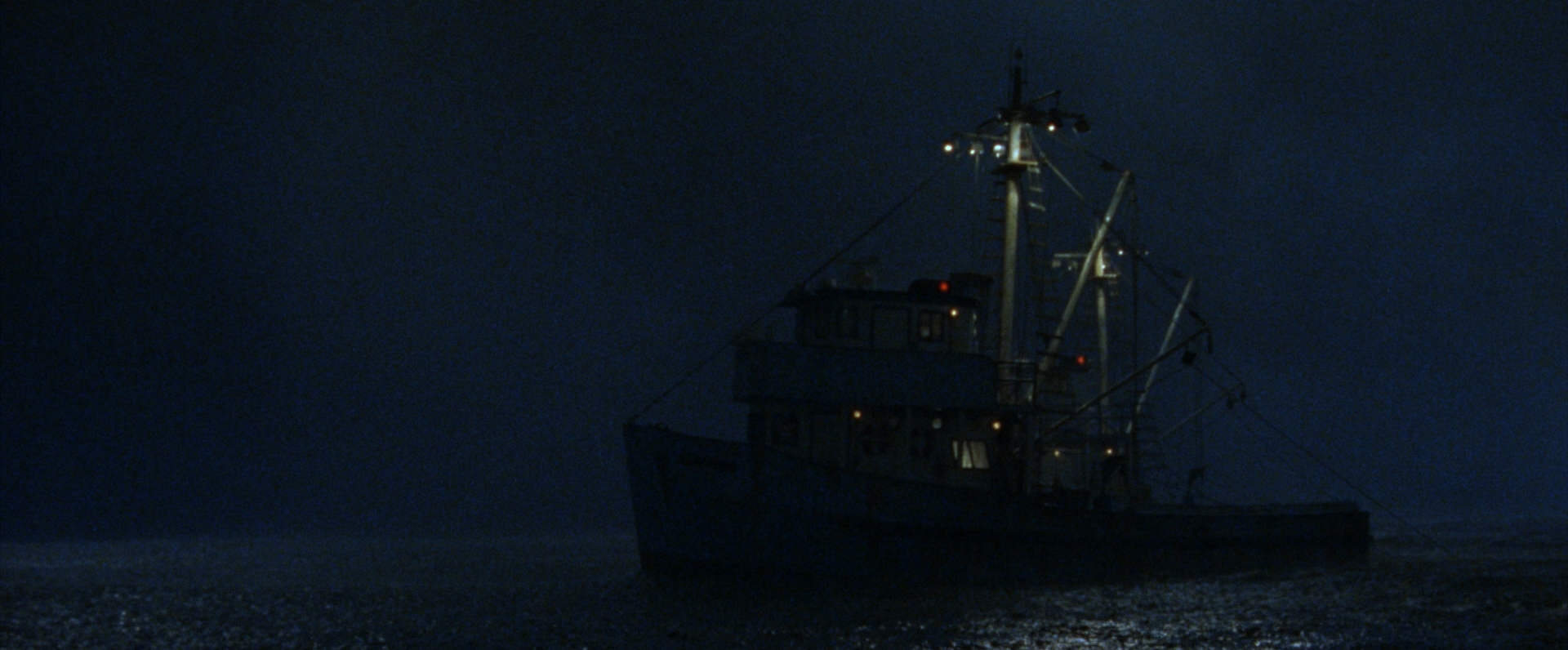 Godzilla`s encounter with some fishing boats was one of the few scenes (loosely) carried over from the Elliott/Rossio GODZILLA screenplay. © 1998 TriStar Pictures, Inc./ Toho Co., Ltd.
Godzilla`s encounter with some fishing boats was one of the few scenes (loosely) carried over from the Elliott/Rossio GODZILLA screenplay. © 1998 TriStar Pictures, Inc./ Toho Co., Ltd.Emmerich and Devlin incorporated a few minor elements from the Ted Elliott/Terry Rossio GODZILLA script (with the former writers getting a "story by" credit) while taking the story in a completely different direction from previous attempts. Most of the story was set in New York City, while the Gryphon, Probe Bats and alien creatures prominently featured in the earlier GODZILLA screenplays were eliminated. By removing these elements, the filmmakers expected to make the film for a much lower budget than had been projected in 1994. They also tossed out the back story Elliott and Rossio created for the monster. "Godzilla is the result of nuclear testing, and that is something we felt pretty strongly about not abandoning," said Devlin. "In some of the early drafts of the script by others, they had Godzilla being an alien planted here. What Japan had originally come up with regarding nuclear radiation -- you can`t abandon that. It`s too important to what Godzilla is all about."
Despite the obvious physical changes Devlin and Emmerich were bringing to Godzilla, making the monster "all about" radiation could potentially have gone a long way towards tying the American version back to the character`s roots. In a 1991 interview, original Toho GODZILLA director Ishiro Honda said "Godzilla as the embodiment of the fear of the atomic bomb" was the starting framework he, producer Tomoyuki Tanaka and FX director Eiji Tsuburaya had worked from when creating the character and making the first film in 1954. "The top question regarding that film was the fear associated with what was then known as the atomic bomb," Honda explained. "When I returned from the war and passed through Hiroshima, there was a heavy atmosphere -- a fear that the Earth was already coming to an end. That became my basis. From my standpoint as the film`s director, I thought this premise was most appropriate."41
Toho director Jun Fukuda (GODZILLA VS THE SEA MONSTER, GODZILLA VS MEGALON) espoused a similar sentiment when interviewed for the BBC documentary, GODZILLA KING OF THE MONSTERS. "I thought of Godzilla as the embodiment of violence and hatred for mankind because he was created by atomic energy," he said. "He carried this rage within him because of his origins. He`s like a symbol of humanity`s complicity in their own destruction. He doesn`t have an emotion... he is an emotion."
 The new Godzilla could burrow underground to avoid detection. © 1998 TriStar Pictures, Inc./ Toho Co., Ltd.
The new Godzilla could burrow underground to avoid detection. © 1998 TriStar Pictures, Inc./ Toho Co., Ltd.But Dean Devlin and Roland Emmerich decided to treat the nuclear subject with little more than lip service. Like any number of 1950s American monster movies, radiation is blamed for the creature`s origin but has little bearing on the rest of the story. The symbolic qualities attributed to Godzilla since the character`s creation were abandoned in favor of making Godzilla nothing more than a very big animal. As Emmerich revealed in TriStar`s production notes for the film, "Godzilla disturbs the life of a busy city, but it becomes frightening because it behaves like a trapped animal trying to survive. The scariness comes from the sheer fact that you have to deal with a huge, unpredictable animal." PatricK Tatopoulos concurred, saying, "We were creating an animal. We weren`t creating a monster."42
As an animal, the American Godzilla would be vulnerable to mankind`s weapons. So rather than barreling through an onslaught of missiles and rocket fire as the Japanese Godzilla had done in film after film, the new Godzilla would use its abilities to avoid attack. In addition to its incredible speed, Godzilla would be able to hide from enemies by tunneling underground. "We discovered that certain kinds of lizards can burrow, so we decided to give him that capability,"43 Devlin observed. Another protective characteristic -- though abandoned during production -- was skin that could change colors like a chameleon, allowing Godzilla to blend into its surroundings.
Sticking to their `animal, not monster` rule, the filmmakers also abandoned one of Godzilla`s most popular trademarks; the legendary radioactive breath. "The making of GODZILLA [1954] was really special, and what was most special was making radiation visual," Ishiro Honda said in 1991. "By opening his maw and simply exhaling, Godzilla can vaporize an entire building. As a tangible substance, radiation is probably much like that. But considered from the point of view of the film, for Godzilla to exhale radioactive fire is not unnatural."44
But Emmerich and Devlin disagreed with Godzilla`s creators, believing there was no scientific rationale for Godzilla to have such a weapon. Instead, the filmmakers replaced the radioactive breath with "power breath"... the new Godzilla would simply exhale and blow objects away with a big gust of wind.
With all of the powerful and destructive attributes of the Toho version stripped away, the new Godzilla would be a threat to mankind because of its ability to rapidly spawn more Godzillas. While Toho`s Godzilla had adopted a son or two over the decades, he had always been promoted by the studio as a male character -- the `King of the Monsters` -- and often portrayed with a tough guy swagger by suit actor Haruo Nakajima. But TriStar`s Godzilla would lay hundreds of eggs at a time via parthenogenesis, a type of asexual reproduction used by some lizard species. These eggs would hatch Baby Godzillas, who would rapidly grow to each have hundreds of young of their own, quickly overrunning the planet.
While Devlin and Emmerich were in Puerto Vallarta, the long-rumored changes were afoot in Culver City. Mark Canton was fired and Sony Corporation announced that John Calley would take over as President and Chief Operating Officer of Sony Pictures Entertainment in early November.
Calley brought decades of experience to the job, having been Executive Vice President of Filmways from 1961-1968 and an executive at Warner Bros. from 1968-1981. After spending a few years as an independent producer, he became President and COO of United Artists Pictures, overseeing such hits as LEAVING LAS VEGAS (1995), THE BIRDCAGE (1996) and the James Bond relaunch GOLDENEYE (1995). Calley would be bringing in his own group of executives to run Sony Pictures, and their top priority was to develop franchises for the studio. The first draft screenplay for the new GODZILLA was submitted to Sony on December 19, 1996.
John Calley had not yet assumed his position at the studio, but he read the script and then forwarded it to Bob Levin, president of worldwide marketing for Sony Pictures Entertainment. Levin was considered a master of film marketing; while at The Walt Disney Co. he oversaw the campaigns for the hits GOOD MORNING VIETNAM (1987), PRETTY WOMAN (1990) and THE LION KING (1994), and had come to Sony to launch successful campaigns for JERRY MAGUIRE and MEN IN BLACK. Calley wanted his input on whether or not the Devlin/Emmerich GODZILLA was a marketable commodity. “In this realm, it’s critical,” Calley insisted. “I mean, if Bob throws up his hands and says, ‘I don’t know what to do with a giant lizard,’ we’re all going to be scratching our heads.”45 Calley was delighted when Levin signed off on the project, the new president to-be saying, "Everybody saw the potential of this."
GODZILLA could be exactly what Sony was looking for -- a recognizable name brand that could be widely marketed with merchandising, theme park rides, cartoons and advertising campaigns. The movie itself would only be the start; Sony wanted to be in the Godzilla business and reap years of ancillary profits from the character. "Of course, we`re all artists here, and we try not to confuse ourselves with commercial considerations," he remarked. "Just kidding."46 Assured that the film would deliver the desired profit opportunities, Calley called Dean Devlin to tell him, "I read your script of GODZILLA. I want to assure you that I will make your movie."47
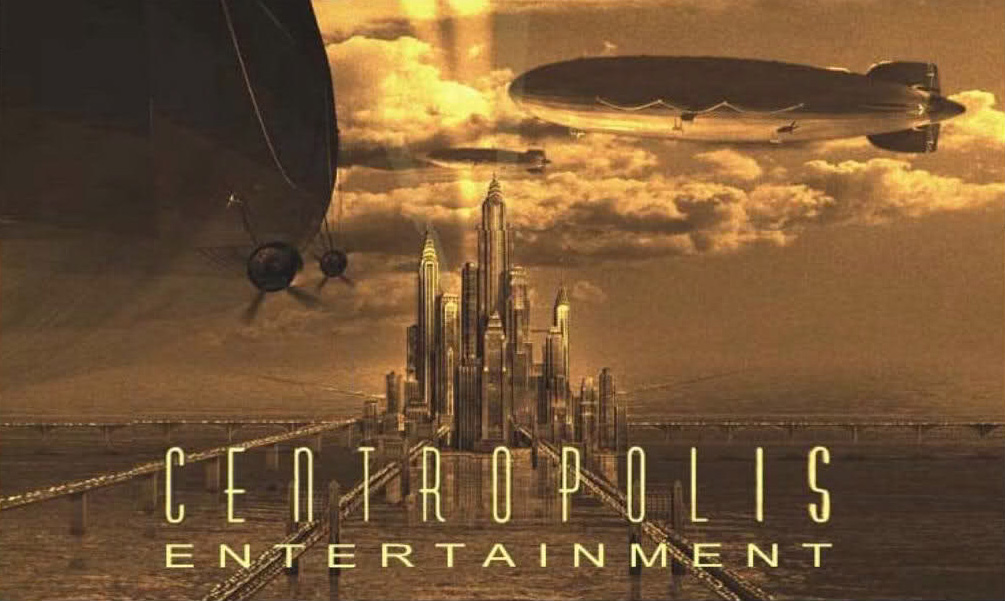 GODZILLA was intended as the start of a multi-film production deal between Sony Pictures and Centropolis Entertainment. © Centropolis Entertainment
GODZILLA was intended as the start of a multi-film production deal between Sony Pictures and Centropolis Entertainment. © Centropolis EntertainmentA deal was soon green lighted for Roland Emmerich`s production company, Centropolis Entertainment, to make GODZILLA for Sony Pictures. Emmerich and Dean Devlin were given creative freedom to write, produce and direct the film while TriStar would handle financing, distribution and merchandising deals. The Centropolis duo would also receive 15% first dollar gross on the film. Original GODZILLA producers Cary Woods and Robert Fried would be credited as executive producers on the film but Devlin and Emmerich would be the ones calling the shots. Woods later commented that, despite having a credit on the Emmerich/Devlin movie, he didn’t really feel he was a part of it.
And GODZILLA would only be the first step for the pair; Centropolis was also lined up for two sequels with options for additional non-Godzilla movies. "What John Calley has done is he`s set us up as a mini-studio to hopefully become for them one day down the line, their Amblin. It`s a real vote of confidence from the studio in that they`re basically trusting us to bring them tent-pole movies," Devlin told EON. GODZILLA would be the crown jewel of John Calley`s new Sony Pictures, with enough financial support for a large scale production and promotional campaign. "I consider their deal to basically be the cornerstone for this studio," Chris Lee enthused.48
Rob Fried was baffled that Sony`s management not only approved of Devlin and Emmerich`s take on GODZILLA, but had basically signed over creative control to Centropolis. “They had the wrong creative sensibility: they let Roland and Dean go," he complained. "There was no understanding of the property and what it was all about. They handed the keys to the studio to a couple of guys who happened to have a hit film.”49 But new TriStar Pictures President Robert Cooper believed in the duo`s track record of delivering big movies on a budget, arguing, "This is such a huge film, and doing a movie with such size at a price is an ideal situation. That`s what these guys bring to the party."50
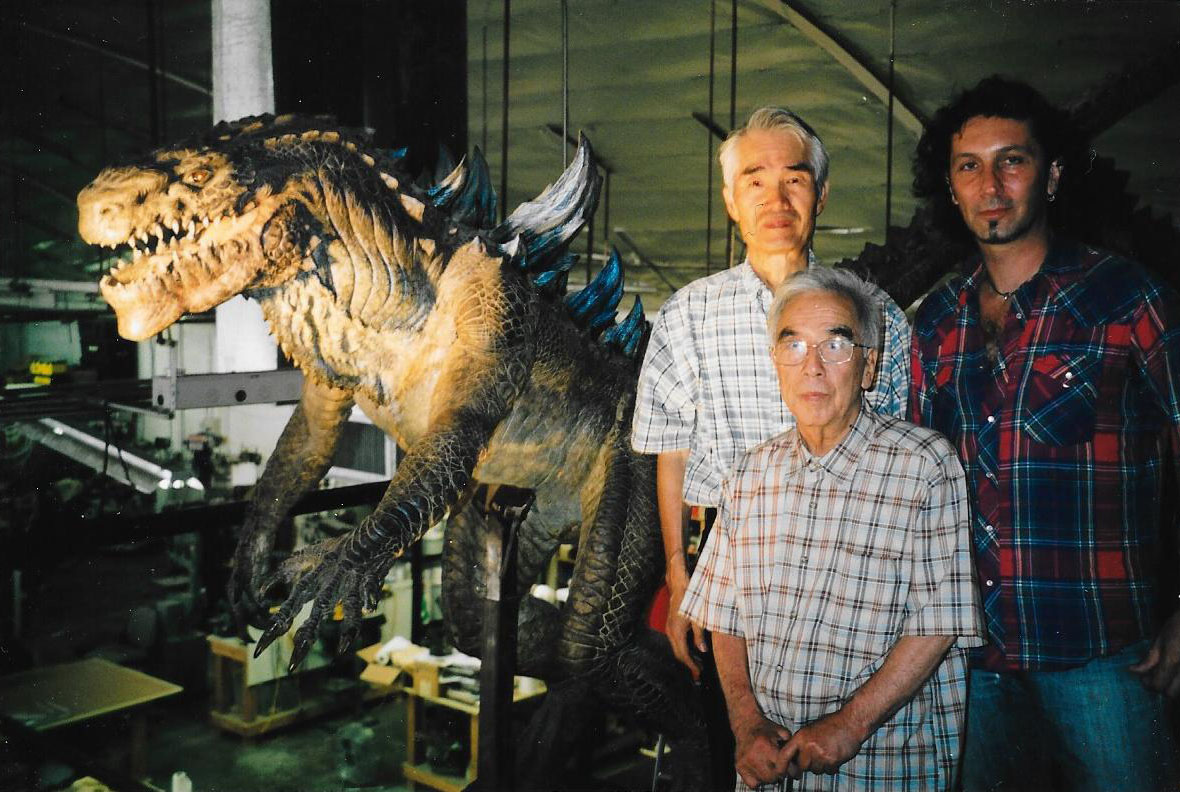 Toho FX artists Akinori Takagi and Yasuyuki Inoue with Patrick Tatopoulos and the 24th-scale Godzilla. © 1998 TriStar Pictures, Inc./ Toho Co., Ltd.
Toho FX artists Akinori Takagi and Yasuyuki Inoue with Patrick Tatopoulos and the 24th-scale Godzilla. © 1998 TriStar Pictures, Inc./ Toho Co., Ltd.Early estimates placed GODZILLA`s production costs in the range of $65 million, though those numbers were soon revised upward. "We`re going to try to do it for a shade under $90 million," Devlin revealed. "That`s more than ID4, which came in a shade above $70 million. This one is harder because it requires more mechanical effects, and CGI effects. "We hope to save money in other areas, because both Roland I are dead set against these $100 million budgets."51 Asked if they would be using Digital Domain, the digital effects house that had been contracted to work on Jan De Bont`s version, Devlin replied, "Whether or not that`s going to make economical sense for us to do that, I can`t say. We`ve always had a very good experience using our own people and developing our own special effects and not going to the top places in town, So far, I don`t think our quality has suffered at all."52
Emmerich and Devlin ended up reassembling much of the team they has used on INDEPENDENCE DAY, including Patrick Tatopoulos, visual effects supervisor Volker Engel, miniature effects supervisor Joe Viskocil mechanical effects supervisor Clay Pinney and executive producer William Fay. The assignment was a dream come true for Engel, who -- in his foreword for the official movie tie-in book The Making of Godzilla -- wrote about seeing Toho`s DESTROY ALL MONSTERS in a German theater with his father: "It was a revelation: I wanted to be part of the film industry. Life would never be the same again. I was seven years old."53
He continued, "When Japanese producer Tomoyuki Tanaka, director Ishiro Honda, and effects wizard Eiji Tsuburaya filmed the original GODZILLA in 1954, they created the classic monster movie. It is an honor for me to walk in Tsuburaya`s footprints, having the chance to use traditional effects and high-end computer animation at the same time to get the best of both worlds."54
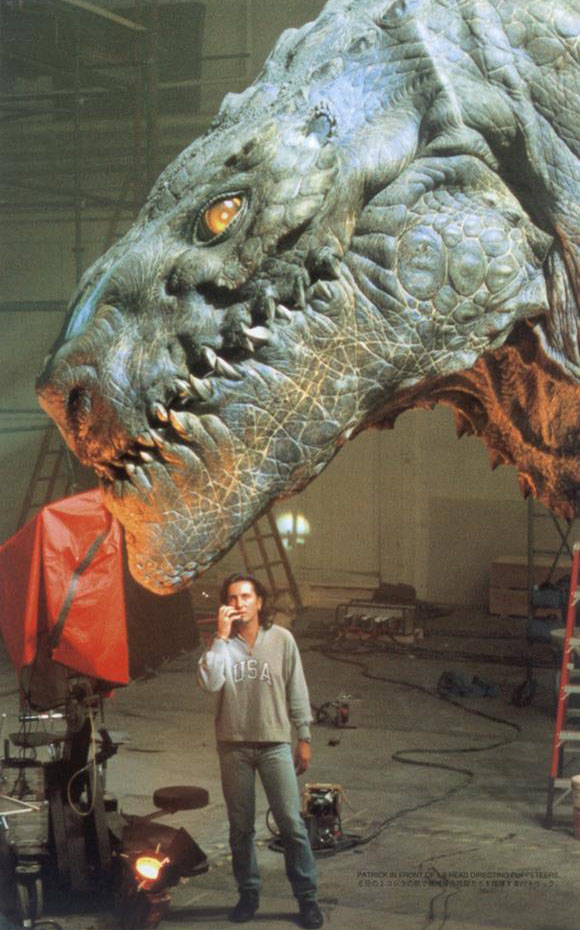 Patrick Tatopoulos with his 6th-scale animatronic Godzilla. © 1998 TriStar Pictures, Inc./ Toho Co., Ltd.
Patrick Tatopoulos with his 6th-scale animatronic Godzilla. © 1998 TriStar Pictures, Inc./ Toho Co., Ltd.Plans were for Godzilla and the Baby Godzillas to be realized onscreen through a variety of effects techniques. A digital Godzilla model -- nicknamed `Fred` by the crew -- was constructed by Viewpoint DataLabs for scenes involving CGI, while Patrick Tatopoulos` studio also built a 24th-scale Godzilla suit (worn by stuntman Kurt Carley) and a 6th-scale animatronic torso with head and arms for shots in which Godzilla had to interact with models and props.
But over time, many of the shots planned for the suit and animatronics were switched to CG. The film ended up with approximately 400 digital shots -- 185 featuring Godzilla -- while Tatopoulos` live action versions were only used for two dozen.William Fay noted that, "Even in those cases that would seem to be a natural for animatronics, we sometimes used CG. There was one scene where Godzilla`s chin scoops down and smashes into a roadway. We did part of it in CG because the motion of that swooping down was something we couldn`t really get with animatronics."
Volker Engel added that computer animation was more effective in portraying the monster`s movement. "This Godzilla is a very animal-like, fast-moving, fierce creature," he asserted. "With key frame animation, you`re 100% free; we can have the creature really move. To give it that really strange creature-feel in terms of motion, you really have to use key frame. We discovered that in the CG realm, for example, we can go a lot closer to the creature than we`d anticipated and it looks really good... really detailed."
The North American theatrical release of GODZILLA was set for May 20, 1998, the Wednesday before Memorial Day weekend (7:00pm advance showings would later be added for the night before). Sony Pictures` reasoning was obvious; that week had been considered prime for launching a movie since the original STAR WARS in 1977. More recently, the first installment of Tom Cruise`s MISSION: IMPOSSIBLE franchise had opened to $56.8 million in 1996 while THE LOST WORLD: JURASSIC PARK debuted with $90.2 million in 1997. By announcing GODZILLA for Memorial Day 1998, Sony was warning away any potential box office competition from rival studios. But staking a claim so far in advance also had its pitfalls. “They announced the release date -- Memorial Day -- so now the movie has to hit a date rather than allowing the movie to get made and be the best it could be,” said Rob Fried.55
One of Emmerich and Devlin`s first demands caught Bob Levin and his team completely by surprise: the pair insisted that Sony couldn`t use any full body images or head shots of the new Godzilla in marketing the film. "When GODZILLA started," Devlin explained, "Roland and I -- as fans now, not as filmmakers -- started complaining that there`d been a tendency recently in Hollywood to show the entire movie in a trailer. And this made us crazy. Look, you already know so much about GODZILLA. You know it`s a big lizard. You know it comes to a city. You know the military tries to kill it and they can`t... it`s in 22 other Godzilla movies. So we said, `What do we have in this movie? We have a new creature. You know what? Let`s not show it and give a reward to the people that come to the theater.`"56
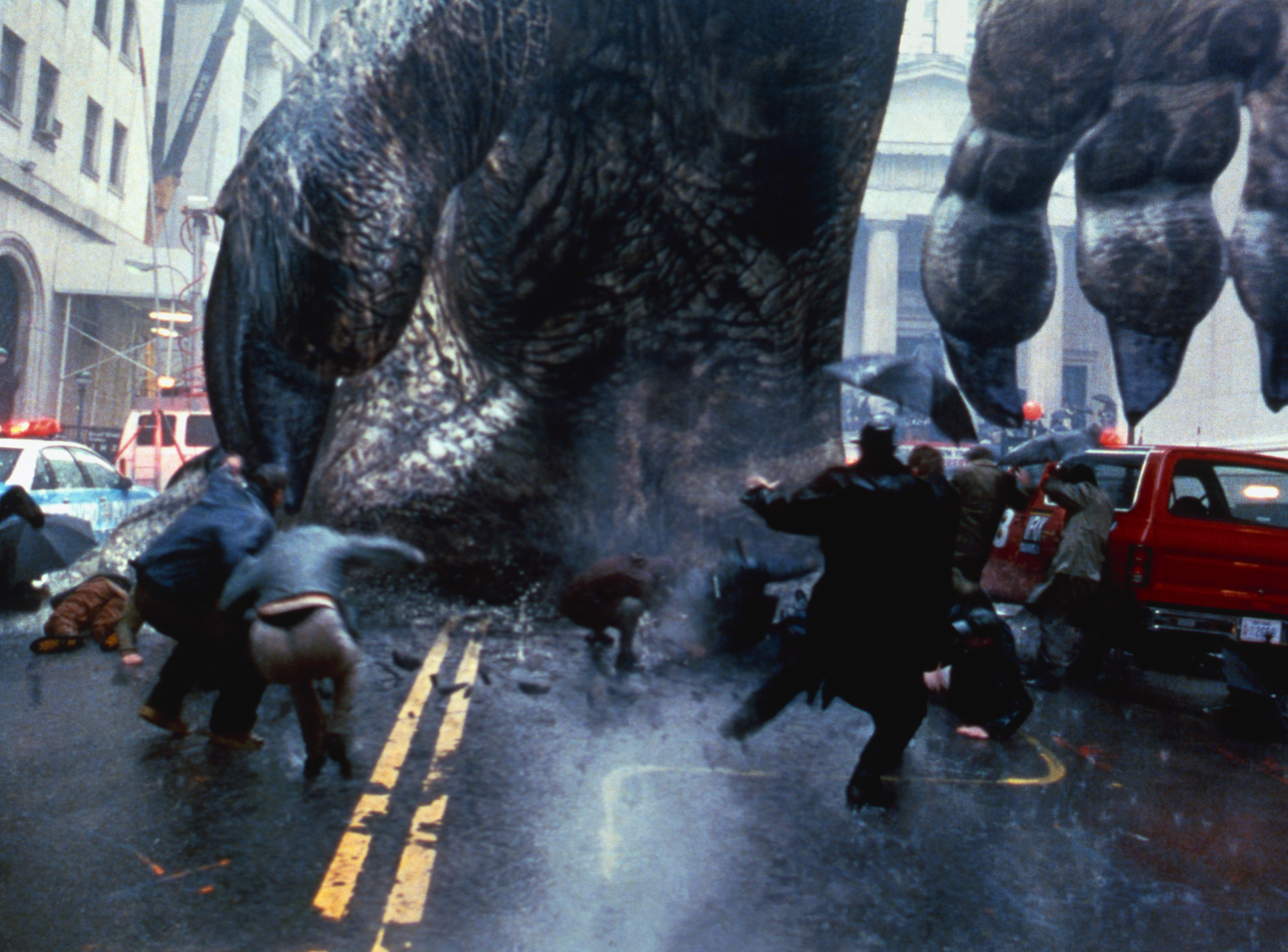 Devlin and Emmerich`s decision to keep the new Godzilla design a secret limited Sony`s marketing department to closeup images of the monster`s feet, eye and tail. © 1998 TriStar Pictures, Inc./ Toho Co., Ltd.
Devlin and Emmerich`s decision to keep the new Godzilla design a secret limited Sony`s marketing department to closeup images of the monster`s feet, eye and tail. © 1998 TriStar Pictures, Inc./ Toho Co., Ltd.While the idea had its merits -- the trailer for MISSION: IMPOSSIBLE, for example, gave away that movie`s ending -- the filmmakers plan for extreme secrecy was met with silence, then complaints. Emmerich recalled that, "All of a sudden somebody said, `What do we do about all the toy people? And all the merchandise?` The studio knew that if one picture came out, all the merchandisers would throw everything into the shops, and all of a sudden you`d see Godzilla in all of these toy versions before you`d seen the real thing. So that became another big story in the press. It was actually a nightmare when you think about it because you scramble to do your movie, and then you have to deal with that shit."57
"In the beginning," Levin said, "we got indications from them that they really didn`t think that the full figure Godzilla should be at all exposed prior to the release of the film. While initially we reacted negatively to that, once we understood their thinking behind it, it became completely acceptable to us."58 The marketing head tried to turn the concept to the film`s advantage, saying, "We’re generating excitement by keeping the look of the new Godzilla a closely guarded secret.”59
While the "you can`t show Godzilla" campaign caused some problems with potential licensees, in the end nearly 300 companies signed on with each agreeing not to display any products revealing the entire monster before the film opened in theaters. The $150 million promotion included approximately 3,000 GODZILLA tie-ins from the likes of Duracell, Kodak, Galoob, Hershey`s, Scholastic, Ero Industries, Dreyers, KFC, General Mills, The Bibb Company, Swatch, Equity Toys, Harper Collins, Giant, SRM, Kirin and Trendmasters. Taco Bell alone ponied up $60 million for an advertising campaign featuring their new gordita tacos, the company`s chief marketing officer Vada Hill exclaiming, "Godzilla and our chihuahua really love gorditas!"60
"There`s nothing close to the size and the scope of what this event is going to be in 1998," said DeWayne Booker, senior vice president of marketing for the Trendmasters, the company producing a line of GODZILLA toys.61
Roland Emmerich`s first directing assignment on GODZILLA was not for the film itself, but rather for a teaser that would debut almost a year before the movie`s release. Budgeted at $600,000, the trailer was a standalone piece with scenes that would not be included in the finished film. Set at the American Museum of Natural History in New York City it showed Godzilla`s foot crashing through a ceiling skylight to pulverize the skeleton of a Tyrannosaurus rex, ending with the film`s original tagline, "Guess who`s coming to town?"
Released with Columbia Pictures` MEN IN BLACK on July 2, 1997, the GODZILLA teaser elicited cheers and applause from audiences. The reaction was so overwhelmingly enthusiastic that some theaters began advertising that the GODZILLA trailer would be shown before screenings of MEN IN BLACK. The trailer also benefited from MIB`s tremendous success; the film would top the box office for 1997 and become the high grossing movie to that point in Columbia`s history, meaning the promo was also widely seen. GODZILLA had broken into the public consciousness in a very big -- and positive -- way.
Principal photography began in New York City in May 1997 with a cast headed by Matthew Broderick (FERRIS BUELLER`S DAY OFF, WARGAMES) Jean Reno (LEON, MISSION: IMPOSSIBLE), Maria Pitillo (CHAPLIN, TRUE ROMANCE) and Hank Azaria (THE SIMPSONS, THE BIRDCAGE). "New York is just brutal, as far as cost," said Devlin. "It`s a great city to shoot, it looks gorgeous, but it`s very expensive. The fact that we were able to get out of New York only one day over schedule was amazing. I attribute all of that to Roland. We were shooting for four and a half weeks. We were blocking off ten square city blocks at a time. It was a huge logistical nightmare trying to shoot in the city, plus the traffic jam we were creating. It was really hard to pull off."
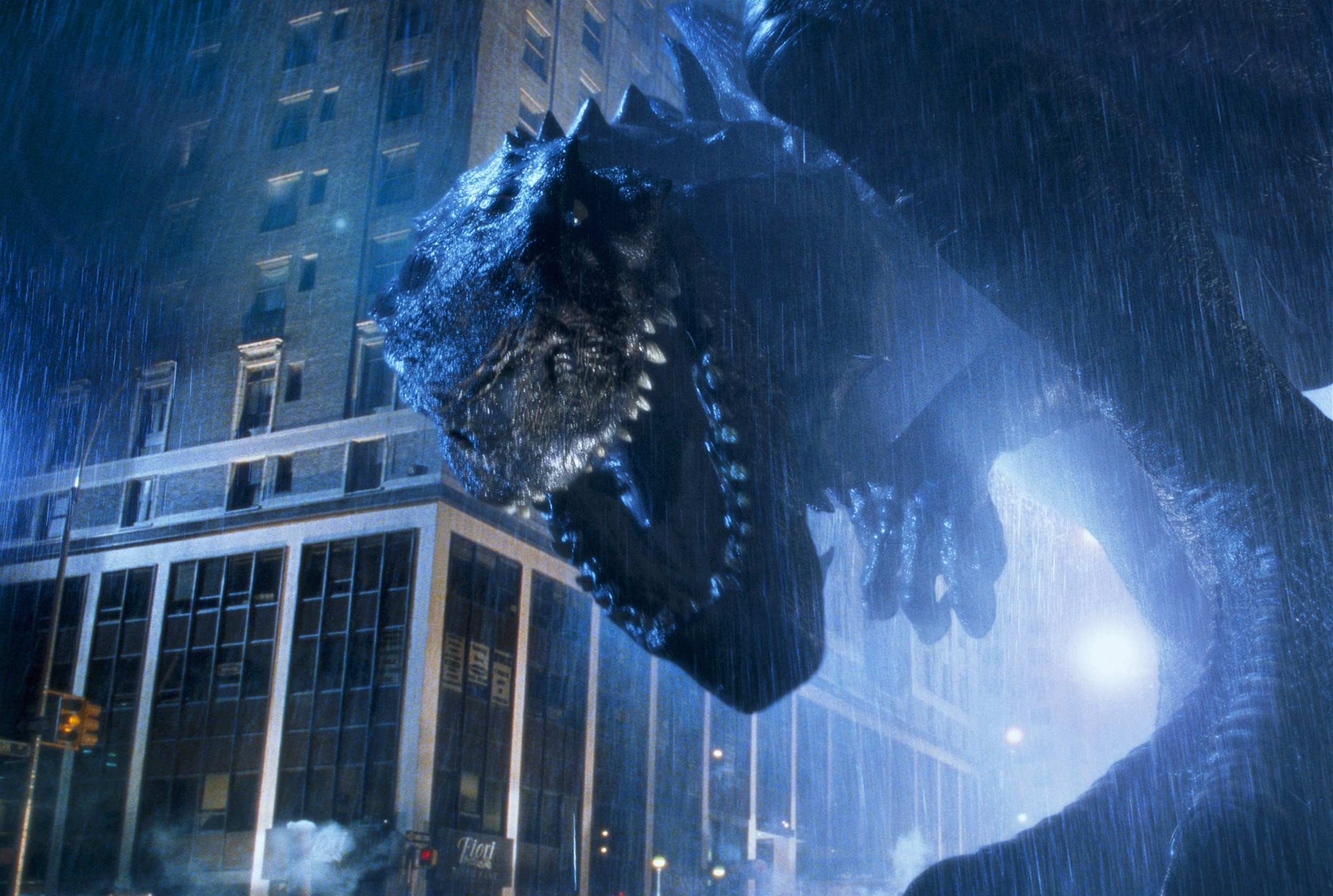 The filmmakers decided to set most of GODZILLA in the rain. © 1998 TriStar Pictures, Inc./ Toho Co., Ltd.
The filmmakers decided to set most of GODZILLA in the rain. © 1998 TriStar Pictures, Inc./ Toho Co., Ltd.Adding to the shoot`s difficulties was Emmerich and Devlin`s decision to set most of the story in the rain, which required the crew to set up artificial rain machines. "Most of the film is at night and in rain, so that even when the audience sees Godzilla, they don`t get a clear view of it," Devlin explained. "The look, with the darkness and the rain, is much grittier than anything we`ve ever done before, and we hope that this will help augment the mystery and danger of Godzilla. Sometimes, what you don`t see is almost more terrifying than what you do see."
Emmerich was exasperated by criticism that the rain was done to hide flaws in the visual effects. "People were saying, `Oh, there`s a lot of rain so they don`t have to show him so it`s like cheapero.` No, other way around. It`s more expensive because you have to composite layer upon layer of rain. You wouldn`t believe how many discussions we had. We had never-ending discussions about rain," he insisted.
Devlin claimed the idea was inspired by Toho`s 1954 GODZILLA, saying, "If you look back to the first GODZILLA movie, almost all of it was at night. Almost all of it was in the rain." He repeated this statement to multiple press outlets, missing that only one early scene in the original film had been set in the rain.
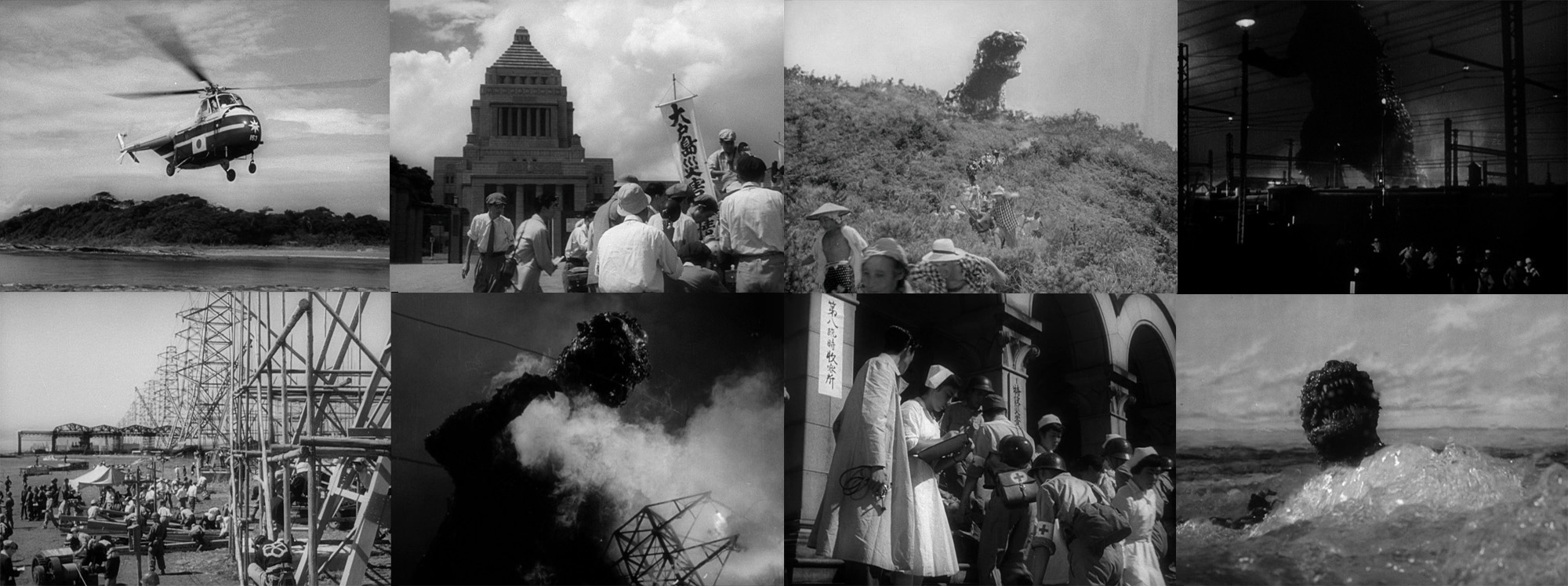 Dean Devlin told reporters the constant rain in his GODZILLA was inspired by the original Toho film, incorrectly stating that,
Dean Devlin told reporters the constant rain in his GODZILLA was inspired by the original Toho film, incorrectly stating that, As production on GODZILLA continued, the buzz for the film began to take a negative turn. Godzilla fans in particular were growing increasingly concerned over the secrecy surrounding the movie, as well as the few details and many rumors that were being reported in the months leading up to the movie`s release. These worries were only exacerbated by comments made by multiple members of the GODZILLA crew, which offered little respect for the Toho movies and made it clear the new Godzilla would have little resemblance to the character fans wanted to see.
"Physically, it`s totally different. When you look at our Godzilla, you won`t feel any nostalgia," Dean Devlin told CNN. During a press junket while filming in Oahu, Hawaii, the producer said, "It`ll look like Godzilla but be more realistic, more to the lizard genesis than just a big fat guy in a rubber suit."62
Roland Emmerich modestly called his GODZILLA "the ultimate monster movie", telling reporters that he was initially reluctant to make it, but, "It was one of these things where it suddenly hit you that it could be cool. But only if you changed it totally."63
John Calley stated, "The present version has survived 20 incarnations. What we`re going to do is a lot more flamboyant, a lot more astonishing."64
Volker Engel said he was inspired to become an FX director by the Godzilla movies he had seen as a child. But when interviewed for the new film`s official website, Godzilla.com, he knocked those same movies, stating that, "Godzilla has always been this slow-motion man in a suit, and always standing around, looking around, smashing through buildings, looking kind of stupid."
Co-producer Peter Winther disregarded fan concerns, believing that what audiences really wanted was Devlin/Emmerich`s re-imagining of Godzilla instead of something closer to the original. "The main thing for Roland and Dean was to bring Godzilla into the present time. And to do that, you have to do some things to make it realistic," he insisted. "But there are certain things you want to keep, otherwise it`s not Godzilla. You have to make it a little more violent and you have to make it faster. No matter what people say, you don`t want to have this creature lumbering down the street, making him easy to hit with missiles and things like that. It has to be more exciting. You have to give people the ride they`re looking for."65
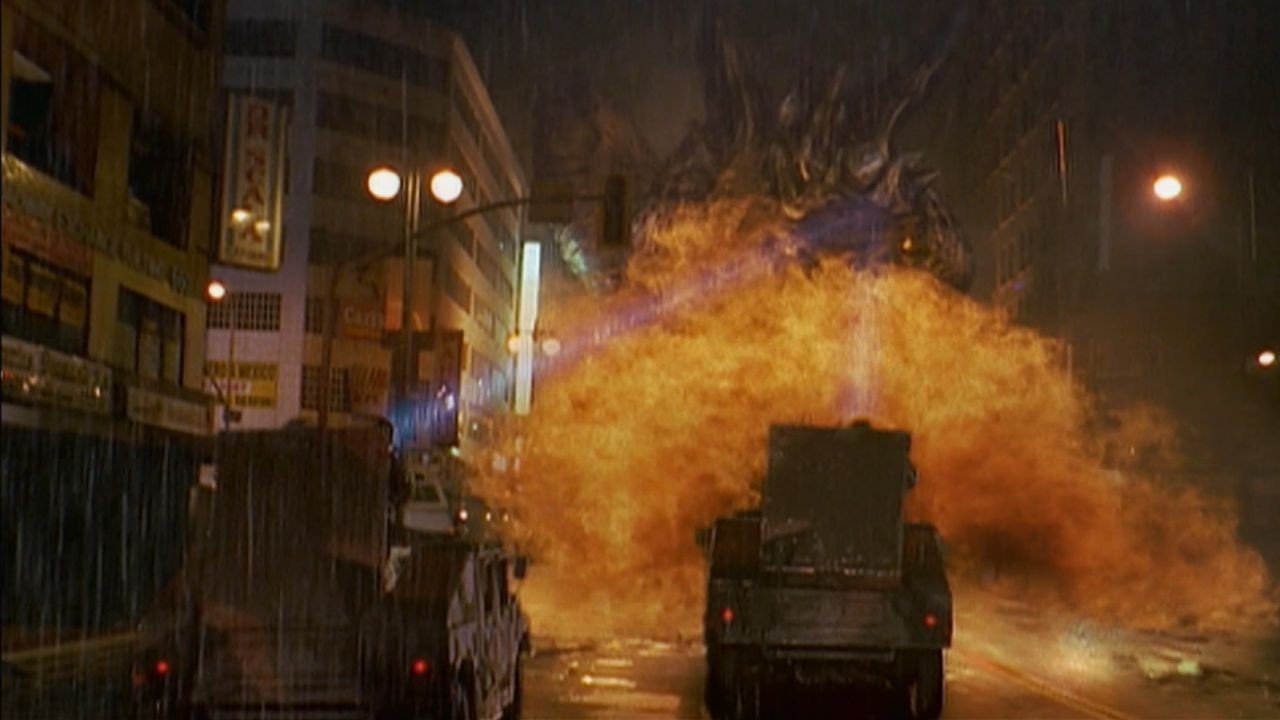 Godzilla`s fiery breath was a late change made to appease Toho fans. © 1998 TriStar Pictures, Inc./ Toho Co., Ltd.
Godzilla`s fiery breath was a late change made to appease Toho fans. © 1998 TriStar Pictures, Inc./ Toho Co., Ltd.But Godzilla fans were not happy to learn that "the ride they`re looking for" would replace Godzilla`s radioactive breath with gusts of air. They voiced their displeasure with phone calls, letters and emails to Sony Pictures and Centropolis, convincing Dean Devlin and Roland Emmerich to make last minute changes to two shots in which Godzilla used his new power breath.
"Dean and Roland wanted this monster to retain a certain menace and credibility, but Godzilla`s breath is something everyone expects to see at some point," Volker Engel admitted. "So they came up with instances in which you would see something like the old breath, but with a kind of logic applied to it. We make the assumption that something is his breath, when it comes in contact with flame, causes combustive ignition. So you get this flame-thrower effect, which causes everything to ignite."66
Roland Emmerich provided his own explanation to TNT ROUGH CUT, saying, "We kind of thought of it like gas, all fishy, swallowed then thrown up again. It kind of like creates a gas and glows with an incredible force. The original one is more this ray than fire breath; it`s a green ray coming out of the mouth. It`s almost an undefined color."
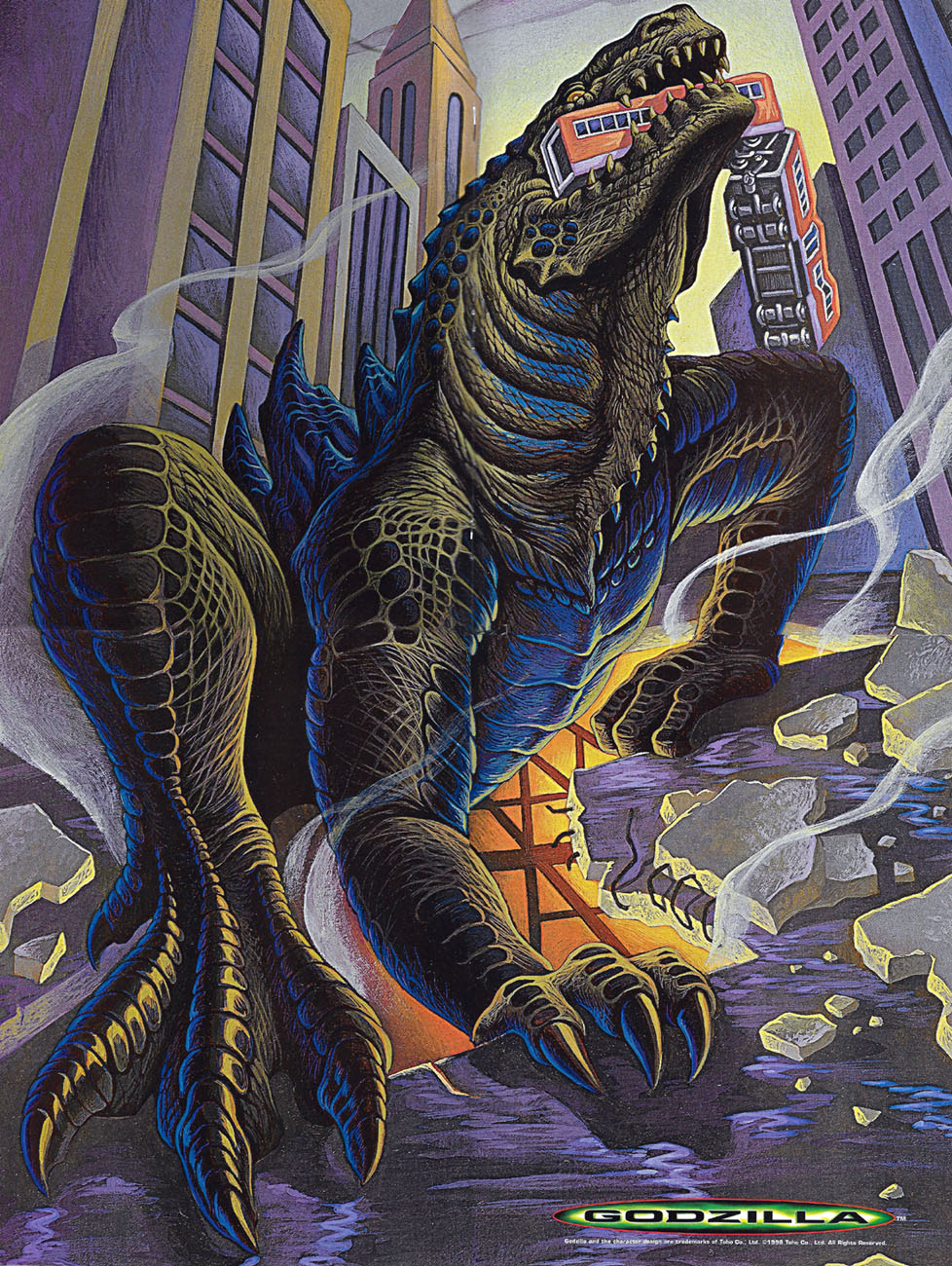 Dean Devlin told fans that leaked GODZILLA images were fakes, but the same designs were later used on products from the movie. © 1998 TriStar Pictures, Inc./ Toho Co., Ltd.
Dean Devlin told fans that leaked GODZILLA images were fakes, but the same designs were later used on products from the movie. © 1998 TriStar Pictures, Inc./ Toho Co., Ltd.But the early complaints were nothing compared to the backlash when fans saw the new Godzilla design. Despite Centropolis and Sony`s efforts, images of GODZILLA merchandising artwork and sculpts leaked online in late 1997. Fans reacted with extreme negativity to the changes made to the monster`s look, prompting Dean Devlin to engage in some damage control. "We did put out five sets of fake drawings," he said, explaining that the images were used to ferret out leaks from licensees. Two companies -- Tiger Electronics and Fruit of the Loom -- had their licenses to make GODZILLA products revoked, but the supposedly "fake" pics were later revealed to be accurate depictions of Patrick Tatopoulos` Godzilla redesign.
As the bad buzz grew, Toho attempted to assuage fans` fears about the upcoming film. "We have heard stories about the interest in the new design for Godzilla," Toho publicist Masahiko Suzuki stated. "TriStar has shown Toho the final design and received approval. We think TriStar knows its American viewers and what will make them happy. Out of respect they consulted with Toho, so we could see what they were doing with their design." "When Godzilla was first made, 44 years ago, he was a bad guy who went around destroying things. Over the years Godzilla became popular with Japanese viewers and gradually became a good guy everyone liked. Over the course of the series, the viewers naturally built up a sense of affection for the beast and the natural flow was for him to become a good guy. So, even though the new Godzilla will have a different role, it is consistent with the original concept," he asserted.67
Dean Devlin echoed Suzuki`s views, saying, “I think that when the real fans see this movie they’re going to realize that, yes, this is not like the sequels but it is very much in the spirit of the first Godzilla movie." He added that his GODZILLA, "is probably more true to the original vision of the first movie than any of the other 21 sequels," and that, "In essence, we feel that it is more respectful to have a new creature than to mess around with the old one.”
 The footprint examination scene was one of the film`s few nods to the original GODZILLA. © 1998 TriStar Pictures, Inc./ Toho Co., Ltd.
The footprint examination scene was one of the film`s few nods to the original GODZILLA. © 1998 TriStar Pictures, Inc./ Toho Co., Ltd.Devlin also attempted to offer a connection to the Toho films, but unfortunately got his facts wrong. "The original title was a combination of the Japanese word `God` and the Japanese word for whale," he said incorrectly (the first syllable of the monster`s name is actually derived from `gorira`, the Japanese spelling of gorilla). "I don`t want to spoil the best gag in the film, but in the picture he`s originally called Gojira but then it gets bastardized in a humorous way."68
Even Roland Emmerich tried to offer additional links between his movie and the Toho Godzillas. "Many of the elements in our movie, like the scientists trying to discover how to destroy him or the military trying to blow him to kingdom come, is all from the original film," he asserted in an interview with the British magazine SFX.
The publicity campaign for GODZILLA continued with a second trailer, released November 7, 1997 with TriStar`s STARSHIP TROOPERS. This trailer featured the infamous "Size Does Matter" tagline that would later come back to haunt the film and its makers. Devlin recounted how the reference came to be associated with GODZILLA: "A very legitimate question was raised by the marketing people. They said, `If I`ve already seen JURASSIC PARK, why do I need to see GODZILLA? Haven`t I already seen the big lizard movie?` And that`s when a very clever marketing executive said, `Well, size does matter.` And so we put it in the teaser and sure enough it got huge laughs."69
Marketing also came up with the the second most famous promotion for the film: the "He`s as big as" campaign. Dana Precious, Sony`s senior vice president of creative advertising, revealed that she found -- without being able to use any photos of Godzilla -- it very difficult to convey the monster`s size to the ad agencies working with her on the film. Realizing this would also be an issue for potential ticket buyers, she decided the most effective solution was to offer a visual reference point for comparison.
For eight months, Precious and her team reviewed billboard space in twelve cities, selecting key locations to post slogans such as "He`s as tall as the Brooklyn Bridge", "He`s as long as five train cars", "His foot is a long as this bus" and "He`s as long as the Hollywood sign." She felt the campaign would create the impression of a truly massive and stunning monster, saying, "Sometimes the imagination is so much better than seeing it, even if the thing you`re going to see on film is going to be very spectacular."70
Despite Emmerich and Devlin`s intentions to make GODZILLA for less than $90 million, the film ended up costing considerably more. "Well, let`s put it this way, we spent a lot more money on this movie than we wanted to," Devlin admitted. "I`m not proud of it. I`m not going to go running around bragging about it."71 TriStar listed an official budget of $136 million, but Robert Fried put the actual budget at $150 million with an additional $80 million spent on worldwide marketing.72 According to The Wall Street Journal, GODZILLA would need to earn at least $240 million at the domestic box office to be successful.
But, regardless of the higher costs or the grumblings of hardcore fans, tracking numbers for the Devlin/Emmerich GODZILLA were showing the potential for a massive hit. Surveys showed a 95% awareness of the film with the general public, with National Research Group polls placing GODZILLA`s "want to see" ranking in the blockbuster zone.
Sony Pictures used the tracking numbers to leverage more from theaters that wanted to screen GODZILLA. Studios and theaters generally split profits from movie ticket sales on a sliding scale... first the theater deducts the "house allowance" (the operating costs for the theater) and then the remaining money is divided between the theater and the studio. While the numbers often varied, the studio would generally get 60-70% of the profits in a movie`s first week of release, with the numbers shifting more and more in the theater`s favor each week a film plays. But Sony demanded 80% of GODZILLA`s first week profits, 75% for week two, and 70% for weeks three and four, with a minimum guarantee of $4 million.
Theater owners balked at the increases but eventually agreed to pay Sony a higher percentage than was the norm. "80% was never an across-the-board [number]," disclosed Jeff Blake, Sony`s vice-chairman of worldwide marketing and distribution. "We kind of used it to send a message to theaters that this is going to be a big deal. They sent back the message to us that there`s going to be a limit. No one`s paying less than 70% for the first two weeks. Most are paying that level for the first three or four weeks of the movie, which is a rich deal. Clearly the demand is there."73
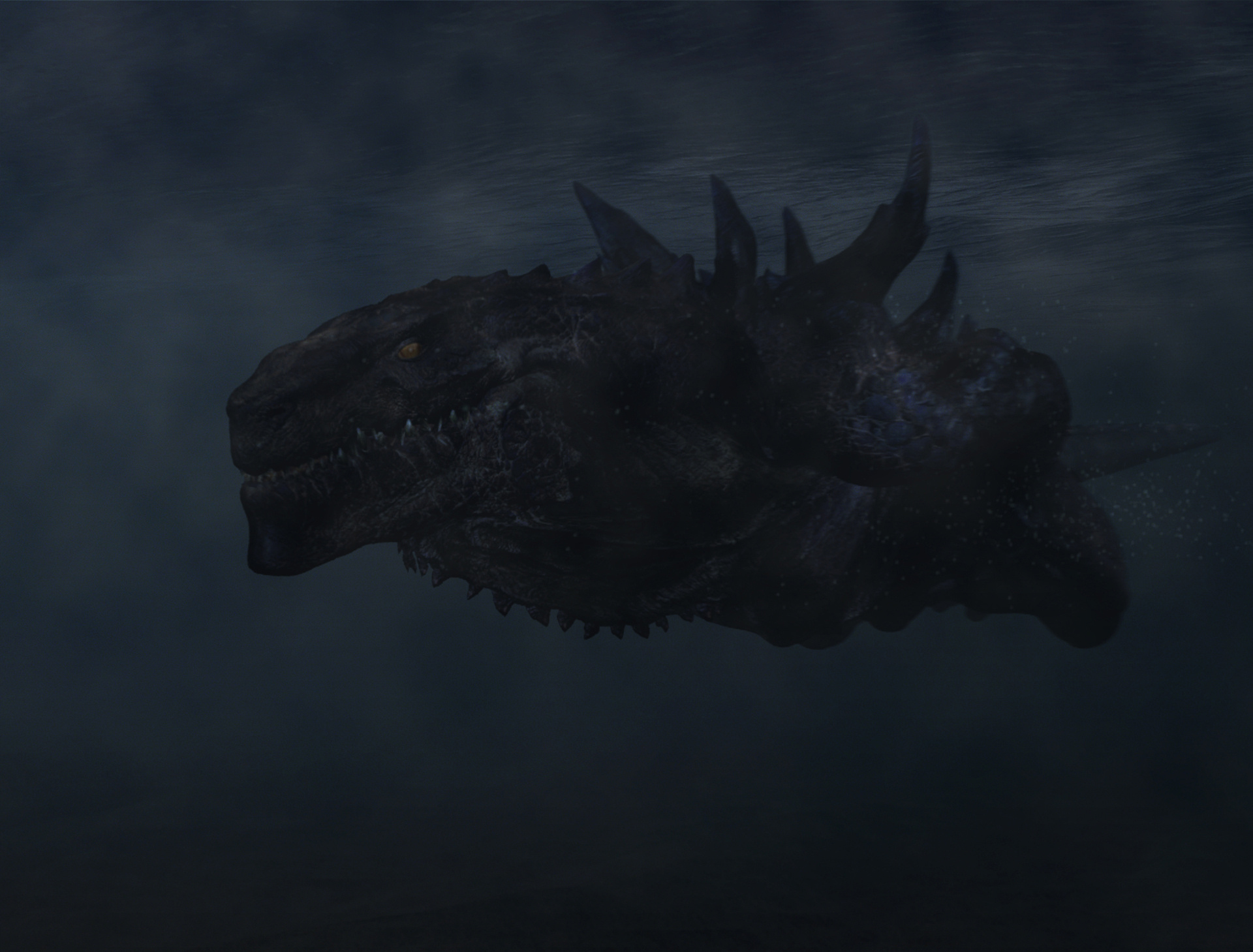 Godzilla attempts to escape the military by swimming away. © 1998 TriStar Pictures, Inc./ Toho Co., Ltd.
Godzilla attempts to escape the military by swimming away. © 1998 TriStar Pictures, Inc./ Toho Co., Ltd.GODZILLA was set to open on 7,363 screens in 3310 cinemas, approximately ¼ of all movies screens in North America. The numbers easily surpassed the 6,190 screens for THE LOST WORLD: JURASSIC PARK, giving GODZILLA a clear shot at an even bigger box office debut. Rival studios took note, scheduling their movies weeks before or after GODZILLA`s launch to avoid being steamrolled at the box office. "[GODZILLA] has a chance to do $100 million the opening weekend," said Walt Disney Co. studio chairman Joe Roth, whose own ARMAGEDDON would be released that July 1st.74
Confident they had a hit on their hands, Sony Pictures made a $5 million payment to Toho for a GODZILLA sequel. The option guaranteed Sony the rights to make a second Godzilla movie as long as it was in active development within five years of the first film`s release. "We sort of look at this not simply as the launching of a movie, but the launching of a franchise called GODZILLA," Bob Levin explained.75
"We have a GODZILLA trilogy in mind," Devlin revealed. "The second one is remarkably different from the first one, and if it`s embraced, a third one would make a whole lot of sense. I don`t see us doing more than three, but I would love to finish out telling the story."76
GODZILLA lead actress Maria Pitillo found the buildup to the film`s release a little overwhelming. "I hear so much hype I don`t even know what to expect. I`ve never been involved in anything like this," she said. "God help us if we don`t live up to the hype, right?"77
REACTION
"It was disappointing from my standpoint that the film that was actually made essentially took the monster out of the script and changed the design so radically that it was just unrecognizable." --GODZILLA (1994) concept artist Ricardo Delgado
"Run, you f**kers! It`s a giant f**king lizard!!!" --GODZILLA (1998) writer/director Roland Emmerich
As the May 20th release drew near, the buzz for GODZILLA continued to build. The Hollywood Reporter`s 1998 Box Office Preview issue stated the film was on track to become one of "the best-performing pictures of all time, suggesting the potential for an awesome opening frame." The hype was a double-edged sword for co-producer Peter Winther. "It`s a different pressure than when we worked on INDEPENDENCE DAY because we kind of came out of nowhere on that one. Everyone assumes we`re going to deliver a great product," he said.1
Behind the scenes, the big issue was that GODZILLA`s special effects were running far behind schedule. In the final weeks before the film`s release the digital effects team was running 24 hours a day, staffers crashing out at the office in sleeping bags between shifts.
The delays meant that GODZILLA couldn`t be screened for exhibitors, reviewers or even studio executives. Sony Pictures president John Calley was frustrated that he hadn`t seen the film, while marketing head Bob Levin had his own concerns. "I was getting increasingly uneasy about the fact that we couldn`t show the movie because it wasn`t ready, yet there we were, seeming to boast about how brilliantly we were selling it," Levin disclosed. "I always fear how easily the audience may turn against us if they are kept in the dark too long."2
Sony offered to push back the movie`s release date, but Dean Devlin and Roland Emmerich believed they could make the deadline and wanted to honor their commitment to the studio. The last FX shots for GODZILLA were completed and a final cut assembled just in time for the May 18th premiere/media screenings at Madison Square Garden in New York City and the Cineramadome in Los Angeles. "[With] GODZILLA, we literally finished the cut and went to the printer," Devlin recounted. "And we didn`t even have a chance to screen it for the studio. It was just like, ‘We have to go. We`ll never make enough prints to get them into the theater in time if we make any adjustments`."3
GODZILLA was finally unveiled to the public, and the initial audience reaction was one of extreme disappointment. Among the attendees at the LA screening was reporter and Godzilla fan Richard Pusateri, who described the new Godzilla as GINO ("Godzilla In Name Only") in his review of the film. The nickname quickly caught on in fan circles. Looking for a silver lining, one Sony publicist noted that the top reviewers and media outlets were away attending the Cannes International Film Festival in France: "Thank goodness we`ve just got the second and third-string critics here. They can do less harm."
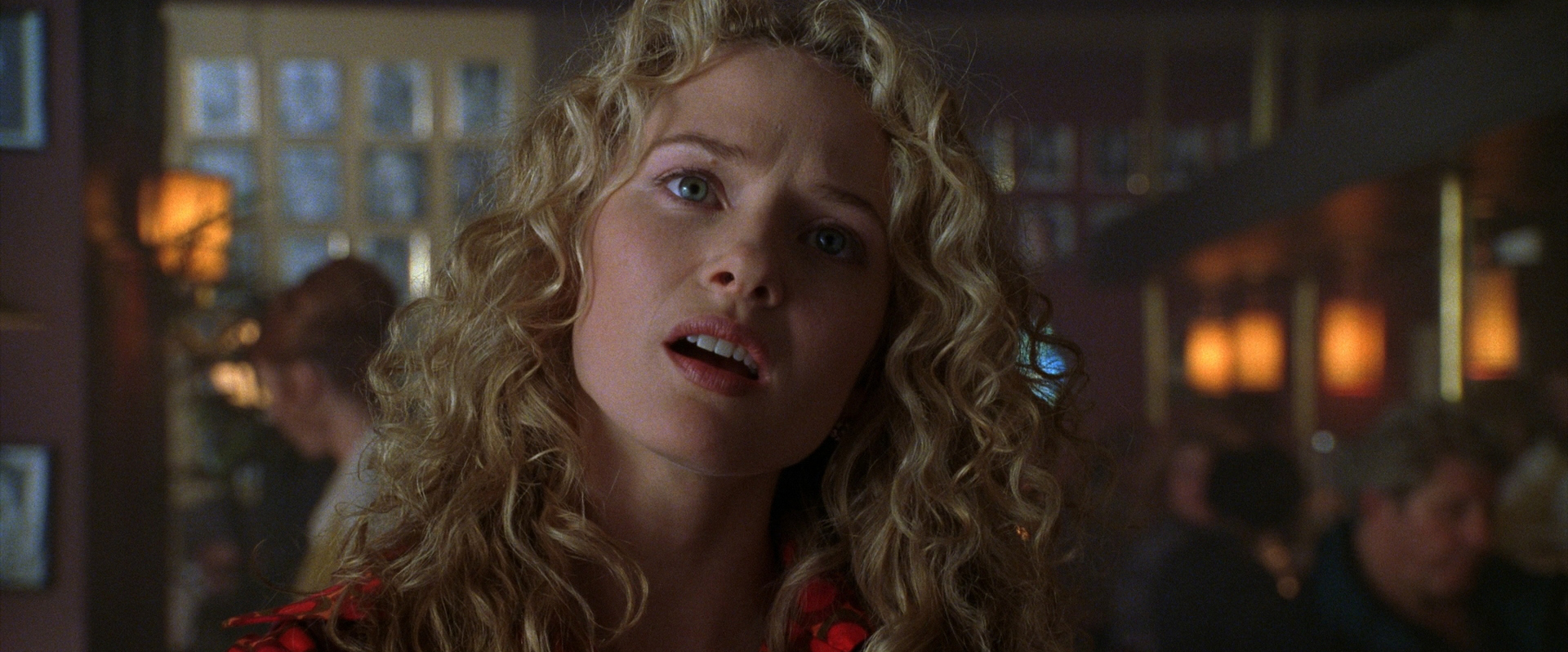 John Calley was reportedly critical of the performance by GODZILLA`s lead actress, Maria Pitillo. © 1998 TriStar Pictures, Inc./ Toho Co., Ltd.
John Calley was reportedly critical of the performance by GODZILLA`s lead actress, Maria Pitillo. © 1998 TriStar Pictures, Inc./ Toho Co., Ltd.Sony Pictures executives were also far from enthusiastic by what they saw, but knew there was absolutely no time left for them to make any alterations to the film. John Calley was reportedly furious with the situation. "John wanted to re-voice the girl [Maria Pitillo, whose performance would be roundly criticized]," one studio rep revealed. "He had a list of changes he felt would have vastly improved the movie, but he had no time to do anything."4
"We were so determined to make this date that we built a schedule where we couldn`t screen-test, and we should have. I think we really could have improved the film," Devlin admitted. "This is the first film we ever put out that we didn`t have time to test screen, and every film we`ve ever done we improved tremendously over the test screening. With INDEPENDENCE DAY, for instance, the whole ending was reshot."5
TriStar opened GODZILLA on schedule, and the picture topped the box office for its first week in theaters. But the numbers were disappointing; Sony expected a $100 million haul for the Memorial Day weekend that would break the $90.2 million record set by THE LOST WORLD: JURASSIC PARK the year before. GODZILLA instead earned $55,726,951 over the four day weekend with a week 1 total of $74 mil, well below industry predictions. To make matters worse, the poor reaction from media screening attendees was soon echoed by the majority of critics and general audiences who saw the film in its first few days of release.
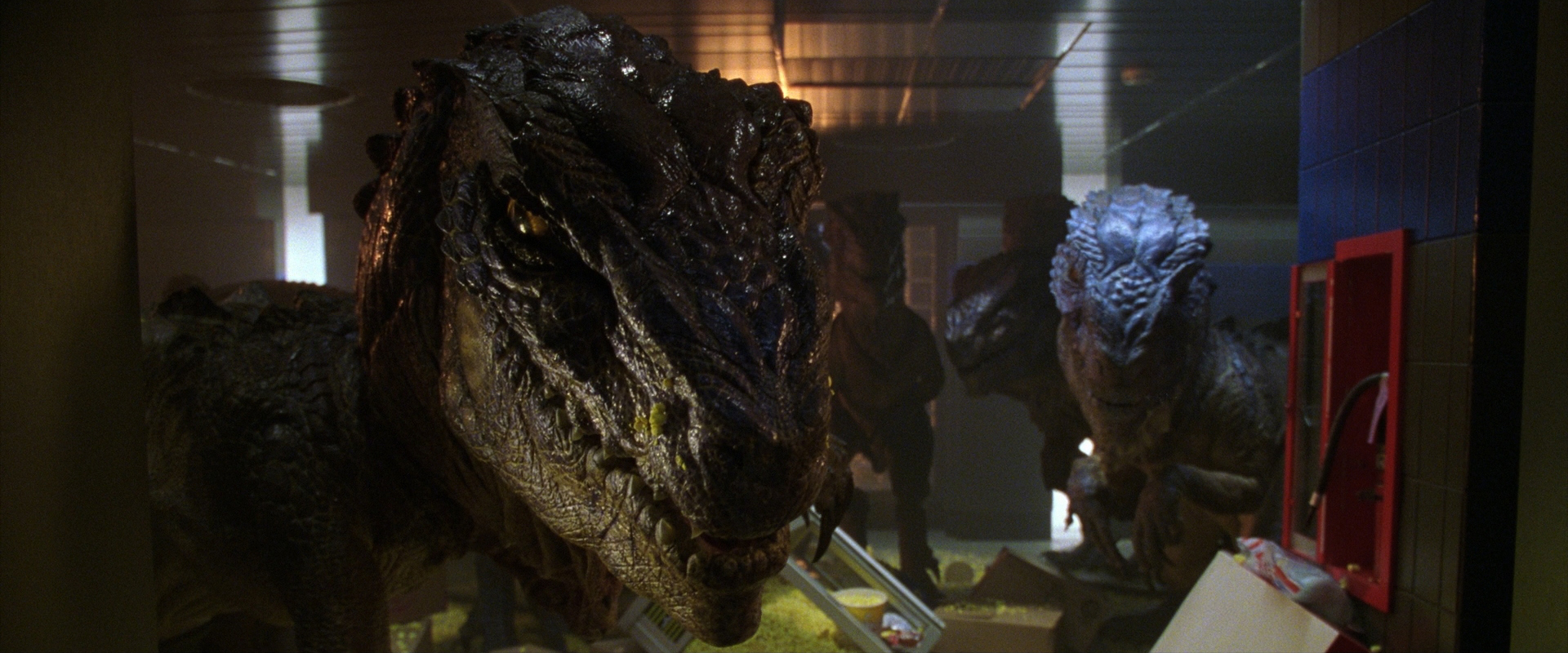 Moviegoers found the Baby Godzilla sequence derivative of JURASSIC PARK. © 1998 TriStar Pictures, Inc./ Toho Co., Ltd.
Moviegoers found the Baby Godzilla sequence derivative of JURASSIC PARK. © 1998 TriStar Pictures, Inc./ Toho Co., Ltd.Moviegoers disliked the film`s story and acting, the weak attempts at humor, and the blatant copying from other films -- in particular the "Velociraptors in the kitchen" sequence from JURASSIC PARK. They were also critical of the new Godzilla design, with many finding it a poor substitute for the classic Godzilla. "The ultimate look of the creature, while interesting, was not unique relative to what we had seen in JURASSIC PARK, and I think consumers were let down," observed Robert Fried.6
Jan De Bont believed that the entire approach taken to Godzilla had been wrong. "It’s like a T-rex. The eyes are completely wrong, the fins on the back didn’t glow white. There are a lot of things that you cannot just change... if you change them you might as well make another movie. You’re not suddenly going to have Batman without the cape or without the mask. That’s ridiculous," said the director. "So many facets of a T-rex were transferred to Godzilla, and Godzilla is not a T-rex. He doesn’t run as fast and he doesn’t move as fast. There’s something of this constant power coming at you... if you do it too fast it looks kind of silly."
"And the scale of Godzilla changed many times... he was bigger, he was smaller. And it all had to do with the sets that were there. That’s not a good thing; if he’s too big he should look too big. If he’s that big, don’t make him look smaller to fit in Madison Square Garden. Don’t make Godzilla fit the set, make him as big or as small as he would be in scale."
"It’s not so much even Roland. He did the movie he wanted to do," De Bont remarked, feeling Sony was ultimately responsible for allowing the production to go so far off course. "It’s so unfortunate that the studio let Godzilla down and let us down, but it’s a business and the people at the top don’t always make the right decisions."
"Sony rejected Jan`s budget, then a few years later made the movie with Emmerich for $10 million more. And it was terrible," said John Frazier, who had been signed to create the mechanical and practical effects for De Bont`s GODZILLA. "When we worked with Sam Raimi on the SPIDER-MAN films were stayed faithful to the source material; and that`s what we did with GODZILLA. We were going to make a Godzilla movie, and Roland didn`t do that."
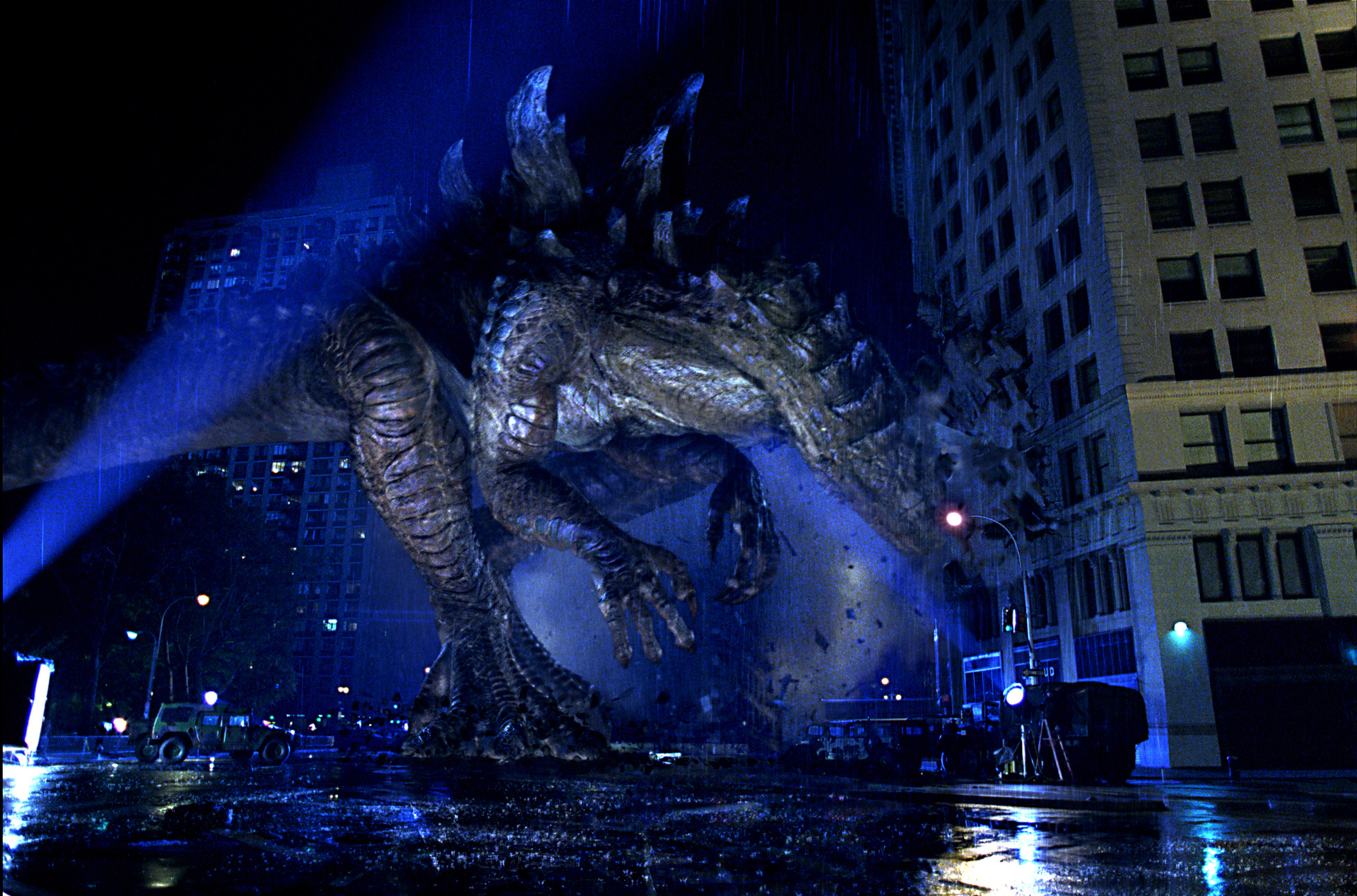 Godzilla runs away from the military; a fundamental creative misstep by Emmerich and Devlin. © 1998 TriStar Pictures, Inc./ Toho Co., Ltd.
Godzilla runs away from the military; a fundamental creative misstep by Emmerich and Devlin. © 1998 TriStar Pictures, Inc./ Toho Co., Ltd.Original GODZILLA screenwriter Terry Rossio agreed. In his essay "The One Hundred Million Dollar Mistake" he described Devlin and Emmerich`s GODZILLA as a perfect example of "when a decision gets made that is so bad, so fundamentally wrong, so devastating to the project, that no amount of time, hard work, inspiration or money can repair the damage." He wrote...
People wanted to be scared of Godzilla, but they also loved him and wanted to root for him. So you let Godzilla stomp into the film, all scary like, then bring on some other big monster for him to fight, so the audience gets to cheer, and then let Godzilla kick ass, swing that big J-Lo tail around... and if a few buildings get smashed in the brawl, hey, that`s the price we pay for having the lovable lizard defending our earth. And there`s your Godzilla movie. You`re scared, you`re excited, Godzilla kicks ass, you cheer, and bring on the sequel. Dean Devlin and Roland Emmerich, I`d argue, screwed it up. Godzilla became a mom who wanted to go lay eggs in New York City. And when military guys fired guns at him, Godzilla would... I can`t believe it even as I type it... Godzilla would actually squeal, turn, run and hide. Squeal... run away... and hide. In a Godzilla movie. Basic approach: wrong.
In week 2, GODZILLA suffered a stunning 59% drop in attendance, taking in only $18,020,444. Ed Mintz, president of the audience polling company CinemaScore, told the Associated Press that, "There`s no repeat business. There`s no word of mouth. It`s going to drop... and be gone."7 Mintz`s analysis was borne out as the following week saw another 46% decline. It eventually took fourteen days for GODZILLA to reach the $100 million mark it had been expected to hit on the first weekend.
GODZILLA was widely derided as a failure, a punchline for the press and members of the film industry. "I`ve been around a long time, but the mean-spiritedness of the response took me by surprise," declared John Calley.8
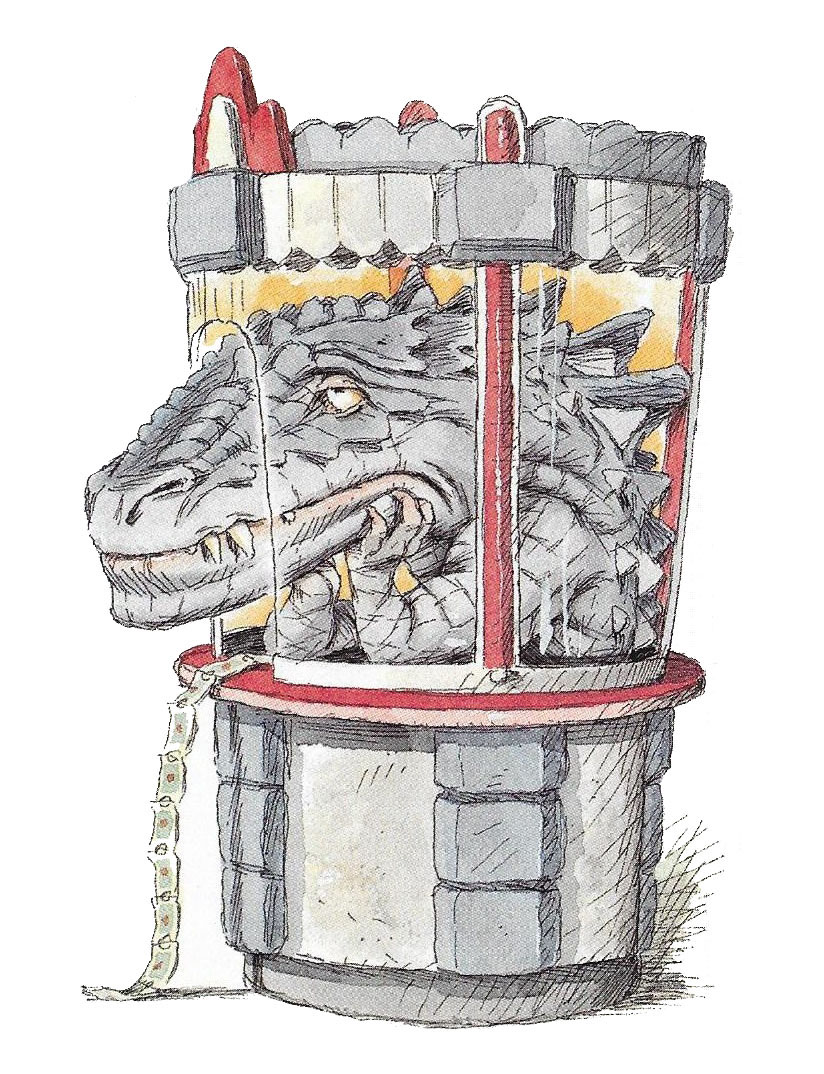 Entertainment Weekly illustration mocking GODZILLA`s steep drop in ticket sales. © 1998 TriStar Pictures, Inc./ Toho Co., Ltd.
Entertainment Weekly illustration mocking GODZILLA`s steep drop in ticket sales. © 1998 TriStar Pictures, Inc./ Toho Co., Ltd.By June 15th, Sony admitted they would be pleased if GODZILLA earned $140 million in North America, half the amount originally projected for the film. But even the reduced figure proved too high; GODZILLA wrapped its theatrical run at $136,314,294. Once heralded as the surefire top movie of the year, it ended up in 9th place at the domestic box office for 1998, behind the likes of DOCTOR DOLITTLE and THE WATERBOY.
"Some would say [$136 million in domestic box office is] a decent number, but really, what should the film have done?," Terry Rossio asked rhetorically. "What would the good version have pulled in? The One Hundred Million Dollar Mistake applies not just to films that bomb, but also to films that do okay, but could have made more. My contention: in the case of GODZILLA, between domestic box office, foreign box office, video and DVD, I’d argue the wrong basic approach easily cost the studio [a hundred million]."
Roland Emmerich blamed Sony`s marketing campaign for GODZILLA`s underwhelming performance. "It was a good idea -- `Size Does Matter` -- but because they put it on every available f**king billboard it became a joke," he complained. "I remember one day I drove to my house on La Brea and there was this billboard, `He`s longer than whatever...` and I thought, `Oh, that`s cool.` But every day I drove home, one more billboard appeared, so by the time the movie came out you had twenty encounters with Godzilla. I said that`s too much. I felt it on the street. Sony wanted to have a hit, but the audience feels it if the studio is trying too hard. They did that campaign because they had to sell merchandising products. It was like a movie and a product, which wasn`t right. It didn`t work."9
"It`s meant to be a joke, and people took it really serious, and they thought we were talking about the size of the movie or the size of the budget or the size of the campaign," said Dean Devlin. "All we were trying to say was the reason why this is not JURASSIC PARK is that it`s a bigger lizard. We were making kind of a dirty joke, but it got totally misinterpreted."10
But former Sony Pictures CEO Peter Guber thought the focus of the advertising accurately reflected the film`s flaws. "For too long, we`ve relied on size alone," he announced during a presentation to large-format film industry executives. "The three most important ingredients are story, story, story."
Devlin shrugged off criticisms that his GODZILLA lacked an effective plot by taking a shot at the Toho films. “What, as opposed to the original flicks?”11 he argued, adding that the box office returns had been strong. “If you were to take the 22 original Godzilla films, and totaled all the money that they all made, we made that in the first week.”12
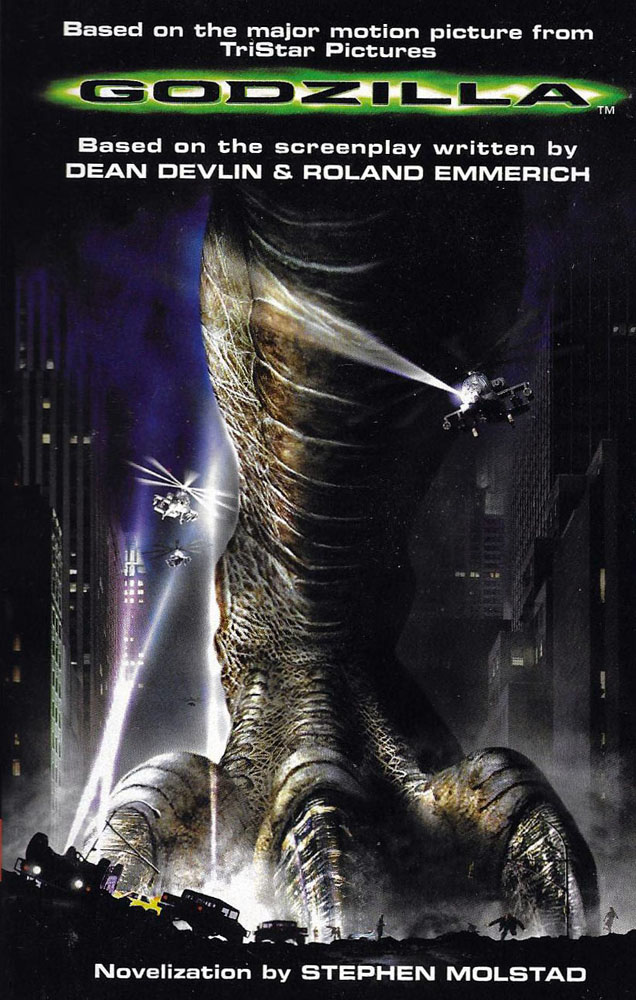 Publisher Harper Collins was unhappy with the sales of their GODZILLA movie tie-in books. © 1998 TriStar Pictures, Inc./ Toho Co., Ltd.
Publisher Harper Collins was unhappy with the sales of their GODZILLA movie tie-in books. © 1998 TriStar Pictures, Inc./ Toho Co., Ltd.The film`s poor reputation impacted many of Sony`s business partners. After forking over the lion`s share of GODZILLA`s opening week ticket sales to the studio, theater owners were angry that the film didn`t have legs. The plummeting attendance killed their profit percentages, with the Carmike Cinemas chain blaming GODZILLA for the drop in the company`s stock prices. "Carmike clearly got killed on the terms. They were told they had a diamond when they really had cubic zirconia," said one agent.13
Adding further injury was the fact that other studios had held back their own big films to avoid GODZILLA, meaning there was nothing to fill the financial gap when the TriStar film stumbled. Harper Collins was also unhappy with the sales of their GODZILLA movie tie-in books, including the official novelization that sold only ⅓ of its 400,000 copy print run. "If the movie had been a sensational hit, we would have done better," remarked a company spokesman.14
The Trendmasters GODZILLA toys and figures also sold below expectations. “Look at these damn things," complained one retailer. "They arrive after the movie opened. They’re hard to assemble. And they look like leftovers from an old Spielberg film.”15
Rob Fried said Devlin and Emmerich`s decision to keep the new look for Godzilla a secret backfired terribly. “They wouldn’t allow any of the licensees to see the creature; they weren’t even allowed to ship the toys until the day of the release of the movie, they were so obsessed with the secrecy of it. It was no big secret, but the six weeks prior to the release of the movie are when you do the bulk of your sales and they eliminated that. So when the film was disappointing they had all this excess merchandise,”16 he disclosed. "The life of movie merchandising is usually three weeks before the movie opens and three weeks after. If you cut off pre-sales, you cut off half your sales. There were a lot of unsold toys."17
There were some major successes, as well. Sony Music Entertainment`s Godzilla: The Album soundtrack, featuring music "inspired by" the movie, was certified platinum with more than 1 million copies sold. And the film`s VHS and DVD editions did a combined $8 million during its first week of rentals that November, making it the top video release since the blockbuster TITANIC the year before.
But Sony had much less luck selling the television rights for GODZILLA. After the networks rejected the studio`s asking price, Sony worked out a $25 million deal with NBC for five airings over five years. The fee was half the amount they had received for MEN IN BLACK`s broadcast rights, and a pittance next to the $80 million Universal got from FOX Television for THE LOST WORLD: JURASSIC PARK.
GODZILLA opened in Japanese theaters on July 11, 1998, just as the movie was wrapping its domestic theatrical run. Despite the disappointing box office numbers for GODZILLA`s American release, Toho expected the film to be a massive hit in Japan. "It`s going to be the event movie of the summer," studio publicist Masahiko Suzuki told writer Mark Schilling for Screen International. "We`re projecting film rentals of ¥10 billion [approximately $73 million], or about the same as PRINCESS MONONOKE and TITANIC."
GODZILLA was set to open on 400 screens across Japan -- the widest theatrical release in Toho`s history. "We are not limiting ourselves to our own circuit. We want to get this film into as many theaters as possible. Hard-core fans may say that this Godzilla is not the real thing, but we think ordinary moviegoers are going to love it."
Rather than copy TriStar`s "Size Does Matter" advertising campaign, Toho`s publicity team instead focused on television commercials, print advertising, billboards and posters in the weeks leading up to the movie`s release. "Japanese already know how big Godzilla is. We don`t have to spend a lot of money reminding them," Masahiko Suzuki explained.
Toho`s projections for GODZILLA seemed solid as the film sold 500,000 tickets on its opening Saturday, outpacing THE LOST WORLD: JURASSIC PARK`s first day sales by 150,000. The movie topped the box office, earning $8.7 million in its first week. But -- following the pattern of the US release -- attendance plummeted quickly amidst a flurry of negative reviews and poor word of mouth. In its second week, GODZILLA`s ticket sales fell by 50% and the film was bounced from the top spot by the first Pokémon movie, POCKET MONSTERS: MEWTWO STRIKES BACK (?劇場版ポケットモンスター ミュウツーの逆襲, Gekijōban Poketto Monsutā Myūtsū no Gyakushū).
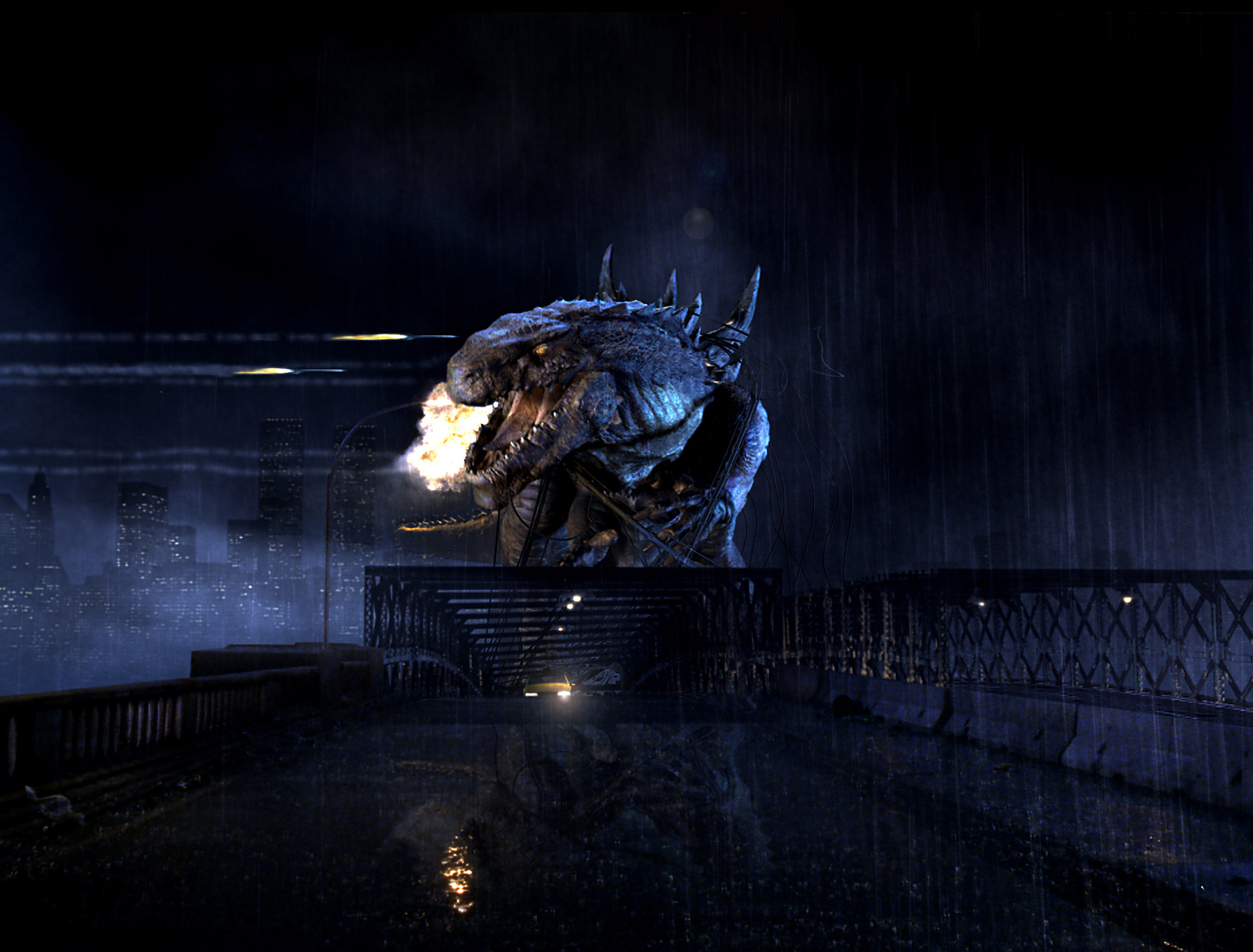 Japanese audiences were disappointed that Godzilla could be killed by missiles. © 1998 TriStar Pictures, Inc./ Toho Co., Ltd.
Japanese audiences were disappointed that Godzilla could be killed by missiles. © 1998 TriStar Pictures, Inc./ Toho Co., Ltd.As in America, Japanese moviegoers were critical of Emmerich and Devlin`s reinvention of Godzilla. "That`s not Godzilla," Godzilla-fan Yoshiyuki Kasuya told the Los Angeles Times following a Tokyo screening of the film. "He got killed with four missiles, but the Japanese Godzilla is almost bulletproof. And the Japanese Godzilla is handsome, but the American Godzilla is not."18
"We`ve been building up our expectations since rumors first surfaced of an American Godzilla in 1994," said 16 year-old Godzilla fan Masato Mukohata. "My dreams were crushed."19
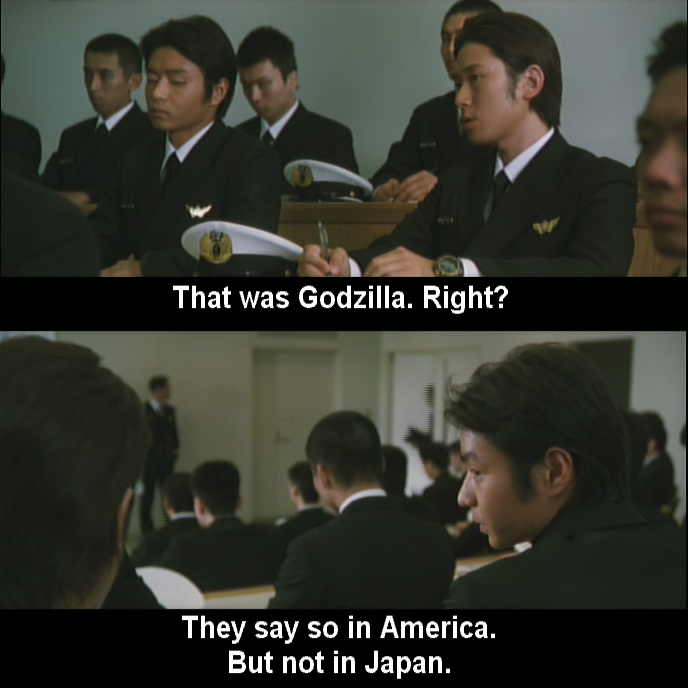 Director Shusuke Kaneko offers Japan`s take on the Emmerich/Devlin Godzilla in Toho`s GODZILLA, MOTHRA AND KING GHIDORAH: GIANT MONSTERS ALL-OUT ATTACK. © 2001 Toho Co., Ltd.
Director Shusuke Kaneko offers Japan`s take on the Emmerich/Devlin Godzilla in Toho`s GODZILLA, MOTHRA AND KING GHIDORAH: GIANT MONSTERS ALL-OUT ATTACK. © 2001 Toho Co., Ltd.Audience sentiments were echoed by filmmakers who worked on Toho`s Godzilla movies. "To be honest, I`m not pleased about this computer-graphic thing being called Godzilla," said Kenpachiro Satsuma, the suit actor who had played the monster from 1984-1995.20 Satsuma famously walked out of a screening of the new film while attending the Godzilla fan convention G-Con `98 in Chicago.
Original Godzilla suit actor Haruo Nakajima was unimpressed by the new design, asserting, "To me, its face looks like an iguana and its body and limbs look like a frog."21 And, in an interview with SPA magazine, director Shusuke Kaneko observed, "It is interesting the United States version runs about trying to escape missiles. They seem unable to accept a creature that cannot be put down by their arms." Kaneko would make a lighthearted dig at the American Godzilla in his 2001 film, GODZILLA, MOTHRA AND KING GHIDORAH: GIANT MONSTERS ALL-OUT ATTACK (ゴジラ・モスラ・キングギドラ 大怪獣総攻撃, Gojira, Mosura, Kingu Gidora: Daikaijū Sōkōgeki).
Many Japanese viewers wouldn`t accept a Godzilla that could be brought down by military might. Composer Akira Ifukube, who wrote the music for many Godzilla movies and also created the monster`s iconic roar, summed it up thusly: "Godzilla is undefeated by modern technology. It doesn`t affect him, not even electricity or missiles. He is stronger than the weapons that brought Japan to its knees [in WWII]."
But Toho called these critcisms unfair, claiming that Japanese moviegoers and reviewers who had previously been dismissive of the Godzilla series were suddenly embracing the monster as their own in the face of the American film. "Hollywood realised the sophisticated computer graphics and other technically impossible things here in Japan," argued Masahiko Suzuki. "The film is enjoyable even for long-time Godzilla fans."
GODZILLA earned approximately $33.1 million during its Japanese theatrical run, a sum described as "not overly impressive" by Variety and less than half what Toho had predicted. Rather than being "the event movie of the summer", GODZILLA was overshadowed by other Hollywood productions such as DEEP IMPACT, which made nearly $57 million (as further comparison, Devlin and Emmerich`s ID4 made nearly $93 million at the Japanese box office in 1996). Tony Manne, Executive VP of Columbia TriStar International, admitted the Japanese box office for GODZILLA was disappointing. The movie had underperformed in both dubbed and subtitled versions, suggesting that the public had not responded favorably to the film.
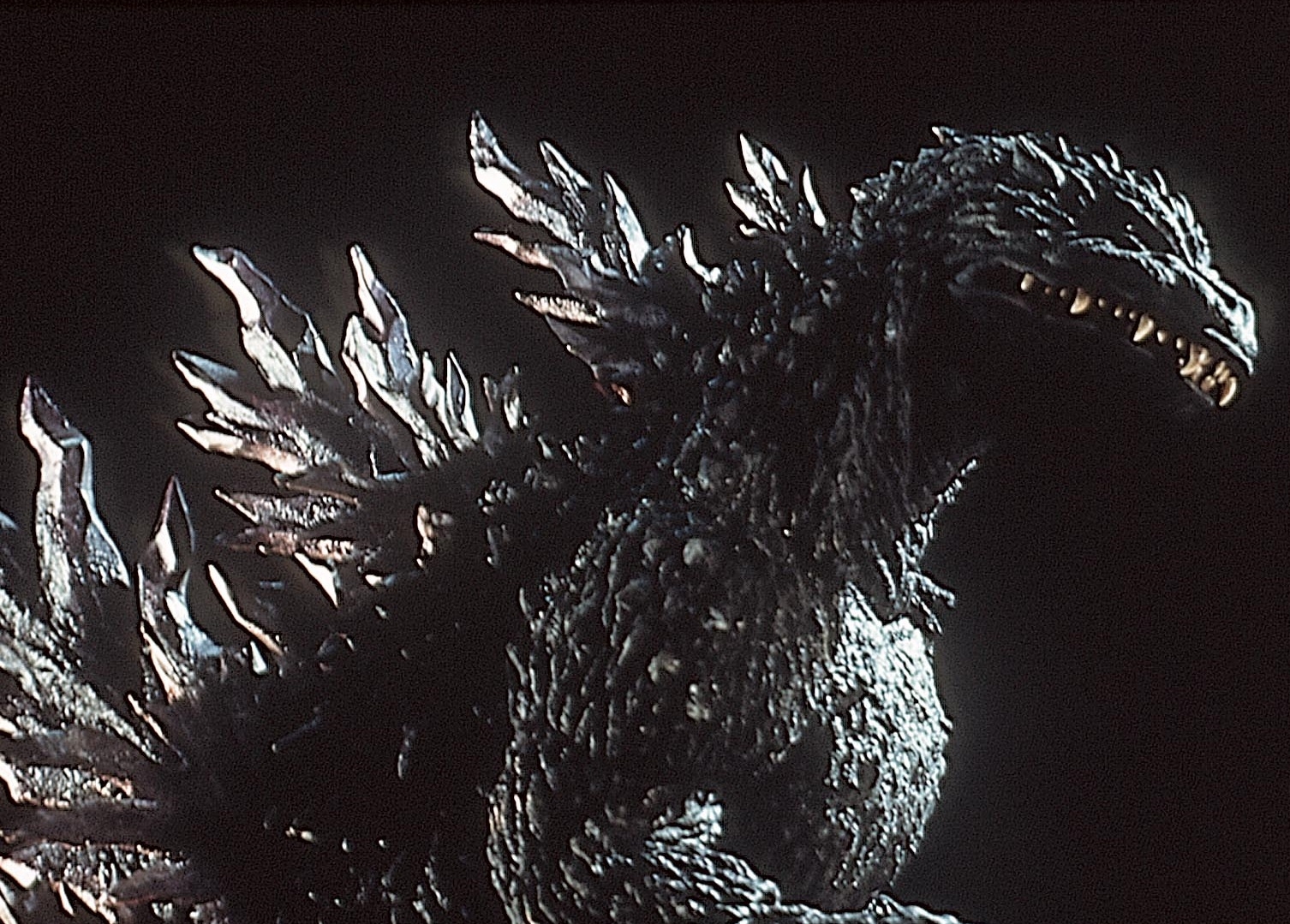
On December 14, 1998 Toho surprised Godzilla fans with the announcement that they would begin production of GODZILLA: MILLENNIUM (eventually known as GODZILLA 2000) for a Christmas 1999 release in Japan. The news spurred rumors that Toho had pulled the Godzilla license from TriStar in anger over the studio`s `mistreatment` of the character, rumors repeated by those unaware of -- or ignoring -- the fact that Toho had fully approved Roland Emmerich and Dean Devlin`s plans for Godzilla. In truth, Toho was simply exercising a clause in their 1992 contract with Sony Pictures that allowed them to make their own Japanese Godzilla movies, separate from TriStar`s. Toho currently has a similar agreement with Warner Bros. and Legendary, and new Japanese and American Godzilla movies are both now in development.
Toho explained that they had been inspired by the wave of nostalgia for the classic Godzilla that had swept Japan in the wake of TriStar`s GODZILLA. "The shape of the American version of Godzilla was so different from the Japanese version that there was a clamor among fans and company officials to create a Godzilla unique to Japan," said a company spokesman. And GODZILLA 2000 producer Shogo Tomiyama revealed, "When we decided to remake the Godzilla film, I wanted to bring back the mystery and invincibility that the monster had initially. I want people to leave the theater totally mystified and overwhelmed by Godzilla`s force."22
"The U.S. version was a bit hard to digest as the real Godzilla," asserted GODZILLA 2000 director Takao Okawara. "It was too synthetic. The essence of Godzilla`s real character is indestructibility. So since we are starting a new series, we decided to show the proper Godzilla."23
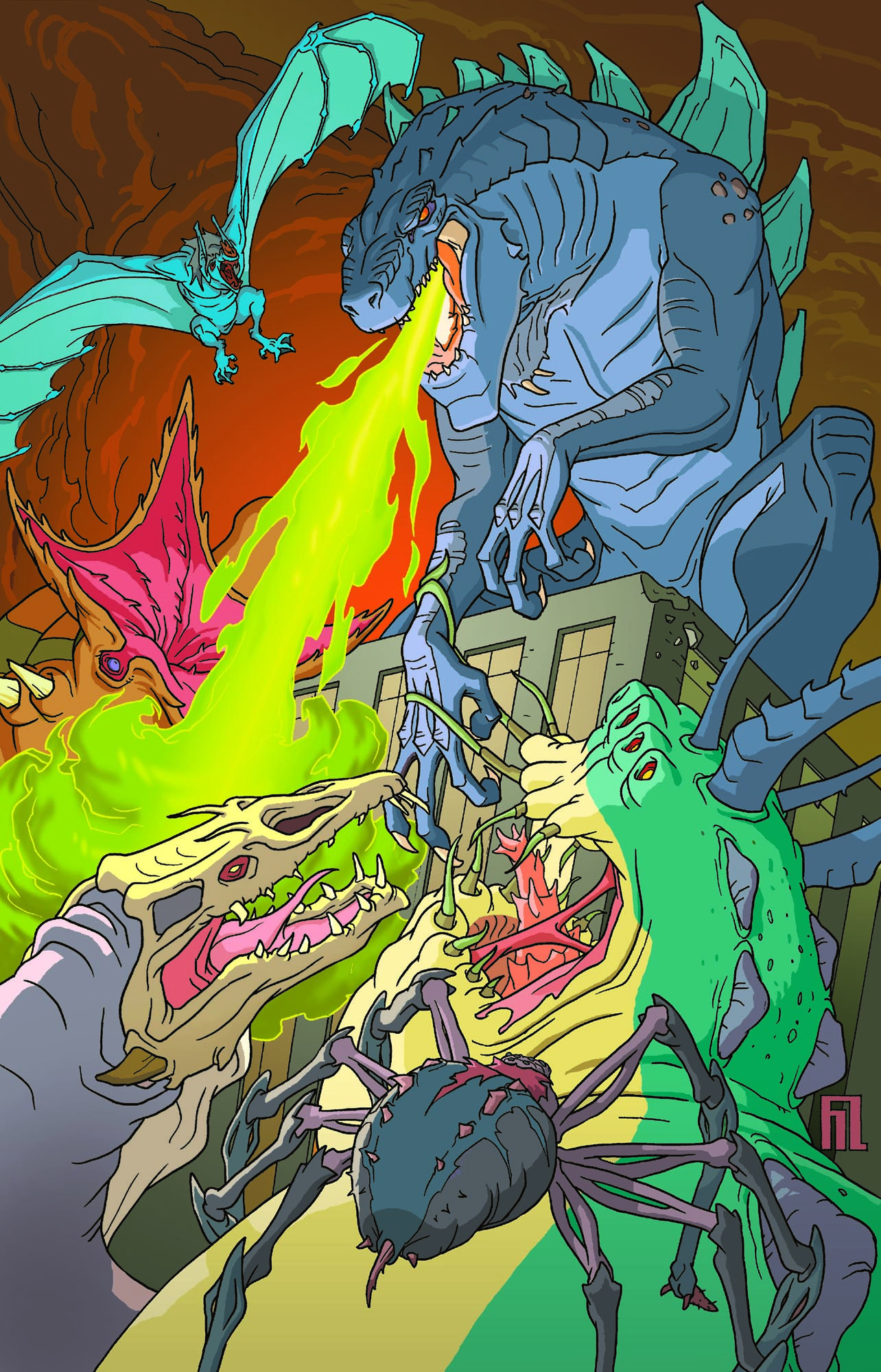 The animated spin-off GODZILLA: THE SERIES was more warmly received than the movie it was based on. © 1998 Toho Co., Ltd./Adelaide Productions, Inc.
The animated spin-off GODZILLA: THE SERIES was more warmly received than the movie it was based on. © 1998 Toho Co., Ltd./Adelaide Productions, Inc.TriStar, on the other hand, was considering their options for more GODZILLAs. The film had earned $242,700,000 internationally for a worldwide total of $379,014,294. And an animated spin-off, GODZILLA: THE SERIES, developed at the same time as the movie, premiered on FOX Television on September 12, 1998 to strong ratings -- it was the Number 1 program among boys 6-11 on any broadcast network -- and generally positive reviews from Godzilla fans who felt it treated the monster with much more respect than did the film.
Was that enough to guarantee a second film? "Sony are absolutely ready for it," insisted Roland Emmerich. "They want to kind of announce the sequel already. For Sony it`s good business." Sony Pictures president Amy Pascal agreed, telling Entertainment Weekly that, "if a movie makes $400 million, you make a sequel. It`s that simple."
But it wasn`t that simple. When Sony Pictures brought up GODZILLA 2 during a licensing conference, exhibitors -- still angry over the hit they took on the studio`s GODZILLA -- responded with a marked lack of enthusiasm. Retailers and merchandisers were also uninterested in supporting another TriStar GODZILLA... a planned line of Trendmasters GODZILLA: THE SERIES toys was canceled due to low preorders from retailers who complained they still had shelves of unsold movie merchandise. Sony soon realized that there was little demand for a GODZILLA sequel.
Roland Emmerich was unfazed by the studio`s concerns. "It looks like there will be a one," the director said in regards to a sequel. "Actually , the second is easier to do because you can take another genre... we were very much thinking about doing Monster Island [a concept from the Toho films]. Also, it`s like we can again have a very purist approach. In the first Japanese GODZILLA film the monster was alone, but now can do something really wild, like, let`s creates six or seven other monsters." Asked about Toho monsters he said, "We`ll probably come up with other monsters because we don`t want to tie ourselves too much to certain things."24
Emmerich and Devlin commissioned writer/director Tab Murphy (LAST OF THE DOGMEN, Disney’s TARZAN) to write a story treatment for GODZILLA 2. But, as Murphy worked on his outline, the Centropolis duo quit the sequel over -- ironically -- a budget dispute with Sony Pictures. "They wanted to tailor it budget-wise, so it didn`t make sense for us creatively," revealed Devlin.25
After the debacle of the first GODZILLA, John Calley had soured on the project. "A GODZILLA sequel is not a priority at this time. It`s not a picture that people are rushing around the studio trying to get made," he admitted. He felt that the 1998 film "cost too much, took a lot of time, a lot of marketing and a lot of technology development. It was a killer."26
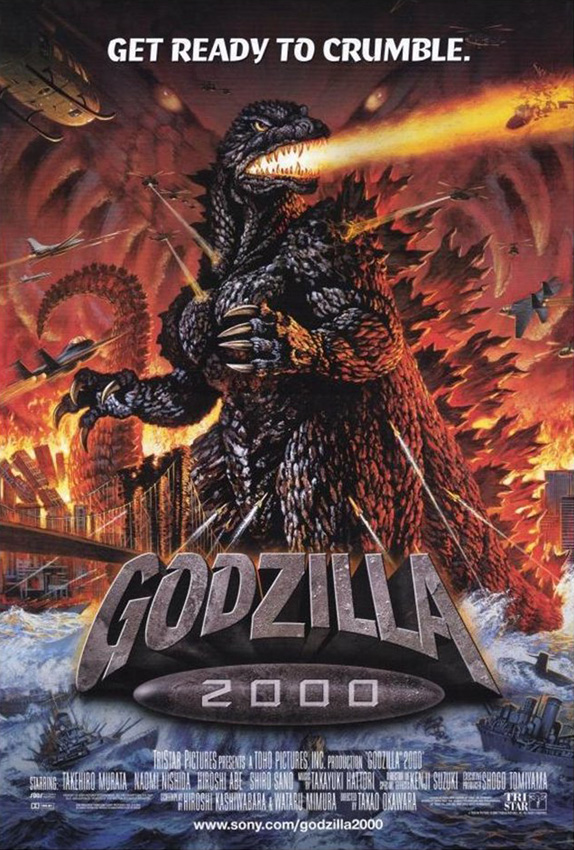
Roland Emmerich later reversed his position, telling UGO Entertainment he had been the one who advised Sony against doing a sequel to GODZILLA. "It`s so strange because people expected it to be the biggest thing ever, then it only did well. They are disappointed, and you have to defend yourself," he said. "The movie made $375 million worldwide, and THE PERFECT STORM made $325 million. Also, GODZILLA made a billion dollars in merchandise. Sony Pictures was happy with what they got. They knew that because of the media reception, they couldn`t do a GODZILLA 2. I told them not to do a sequel... because when you have a hit like INDEPENDENCE DAY, people want to see you fall."
But Dean Devlin acknowledged that he and Emmerich had dropped the ball. "People expected more, and we didn`t deliver," he admitted.27 "It didn`t live up to expectations creatively and never bounced back from the initial perception in the press that it was a box-office failure."28
Having paid Toho for an option to make a second Godzilla but understanding that a direct sequel to Emmerich`s GODZILLA wouldn`t sell, Sony Pictures considered going with a reboot with absolutely no connection to the 1998 film. While the studio mulled over that option, they decided to license Toho’s GODZILLA 2000 for a US theatrical release through TriStar. "When I visited Japan in December during the opening week of GODZILLA 2000 in Tokyo, there were huge lines, standing-room- only crowds, and [a] huge [number of] standees. It just struck me as being a very marketable idea," acknowledged Sony`s Jeff Blake.29
Part of GODZILLA 2000`s appeal for Sony was that a Japanese Godzilla film would be seen as a break from the look and story of the Devlin and Emmerich version, making it easier for the studio to go forward with their own fresh start down the line. "It`s the classic rubber-suit monster stomping around Tokyo, and that`s the fun of it," said Blake.30 But, in the end, Sony decided not to make a second Godzilla film and their remake/sequel rights expired on May 20, 2003.
Rob Fried was angered by how badly the studio had mishandled the property he had helped them acquire. “The Sony executive team that took over GODZILLA was one of the worst cases of executive incompetence I have observed in my twenty year career," he asserted. "One of the golden assets of our time, which was hand-delivered to them, was managed as poorly and ineptly as anybody can manage an asset. They took a jewel and turned it into dust.”31
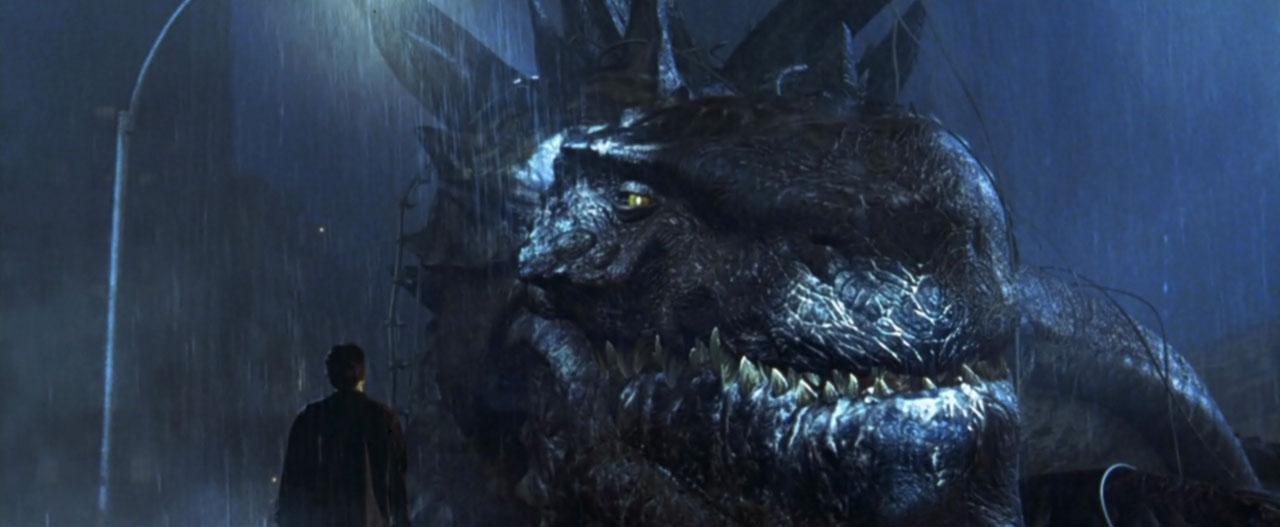 The backlash against the Devlin/Emmerich GODZILLA killed the studio`s plans for a Godzilla franchise. © 1998 TriStar Pictures, Inc./ Toho Co., Ltd.
The backlash against the Devlin/Emmerich GODZILLA killed the studio`s plans for a Godzilla franchise. © 1998 TriStar Pictures, Inc./ Toho Co., Ltd. The Winston Studio Godzilla maquette at the auction house Profiles in History. Photos courtesy of Fong Sam. © 1994 Sony Pictures Entertainment/ Toho Co., Ltd.
The Winston Studio Godzilla maquette at the auction house Profiles in History. Photos courtesy of Fong Sam. © 1994 Sony Pictures Entertainment/ Toho Co., Ltd.AFTERMATH
With Sony Pictures` option to make additional American Godzilla movies having run out, Toho was free to offer the rights to other studios. In March 2010, Warner Bros. Pictures and Legendary Pictures announced that they had signed an agreement with Toho to produce a new American GODZILLA. The new rights holders were quick to distance their GODZILLA from Roland Emmerich and Dean Devlin`s interpretation. “Our plans are to produce the Godzilla that we, as fans, would want to see,” said Legendary CEO Thomas Tull. "We intend to do justice to those essential elements that have allowed this character to remain as pop-culturally relevant for as long as it has.”
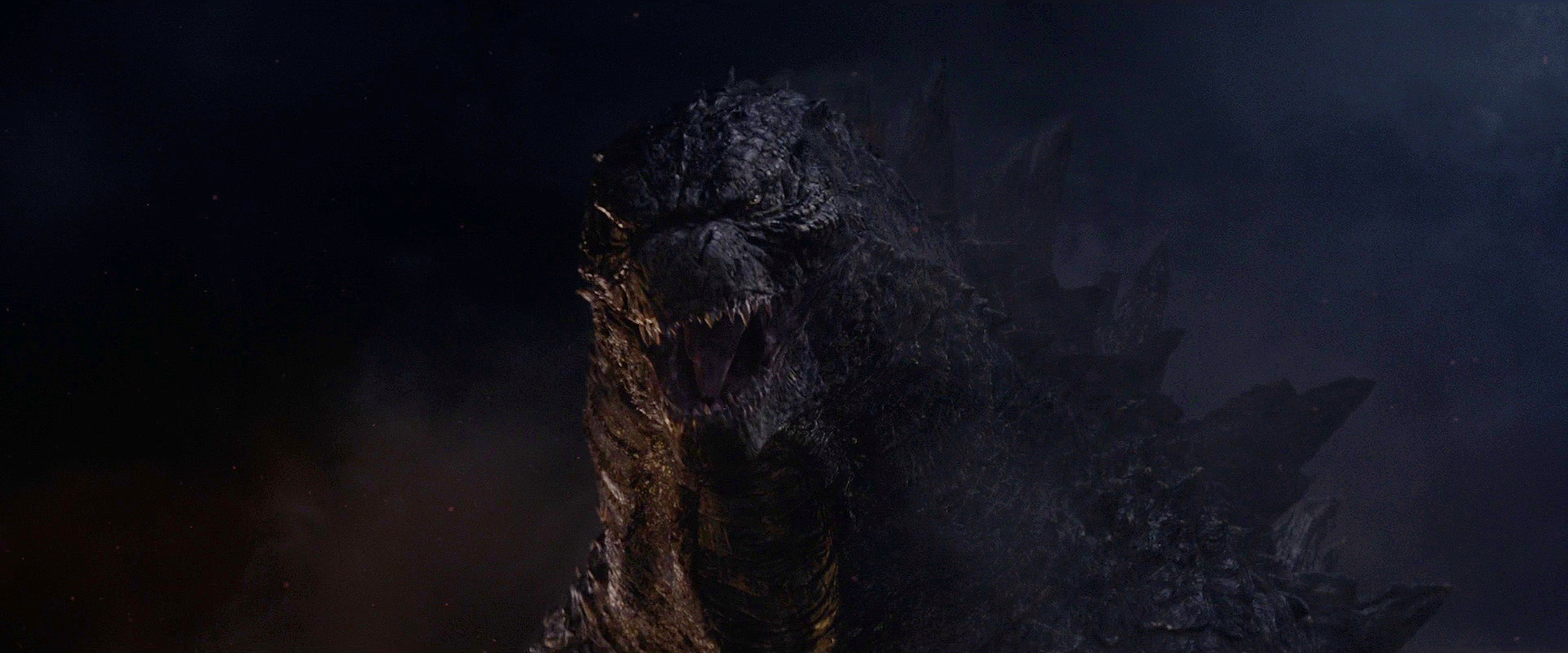 A Toho rep said the 2014 GODZILLA was closer in spirit to the original than the 1998 version. © 2014 LEGENDARY PICTURES PRODUCTIONS LLC & WARNER BROS ENTERTAINMENT INC. GODZILLA TM & © Toho Co., Ltd.
A Toho rep said the 2014 GODZILLA was closer in spirit to the original than the 1998 version. © 2014 LEGENDARY PICTURES PRODUCTIONS LLC & WARNER BROS ENTERTAINMENT INC. GODZILLA TM & © Toho Co., Ltd.While Toho publicist Masahiko Suzuki had gone to great lengths to support TriStar`s GODZILLA in 1998, studio reps presented a far different opinion as the 2014 release of the Warner Bros./Legendary film drew near. “This new Godzilla is closer in spirit to the original,” said Toho publicist Yosuke Ogura, who called Emmerich`s take on the monster a “disaster.”1
But Roland Emmerich remained undeterred by the criticism his film received, telling Crave Online, "I’m totally proud of GODZILLA. I’m always saying this, I mean I know there’s a lot of naysayers, but I’m proud of it."
"I`m not really a fanboy, so I was changing Godzilla. It was also, probably, a situation that I was a little bit talked into it." Emmerich`s one regret was that he did GODZILLA instead of the movie he really wanted to make; his meteor disaster GROUND ZERO which got derailed by DEEP IMPACT and ARMAGEDDON. "I had this whole thing planned out and a lot of people said, `You can do this after GODZILLA.` And that was a really big lesson for me because there were two [similar] movies after that", he lamented.2 “GODZILLA was fun, but Michael Bay and Mimi Leder did the movie that I wanted to do. I could have easily beaten them!"3
Dean Devlin, on the other hand, willingly acknowledged that the choices he and Emmerich made on GODZILLA had seriously hurt the film. "We did not commit to anthropomorphizing Godzilla -- meaning we did not decide if he was a heroic character or a villainous character. We made the intellectual decision to have him be neither and just simply an animal trying to survive. This was a big mistake," he admitted in a December 2014 AMA on Reddit. Asked about the negative reaction to their redesign of the monster, he replied, "I think some of the backlash on Godzilla was warranted, and some was an overreaction, but I understand, because it is a beloved character and any time you mess with something that is so adored, you risk scorn."
His Reddit replies echoed statements Dean Devlin had made before. In the wake of the Warner Bros./Legendary Pictures announcement, Devlin tweeted, "Now I have to hear all over again how our version sucked. Arrg." “I know I screwed up my GODZILLA,” he elaborated in an interview for Entertainment Weekly. “I’d be very happy if they pull it off and do a great one. I always wish I had another shot at it. But, listen, Godzilla is something that I grew up loving. We worked hard to go make one. We kind of blew it. I think everyone gets one." He offered his blessing to the new creative team, saying, “I wish them nothing but the best. I would love it if the whole Godzilla franchise was revitalized for a new generation.”4
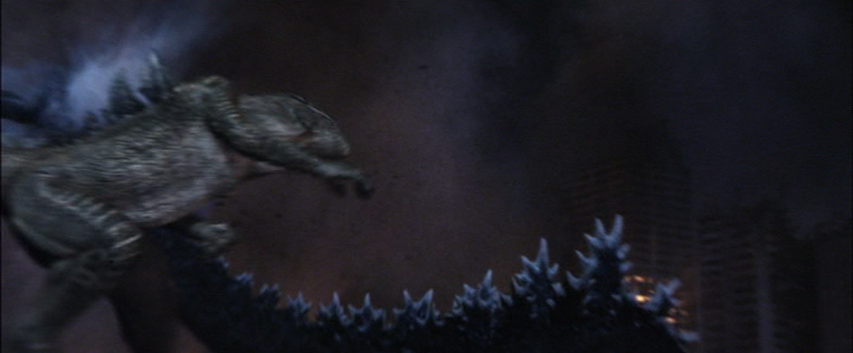 The classic Godzilla swats the TriStar Godzilla with his tail in Toho's GODZILLA: FINAL WARS. © 2004 Toho Co., Ltd.
The classic Godzilla swats the TriStar Godzilla with his tail in Toho's GODZILLA: FINAL WARS. © 2004 Toho Co., Ltd.Emmerich and Devlin`s GODZILLA has long been a source of confusion -- and aggravation -- for Godzilla fans, particularly in regards to Toho`s handling of the property following the expiration of Sony`s sequel rights. In 2004, Toho included the TriStar Godzilla in their 50th anniversary Godzilla movie, GODZILLA: FINAL WARS (?ゴジラ ファイナル ウォーズ, Gojira Fainaru Wōzu), in which the CG beast is quickly defeated by the Japanese original.
Interviewed by this author the day before the film`s world premiere, producer Shogo Tomiyama explained, "[Director Ryuhei] Kitamura asked me if it was possible for us to use the American Godzilla in FINAL WARS, so I checked our contract with Sony Pictures and found out we could use it. Since this was the 50th anniversary film, I thought `Why not include the American Godzilla?`". Tomiyama felt that, as the first American movie version of Godzilla, the character had left a mark on the franchise. "There is some special meaning to having him in this film -- but mostly, we just wanted to show which Godzilla is stronger."
While the monster goes unnamed in the film itself, Toho`s GODZILLA: FINAL WARS promotional materials identify it as "Zilla". This led some fans to declare that Toho had `disavowed` the TriStar movie and officially changed the name and copyright for the 1998 film and creature from "Godzilla" to "Zilla". But this mistaken belief ignored both the terms of the 1992 contract and Toho`s long history of creating multiple versions of their monster characters. The arrangement between Toho and Sony Pictures stipulated that the two companies would share the copyright for the TriStar film in perpetuity, meaning that both parties would have to agree for that copyright to be altered.
Beyond that legal hurdle, neither company is interested in changing the copyright; Sony paid handsomely for the right to use the Godzilla name and intends to hold onto those rights, while Toho continues to profit from the Sony deal and can also boast over rival Japanese studios that (now) two major Hollywood productions have been based on their character. As of 2015, the copyrights for the 1998 film are as follows... Sony Pictures: © 1998 TRISTAR PICTURES, INC. ALL RIGHTS RESERVED. GODZILLA ® and the GODZILLA character and design are trademarks of Toho Co., Ltd. The GODZILLA character and design are copyrighted works of Toho Co., Ltd. All are used with permission. Toho: GODZILLA [1998 Edition] © 1998 TRISTAR PICTURES, INC. ALL RIGHTS RESERVED. © TOHO CO, LTD. ALL RIGHTS RESERVED.
In creating "Zilla" for FINAL WARS, Toho continued a decades-old tradition of assigning unique names, trademarks and copyrights to the different incarnations of their monsters, including such favorites as Mechagodzilla (Mechagodzilla 2, Super Mechagodzilla, Mechagodzilla Kiryu), Mothra (Mothra Leo, Fairy Mothra, Aqua Mothra, Armor Mothra, Eternal Mothra) and King Ghidorah (Mecha-King Ghidorah, Cretaceous King Ghidorah, Grand King Ghidorah, Monster X II, Kaizer Ghidorah). This practice allows the studio to both maintain the original brand while also offering a "new" version for additional films and merchandising.
Toho played with the "same but different" strategy in their GODZILLA: FINAL WARS theater program booklet sold at Japanese cinemas showing the film. Zilla is described as "A monster, similar in appearance to an iguana, that attacks Sydney. Its true identity is unknown, but according to one theory it may be the same monster that struck New York in 1997. There are many common features such as its fast movement and consumption of tuna, but its authenticity remains a mystery."
Toho has repeatedly stated that they still consider the 1998 film to be GODZILLLA. The November 29, 2004 world premiere of FINAL WARS was part of a celebration in Los Angeles that included Godzilla receiving a star on the Hollywood Walk of Fame. In their application for the award, Toho included the TriStar movie in the monster`s filmography, stating, "GODZILLA has starred in 28 motion pictures including the 1998 blockbuster film produced in Hollywood."
In 2008, Toho digitally restored the Godzilla series in high definition for the "Godzilla X Hi-Vision" promotion on the Japanese Movie Speciality Channel. The films Toho selected for HD restoration were the 28 Japanese Godzilla movies and the 1998 GODZILLA. In 2010, Toho Music included composer David Arnold`s GODZILLA 1998 score in their final GODZILLA SOUNDTRACK PERFECT COLLECTION, a 6 volume CD box set of all the Godzilla movie soundtracks released in Japan.
In America, Zilla appeared in the Godzilla: Rulers of Earth comic book series from IDW Publishing in 2013. The monster`s return ignited another round of fan debates, with G:ROE artist Matt Frank stepping in to set things straight. "For the record," he wrote, "Toho makes zero distinction between `Zilla` and `Godzilla 1998` with the exception of title alone. The film itself is recognized as GODZILLA, as is the animated series. Ever since 2004, Toho`s official stance has been that any future incarnations of the character be referred to hereafter as `Zilla`." Frank also shot down speculation that Zilla was the same as the Godzilla from Sony`s animated show GODZILLA: THE SERIES, stating that the cartoon Godzilla was its own character, "not within [IDW`s] net of licenses, nor do I think we would be able to obtain it."5
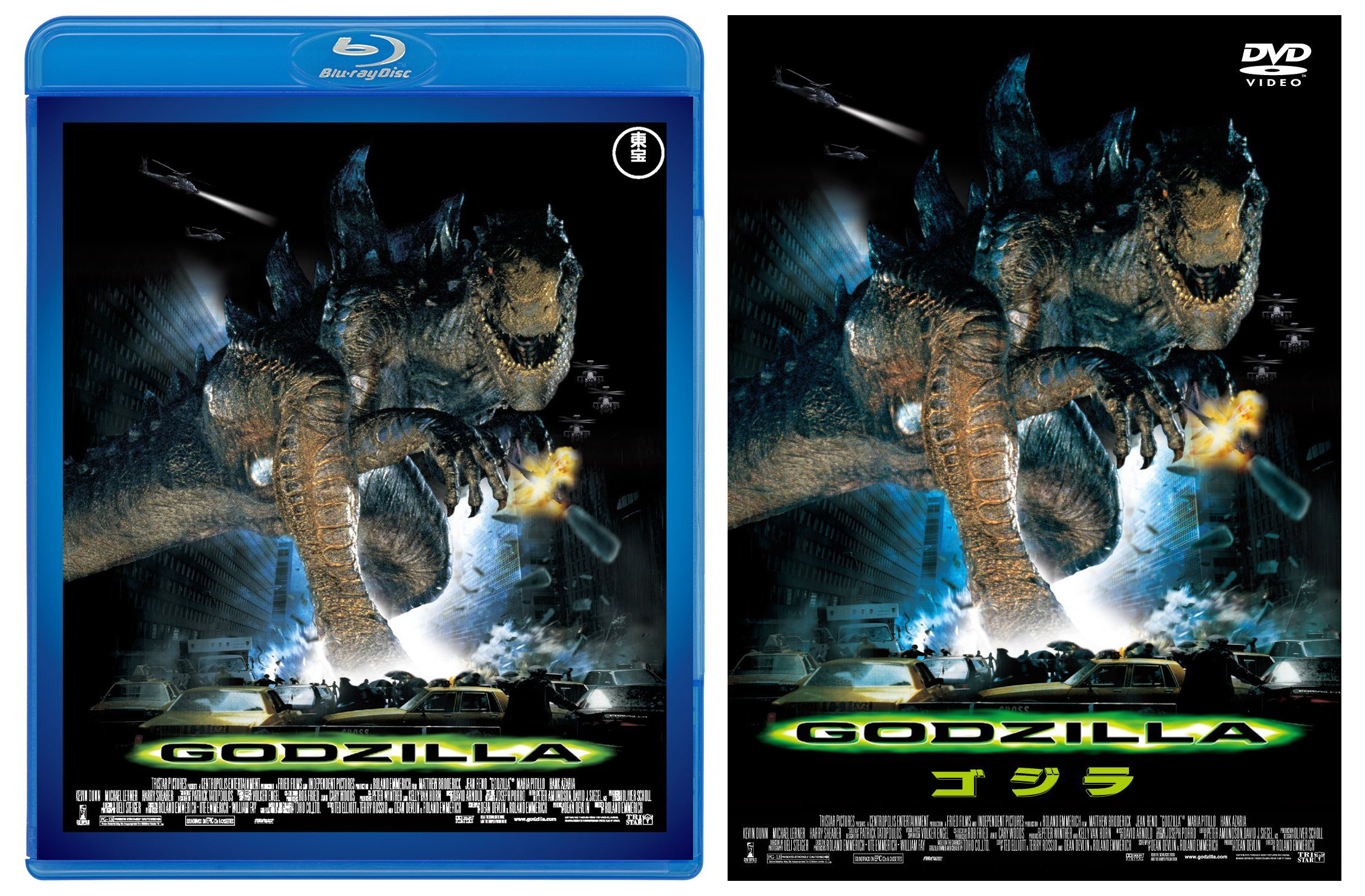 Godzilla 60th Anniversary Blu-ray and DVD editions of the TriStar GODZILLA, released in Japan by Toho in 2014. © 1998 TriStar Pictures, Inc./ Toho Co., Ltd.
Godzilla 60th Anniversary Blu-ray and DVD editions of the TriStar GODZILLA, released in Japan by Toho in 2014. © 1998 TriStar Pictures, Inc./ Toho Co., Ltd.Back in Japan, Toho celebrated Godzilla`s 60th Anniversary by releasing Blu-ray and DVD editions of the entire series in 2014. The lineup included the 28 Toho Godzillas plus the TriStar GODZILLA, with the title spelled out in both English and Japanese.
 Toho included both the 1998 and 2014 American GODZILLAs in the 30 Godzilla movie series on the Japanese satellite service WOWOW. GODZILLA (1998) © 1998 TriStar Pictures, Inc./ Toho Co., Ltd. GODZILLA (2014) © 2014 LEGENDARY PICTURES PRODUCTIONS LLC & WARNER BROS ENTERTAINMENT INC. GODZILLA TM & © Toho Co., Ltd.
Toho included both the 1998 and 2014 American GODZILLAs in the 30 Godzilla movie series on the Japanese satellite service WOWOW. GODZILLA (1998) © 1998 TriStar Pictures, Inc./ Toho Co., Ltd. GODZILLA (2014) © 2014 LEGENDARY PICTURES PRODUCTIONS LLC & WARNER BROS ENTERTAINMENT INC. GODZILLA TM & © Toho Co., Ltd.The most recent example as of this writing occurred in May and June 2015, as Toho partnered with the Japanese satellite service WOWOW for HD airings of the Godzilla series. Both the 1998 TriStar and 2014 Warner Bros./Legendary GODZILLAs aired alongside the Toho-produced films, with WOWOW and Toho promoting the event as the first time "all 30 Godzilla movies" are broadcast together.
As the 1998 GODZILLA holds its odd (and unpopular) place in Godzilla history, Jan De Bont`s 1994 GODZILLA has taken on its own unique status for fans. Nearly 21 years have passed since the film was canceled and it is still a regular topic of discussion on Godzilla websites, message boards and social media.
And while they never got the chance to bring their GODZILLA to the screen, many of those involved with the film have gone on to a wide range of high-profile projects. Visual effects supervisor Boyd Shermis divides his time between feature films, commercials and TV mini-series. His post-GODZILLA credits include BATMAN FOREVER, FACE/OFF, SUPERMAN RETURNS, POSEIDON -- which has received nominations from the Academy Awards and the Visual Effects Society -- FANTASTIC FOUR: RISE OF THE SILVER SURFER and GI JOE: THE RISE OF COBRA. He said, "In terms of what I’ve been up to; I’ve mostly been writing scripts these last few years, as well as studying acting, directing actors etc., -- looking to get a few feature projects of my own off the ground."
Godzilla concept artist Ricard Delgado has also kept busy. "I’m still working in concept design," he said. "I’m working over at Disney Feature Animation right now, and teaching part-time at Art [Center College of Design]. I’ve written a couple novels that have been published, and I’m still doing my Age of Reptiles comics." "I was supervising director on the TV mini-series DINOSAUR REVOLUTION. A lot of it was initially based on my comic books, but they added some narration and some paleontological bumpers. I got into the DGA, it was my first directing credit and I hope to direct again. It was fun. Giant reptiles have been good to me."
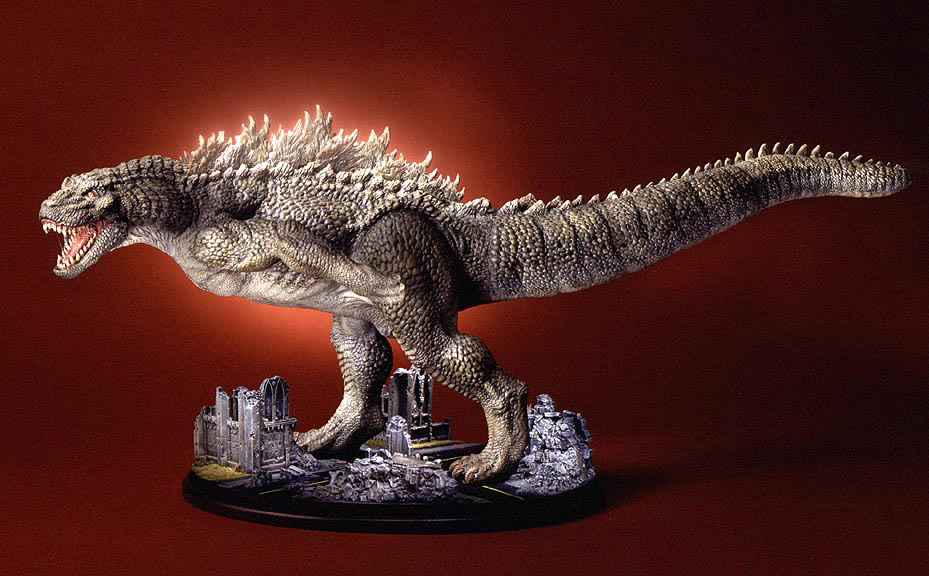 A variation of Ricardo Delgado`s Godzilla design was used for the Delgadosaurus kit sculpted by Bob Bagy. © 1999 Ricardo Delgado Designs/ Needful Things
A variation of Ricardo Delgado`s Godzilla design was used for the Delgadosaurus kit sculpted by Bob Bagy. © 1999 Ricardo Delgado Designs/ Needful ThingsA variation of Delgado`s 1994 Godzilla was later released as a cold-cast porcelain kit by Needful Things. Dubbed the "Delgadosaurus", the figure was sculpted by professional prop and costume designer Bob Bagy.
Looking back at De Bont`s GODZILLA, Delgado observed, "It wasn’t fated to be, and I certainly watched the Emmerich GODZILLA with ‘what could have been’ wishful thinking. But that’s the way it works out."
Ted Elliott and Terry Rossio have become two of the most successful writers in Hollywood with the PIRATES OF THE CARIBBEAN series, THE MASK OF ZORRO, SHREK and NATIONAL TREASURE: BOOK OF SECRETS. "Our GODZILLA screenplay was about inappropriate grief response and the need for both reason and belief to come to terms with an inherent, inescapable and necessary fact of life: death," Elliott wrote on the duo`s website, Wordplay. "And, of course, we weren`t trying to change minds -- except those who held that a GODZILLA movie could not have `good writing.` (And, quite frankly, *we* succeeded. Others decided to ignore what we held to be `good writing,` and ended up making a movie of inferior quality -- something which has happened more often than not in our careers)."
On Wordplay, Terry Rossio provided further explanation in his introduction to the 1994 GODZILLA screenplay, writing, "One thing they don`t warn you about in film school, that nobody tells you about regarding screenwriting, is THE SPEECH. For most of the films I`ve worked on that have been produced, I`ve had to learn some version of The Speech. What happens is this: people (friends, relatives) come up to you and say something like, `I saw THE PUPPET MASTERS on television the other night,` or `Hey, didn`t you work on GODZILLA?` And you feel compelled to explain that yes, you worked on the picture, but you know that it`s terrible, it`s okay that they hated it, you would have done it differently, etc. You find yourself in the situation so often, the collection of disclaimers, apologies and explanations for a movie eventually become rote."
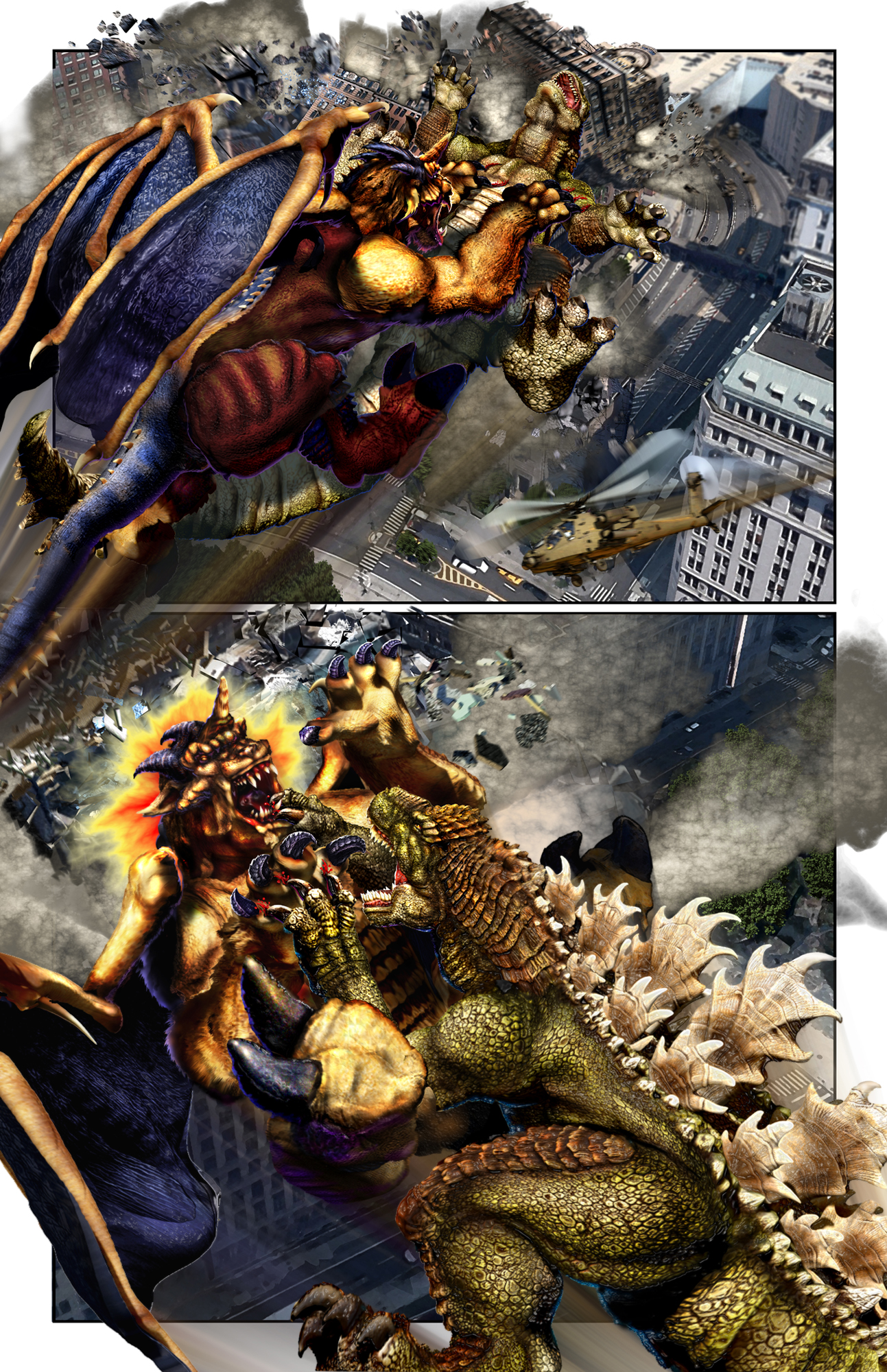 Godzilla fights the Gryphon in a page from the GODZILLA 1994 graphic novel. Image courtesy of Todd Tennant and Terry Rossio. © 1994 Sony Pictures Entertainment/ Toho Co., Ltd.
Godzilla fights the Gryphon in a page from the GODZILLA 1994 graphic novel. Image courtesy of Todd Tennant and Terry Rossio. © 1994 Sony Pictures Entertainment/ Toho Co., Ltd."For example, here`s `The Speech` for GODZILLA: Yes, we worked on it, but our script got thrown out. We got story credit because they kept some basic elements -- but in our draft, Godzilla fought a second monster, and kicked his ass. We realized that Godzilla was the hero, and even if people were afraid of him in the beginning, they wanted to root for him in the end."
"To which people invariably look relieved (`Great, I don`t have to pretend the movie wasn`t crap`) and say, `Oh, that would have been much better`... And it would have been."
Terry Rossio is now collaborating with comic book artist Todd Tennant on a graphic novel adaptation of the Elliott/Rossio GODZILLA screenplay. Once work is completed the two will look into publishing options.
Storyboard artist David Russell has worked on dozens of popular movies such as THE THIN RED LINE (1998), MOULIN ROUGE (2001), MASTER AND COMMANDER: THE FAR SIDE OF THE WORLD (2003), the CHRONCLES OF NARNIA series, TRANSFORMERS (2007), X-MEN ORIGINS: WOLVERINE (2009) and Lucasfilm`s RED TAILS (2012). Discussing the latter film, he noted that, "I was very pleased to have been involved with the project, in large part because my father was a Tuskegee Airman. Additionally, it was a pleasure to work with George Lucas again, who gave me my first job into the industry on RETURN OF THE JEDI." Russell also created artwork for Alex Proyas` epic film, PARADISE LOST, which spent several years in development before being canceled in 2014 by Legendary Pictures over budgetary concerns. Outside the film world, he has illustrated several book covers and written some fantasy novels of his own, including Mojo in Oz and Enchanters: Glys of Myradelle (now available as an e-book).
Chris Lee has supervised a number of hit films, among them MY BEST FRIEND’S WEDDING, LEGENDS OF THE FALL, THE FISHER KING, THE MASK OF ZORRO and THE PATRIOT. In 2000 he was one of the co-founders of Legendary Pictures; fourteen years later the company would release their own GODZILLA remake through Warner Bros.
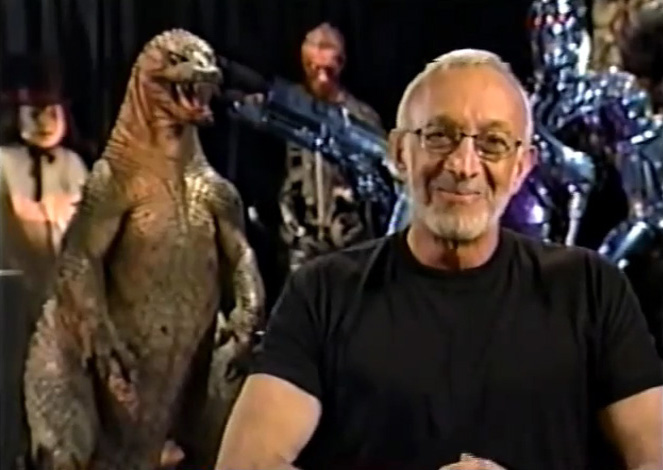 Stan Winston and Godzilla introduce a broadcast of RODAN for the AMC program AMC EFX. © American Movie Classics Company, LLC.
Stan Winston and Godzilla introduce a broadcast of RODAN for the AMC program AMC EFX. © American Movie Classics Company, LLC.From 1994-1997, Stan Winston was the host of the AMC documentary series MOVIE MAGIC about the many FX techniques developed for film and television. Episodes would air Friday evenings, followed by a special effects movie shown under the "AMC EFX" banner. Each AMC EFX movie would also feature an introduction by Winston, surrounded by many of the creature props and maquettes created by his studio. The 1994 Godzilla maquette would occasionally be among those displayed, most often before airings of giant monster movies like RODAN, FRANKENSTEIN CONQUERS THE WORLD, GAMERA and GODZILLA VS SPACEGODZILLA.
Stan Winston Studio continued as one of the industry`s top FX houses through the passing of Stan Winston in June 2008. SWS supervisors Shane Mahan, John Rosengrant, Lindsay Macgowan and Alan Scott formed Legacy Effects to continue the Winston tradition, while the Winston family founded the Stan Winston School of Character Arts to teach future generations of aspiring filmmakers. In early 2008, Winston Studio auctioned off a number of production models and concept designs through the Hollywood memorabilia dealer Profiles in History. Among the items sold to private collectors were artwork and resin maquettes for Godzilla and the Probe Bat.
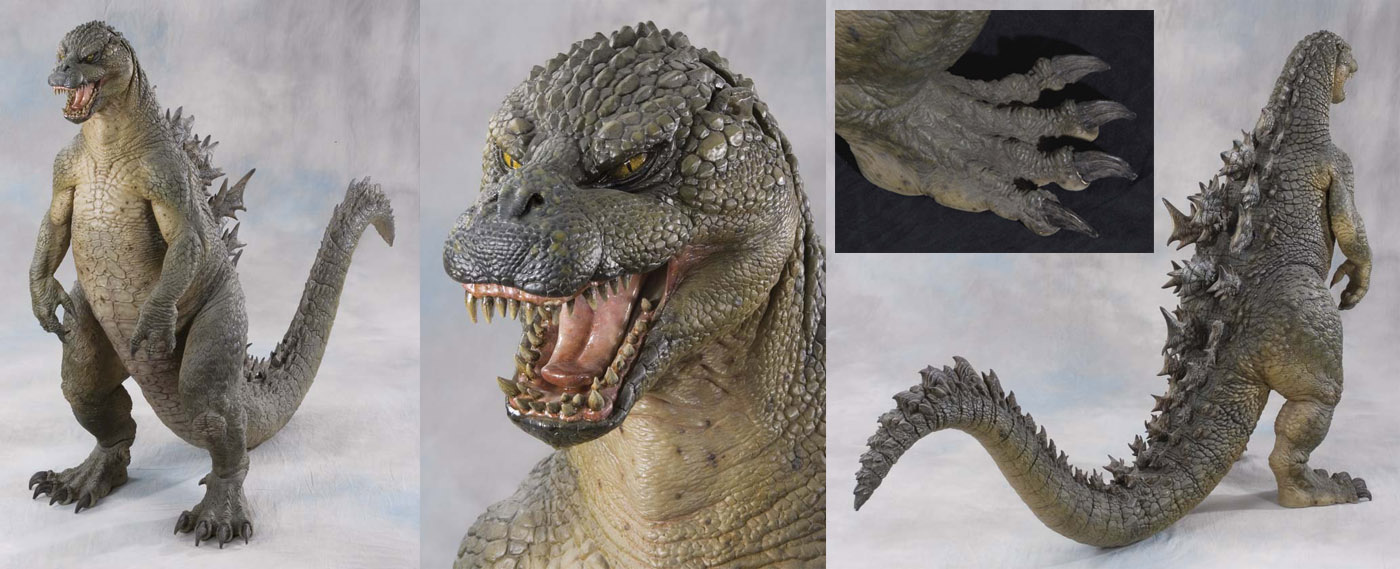 Profiles in History catalog photos of the Godzilla maquette. Photos courtesy of Profiles in History. © Stan Winston Studio © 1994 Sony Pictures Entertainment/ Toho Co., Ltd.
Profiles in History catalog photos of the Godzilla maquette. Photos courtesy of Profiles in History. © Stan Winston Studio © 1994 Sony Pictures Entertainment/ Toho Co., Ltd.The Gryphon maquette was not offered for sale. Winston artist David Monzingo explained that, "Sadly, the Gryphon did not survive the ages. It was made out of silicone rubber, and in the early 90`s our knowledge of silicone was weak; it was a relatively new material to the industry and we were still learning the ins and outs of it. Silicone has a limited shelf life before it begins to deteriorate, and time finally caught up with that maquette. I believe it was decided to remove it from the SWS display room sometime in the mid 2000`s as it was beginning to fall apart. Now there`s nothing left of it."
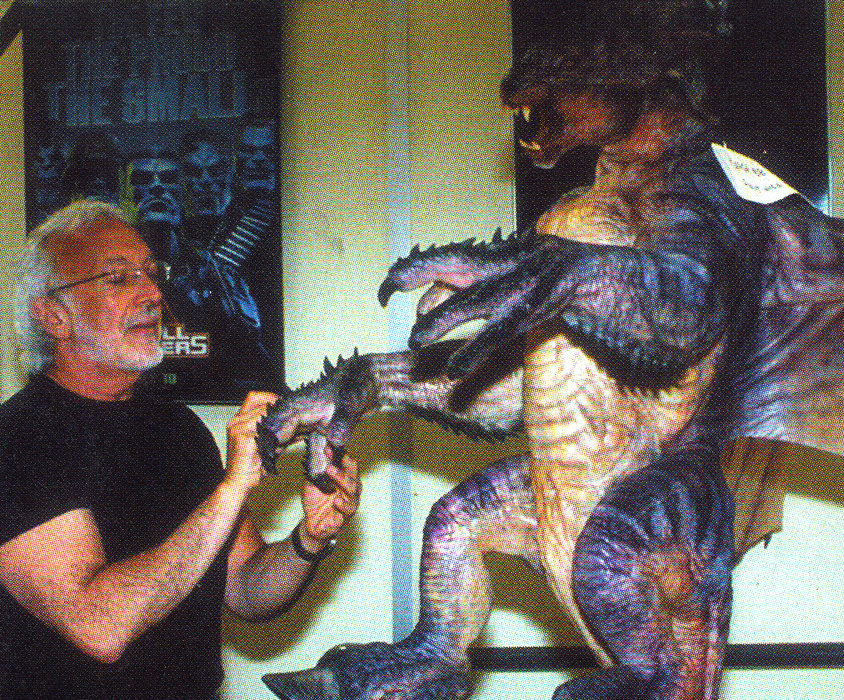 Stan Winston with the Gryphon maquette ina photo from ToyFare Magazine in 2001. Photo used with the consent of editor Justin Aclin and photographer Jilly Wendell. © Stan Winston Studio © 1994 Sony Pictures Entertainment/ Toho Co., Ltd.
Stan Winston with the Gryphon maquette ina photo from ToyFare Magazine in 2001. Photo used with the consent of editor Justin Aclin and photographer Jilly Wendell. © Stan Winston Studio © 1994 Sony Pictures Entertainment/ Toho Co., Ltd.Gryphon sculptor Mark Maitre recalled that, "When were moving out of that studio after Stan passed, we took the Gryphon down and it just fell apart. It was kind of sad. I almost took the head, but I’m like, ‘Nahh!’"
"I don`t know if the molds for the Gryphon still exist or not," said Monzingo. "SWS at one time had a massive mold library of all it`s projects, but when SWS downsized in the early 2000`s they threw away many molds, I don`t know if the Gryphon mold survived or not." But Maitre felt that possibility was very unlikely, stating, "I’m sure the mold got either auctioned or destroyed."
Many of the former Stan Winston artists now work for Legacy Effects. "Sheep`s Clothing Productions is my personal company, but I`m a full time employee at Legacy myself," David Monzingo explained. "Sheep`s Clothing`s most recent projects were a short film called AMBUSH with Lance Henriksen, and another short called CATERWAUL which we created some puppets for."
Bruce Spaulding Fuller has worked at Both Legacy and Patrick Tatopoulos Designs, with credits on the UNDERWORLD series, ALICE IN WONDERLAND (2010) and THOR (2011).
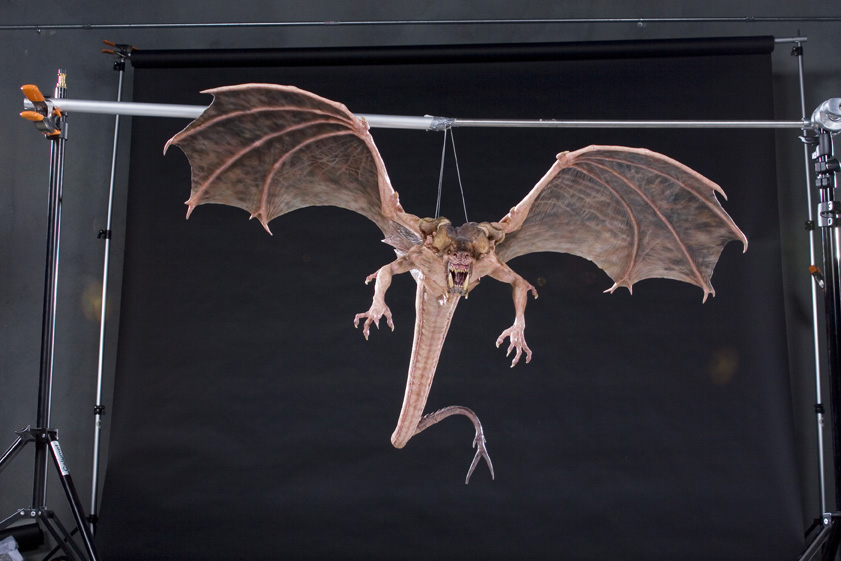 Photo courtesy of Stan Winston School of Profiles in History. © Stan Winston Studio © 1994 Sony Pictures Entertainment/Toho Co., Ltd.
Photo courtesy of Stan Winston School of Profiles in History. © Stan Winston Studio © 1994 Sony Pictures Entertainment/Toho Co., Ltd.Paul Mejias has created designs, sculpts and on set effects for movies like TERMINATOR SALVATION (2009), THOR, THE AVENGERS, LIFE OF PI (2012) and THE BOURNE LEGACY (2012). Mark Maitre`s recent credits include AVATAR, ALICE IN WONDERLAND, THOR, COWBOYS AND ALIENS (2011), LIFE OF PI and THE BOURNE LEGACY. Joey Orosco explained that, "I’m freelance now after 15-16 years at Stan’s. And before that I spent close to three years at Rick Baker’s. AVATAR was my last film at Stan’s. What a great film to end on, by the way... the biggest grossing film in history."
Orosco is currently working on Hiroshi Katagiri`s independent horror film GEHENNA - WHERE DEATH LIVES, and is pleased to see a renewed interest in practical and makeup effects after years of over reliance on CGI. "Working with all my great friends like Matt Rose and Norman Cabrera and Steve Wang -- we all feel that makeup effects are making a comeback, resurgence. All those years rolling at Stan’s, we were just a well-oiled machine churning out films. And all that ended when CG just stopped everything. But some of the producers and directors these days love practical, love having something on set again as long as it works right and looks great. CG has just been overloaded. There are so many CG companies, and not every company is great... not every one is Weta or ILM. There’s a lot of bad CG happening and that opens the door for us to come back. Nice to get back into a rhythm again." Mark “Crash” McCreery has maintained his status as the top creature and concept designer in Hollywood, with credits on such hit films as A.I. ARTIFICIAL INTELLIGENCE, the PIRATES OF THE CARIBBEAN series, HULK (2003), ENCHANTED (2007), and the upcoming JURASSIC WORLD (2015).
Jan De Bont had his second box office smash with TWISTER, which earned $241.7 million in the US and more than $600 million in 1996. The director returned to 20th Century Fox as promised to make SPEED 2: CRUISE CONTROL (1997), which proved an expensive box office failure. He was unable to secure studio backing for his proposed sci-fi western GHOST RIDERS IN THE SKY, and instead directed a remake of THE HAUNTING in 1999 and TOMB RAIDER: THE CRADLE OF LIFE in 2003. In recent years he has focused on commercial work and has also produced films such as the Steven Spielberg/Tom Cruise hit MINORITY REPORT (2002).
But GODZILLA is still the movie that got away. "It’s one of those few movies where people go, ‘what a missed opportunity that was`," Jan De Bont told SciFi Japan. "Especially because the script was really good; it was all in the service of Godzilla. And that’s what Ted and Terry are so good at. Even in their animation films they know exactly what the characters need. In my opinion they made a modern masterpiece, and the studio has to live with that."
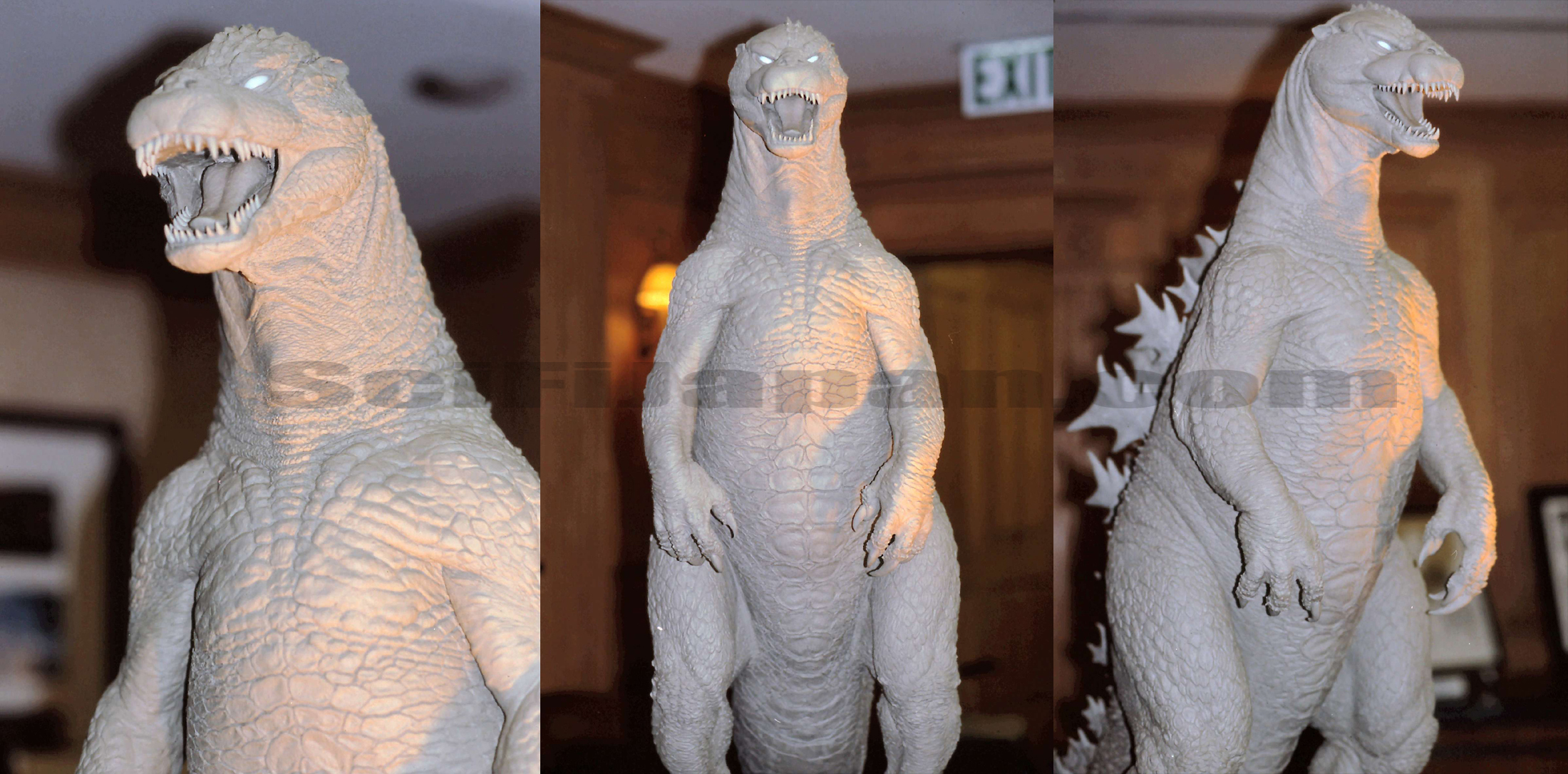 Photos courtesy of Jan De Bont. © Stan Winston Studio © 1994 Sony Pictures Entertainment/ Toho Co., Ltd.
Photos courtesy of Jan De Bont. © Stan Winston Studio © 1994 Sony Pictures Entertainment/ Toho Co., Ltd.GODZILLA (1994) CREDITS
Based on the character “Godzilla” owned and created by Toho Co., Ltd.
Director: Jan De Bont
Screenplay: Ted Elliott and Terry Rossio
Screenplay (1995 Rewrite): Don Macpherson
Producers: Cary Woods and Robert N. Fried Executive
Producer: Ian Bryce
Associate Producer: Glenn Salloum
VP Motion Picture Production TriStar Pictures: Chris Lee
EVP Motion Picture Production TriStar Pictures: Ron Lynch
Line Producer: Barrie M. Osborne
Production Manager: Louis G. Friedman
Production Designer: Joseph Nemec III
Art Department Coordinator: Carla Nemec
Supervising Art Director: Dan Olexiewicz
Visual Effects Supervisor: Boyd Shermis
Special Effects Coordinator (Practical Effects): John Frazier, Fxperts
Miniature Effects: Mark Stetson, Stetson Visual Services, Inc.
Storyboards: Giacomo Ghiazza and David Russell
Casting Director: Risa Bramon Garcia
Godzilla Effects
Gojira Productions
Godzilla Concept Design: Ricardo Delgado
Gryphon and Probe Bat Concept Designs: Carlos Huante
Alien Concept Design: David Russell
Production Art: Ricardo Delgado
Stan Winston Studio
Creature Effects Producer: Stan Winston
Production Supervisor: John Rosengrant
Godzilla and Gryphon Concept Designs: Mark "Crash" McCreery
Godzilla Lead Sculptor: Joey Orosco
Godzilla Sculptors: Mark Maitre, Scott Stoddard, Paul Mejias, Bruce Spaulding Fuller, Ken Brilliant, Mike Smithson, David Monzingo
Gryphon Lead Sculptor: Mark Maitre
Gryphon Sculptor: Scott Stoddard
Probe Bat Concept Design and Lead Sculptor: Bruce Spaulding Fuller
Probe Bat Sculptor: Ken Brilliant
Alien Concept Design: Greg Figiel
Maquette Painter: Jim Charmatz
Digital Domain
Special Visual Effects and Digital Animation: Stan Winston, James Cameron and Scott Ross
Visual Effects Producer: Brooke Breton
Visual Effects Supervisor: Jay Riddle
VIFX
Visual Effects Producer: Richard Hollander
Visual Effects Supervisor: Greg McMurray
Sony Pictures Imageworks
Visual Effects Supervisors: Tim McGovern and John Nelson
FX Test Art Director: Jon Townley
FX Test Godzilla Head Sculptor: Michael Hood, Precision Effects
FX Test Godzilla Figure Sculptors: Jeff Farley, Chris Bergschneider and Dirk Von Besser, Obscure Artifacts
Scanning: Viewpoint DataLabs
NOTES
RETRENCHMENT
1. Dan Cox, De Bont Vs. GODZILLA, Daily Variety, December 16, 1994, p33?
2. Amy Longsdorf, The Twist On `Twister` A Whirlwind Of Traumatic Fun For Cast And Crew, The Morning Call, May 10, 1996?
3. Bill Moseley, 20,000 Leagues Under the Sea: An Interview with James Cameron, Omni, 1998?
4. Steve Ryfle, Regarding Henry, July 1995?
5. Mike Fleming Jr, Cary Woods And His Long Road Back Into Film, Deadline Hollywood, June 17, 2013?
6. David Milner, New Wave Godzilla, Cult Movies #19, 1996, p36?
7. Linda Sieg, After 4 Decades, Godzilla Faces Extinction, Maybe, Reuters News Service, December 11, 1995?
THE DISCONNECT
1. Rachel Aberly, The Making of GODZILLA, (HarperPrism, 1998), pp15-16?
2. Bob Strauss, New-Look Godzilla Unleashed in Remake, Daily News, May 17, 1998?
3. Peter Bart, The Gross, (St. Martin’s Press, 1999), pp107-108?
4. Mike Ryan, Roland Emmerich, `White House Down` Director, Explains Who And What We`ll See In `Independence Day 2` (Not Boomer), Huffington Post, June 26, 2013?
5. Peter Bart, The Gross, (St. Martin’s Press, 1999), p107?
6. Bob Strauss, New-Look Godzilla Unleashed in Remake, Daily News, May 17, 1998?
7. Howard Chua-Eoan, What In The Name Of Godzilla...?, Time, May 25, 1998?
8. Kevin H. Martin, The Sound and the Fury, Cinefex #74, July 1998, p85?
9. Peter Bart, The Gross, (St. Martin’s Press, 1999), p107?
10. Kevin H. Martin, The Sound and the Fury, Cinefex #74, July 1998, p85?
11. Peter Bart, The Gross, (St. Martin’s Press, 1999), pp108-109?
12. Kevin H. Martin, The Sound and the Fury, Cinefex #74, July 1998, p86?
13. Sean Mitchell, The Return of Godzilla, Los Angeles Times, May 17, 1998?
14. Steve Ryfle and Steve Biodrowski, Godzilla Greenlighted, Cinefantastique Vol 28 #1, August 1996, p6?
15. Chuck Wagner, Waiting for Godzilla, SFX #30, October 1997, p62?
16. Steve Ryfle and Steve Biodrowski, Godzilla Greenlighted, Cinefantastique Vol 28 #1, August 1996, p6?
17. Mike Fleming Jr, Cary Woods And His Long Road Back Into Film, Deadline Hollywood, June 17, 2013?
18. Rachel Aberly, The Making of GODZILLA, (HarperPrism, 1998), p25?
19. Chuck Wagner, Monster! Monster!, SFX #37, April 1998, p56?
20. Steve Ryfle and Steve Biodrowski, Godzilla Greenlighted, Cinefantastique Vol 28 #1, August 1996, p61?
21. Jeff Dawson, We`re Off to See the Lizard, Empire #110, August 1998, p118?
22. Mike Ryan, Roland Emmerich, `White House Down` Director, Explains Who And What We`ll See In `Independence Day 2` (Not Boomer), Huffington Post, June 26, 2013?
23. Jeff Dawson, We`re Off to See the Lizard, Empire #110, August 1998, p118?
24. Rachel Aberly, The Making of GODZILLA, (HarperPrism, 1998), pp24-25?
25. Rachel Aberly, The Making of GODZILLA, (HarperPrism, 1998), p24?
26. Mike Ryan, Roland Emmerich, `White House Down` Director, Explains Who And What We`ll See In `Independence Day 2` (Not Boomer), Huffington Post, June 26, 2013?
27. Rachel Aberly, The Making of GODZILLA, (HarperPrism, 1998), p25?
28. Howard Chua-Eoan, What In The Name Of Godzilla...?, Time, May 25, 1998?
29. Patrick Tatopoulos, The Art of GODZILLA, (Panpo Pirorin, 1998), p4?
30. Rachel Aberly, The Making of GODZILLA, (HarperPrism, 1998), p26?
31. Rachel Aberly, The Making of GODZILLA, (HarperPrism, 1998), p27?
32. Chris Nashawaty, Stomp the World, I Want to Get Off, Entertainment Weekly #433, May 22, 1998, p27?
33. Rachel Aberly, The Making of GODZILLA, (HarperPrism, 1998), p20?
34. Howard Chua-Eoan, What In The Name Of Godzilla...?, Time, May 25, 1998?
35. Ibid.?
36. Chuck Wagner, Monster! Monster!, SFX #37, April 1998, p56?
37. Mike Ryan, Roland Emmerich, `White House Down` Director, Explains Who And What We`ll See In `Independence Day 2` (Not Boomer), Huffington Post, June 26, 2013?
38. Valerie Reitman, Godzilla Returns Home Something of a Stranger, Los Angeles Times, July 13, 1998?
39. Chuck Wagner, Monster! Monster!, SFX #37, April 1998, p55?
40. Chuck Wagner, Godzilla, Cinefantastique Vol 30 #1, May 1998, p11?
41. Katsunobu Higashino, Toho Monster Graffiti, (Kindai Eigasha, 1991), pp35-37?
42. Howard Chua-Eoan, What In The Name Of Godzilla...?, Time, May 25, 1998?
43. Sean Mitchell, The Return of Godzilla, Los Angeles Times, May 17, 1998?
44. Katsunobu Higashino, Toho Monster Graffiti, (Kindai Eigasha, 1991), pp35-37?
45. Tim Carvell, How Sony Created A Monster, Fortune, June 8, 1998?
46. Ibid.?
47. Peter Bart, The Gross, (St. Martin’s Press, 1999), p108?
48. Chris Nashawaty, Stomp the World, I Want to Get Off, Entertainment Weekly #433, May 22, 1998, p28?
49. Tom Shone, Blockbuster: How Hollywood Learned to Stop Worrying and Love the Summer, (Free Press, 2004), p270?
50. `Godzilla` Revived By `ID4` Script Duo, Daily Variety, October 15, 1996?
51. Ibid.?
52. Steve Ryfle and Steve Biodrowski, Godzilla Greenlighted, Cinefantastique Vol 28 #1, August 1996, p61?
53. Rachel Aberly, The Making of GODZILLA, (HarperPrism, 1998), p7?
54. Rachel Aberly, The Making of GODZILLA, (HarperPrism, 1998), p9?
55. Tom Shone, Blockbuster: How Hollywood Learned to Stop Worrying and Love the Summer, (Free Press, 2004), p270?
56. Dave Golder, Two-Headed Monster Makers, SFX: The Making of GODZILLA, August 1998, p8?
57. Ibid.?
58. Rachel Aberly, The Making of GODZILLA, (HarperPrism, 1998), p23?
59. Monica Roman, Monster Promo for Sony, Variety, February 9, 1998?
60. Tim Carvell, How Sony Created A Monster, Fortune, June 8, 1998?
61. Simon Ashdown, Godzilla under wraps, KidScreen, February 1, 1998?
62. Tim Ryan, Godzilla: Reporters got in the action during filming in Oahu, Honolulu Star-Bulletin, August 28, 1997?
63. Bob Strauss, New-Look Godzilla Unleashed in Remake, Daily News, May 17, 1998?
64. Claudia Eller and James Bates, Attack of the Killer Franchise: Sony Banks on GODZILLA Becoming a Monster Hit, Los Angeles Times, November 7, 1997?
65. Chuck Wagner, Monster! Monster!, SFX #37, April 1998, p55?
66. Kevin H. Martin, The Sound and the Fury, Cinefex #74, July 1998, p101?
67. Matthew Scott, Monster hopes for the new Godzilla, South China Morning Post, May 17, 1998?
68. Chuck Wagner, Waiting for Godzilla, SFX #30, October 1997, p62?
69. Tom Shone, Blockbuster: How Hollywood Learned to Stop Worrying and Love the Summer, (Free Press, 2004), p267?
70. Tim Carvell, How Sony Created A Monster, Fortune, June 8, 1998?
71. Chris Nashawaty, Stomp the World, I Want to Get Off, Entertainment Weekly #433, May 22, 1998, p28?
72. Eric Lichtenfeld, Action Speaks Louder: Violence, Spectacle and the American Action Movie, (Wesleyan University Press, 2007), p218?
73. Robert W. Welkos, There Will Be No Escaping `Godzilla`, Los Angeles Times, May 14, 1998?
74. Godzilla: He`s Big. He`s Upset. He`s Invisible, BusinessWeek, April 5, 1998?
75. Robert W. Welkos, There Will Be No Escaping `Godzilla`, Los Angeles Times, May 14, 1998?
76. Kate O`Hare, Predicting the future is what..., Chicago Tribune, October 18, 1998?
77. Ian Spelling, Maria Pitillo as Audrey Timmonds, GODZILLA- The Official Movie Magazine, p45?
REACTION
1. Chuck Wagner, Monster! Monster!, SFX #37, April 1998, p56?
2. Peter Bart, The Gross, (St. Martin’s Press, 1999), p203?
3. Michael Fleeman, `Godzilla` team admits lizard flick was turkey, Associated Press, September 14, 1998?
4. Peter Bart, The Gross, (St. Martin’s Press, 1999), p204?
5. Michael Fleeman, `Godzilla` team admits lizard flick was turkey, Associated Press, September 14, 1998?
6. Eric Lichtenfeld, Action Speaks Louder: Violence, Spectacle and the American Action Movie, (Wesleyan University Press, 2007), p218?
7. Rose DeWolf, It`s Big, All Right - A Big Flop: `Godzilla` Takes A Stomping At The Box Office And In The Stores, Daily News, June 12, 1998?
8. Peter Bart, The Gross, (St. Martin’s Press, 1999), p200?
9. Tom Shone, Blockbuster: How Hollywood Learned to Stop Worrying and Love the Summer, (Free Press, 2004), p270?
10. Michael Fleeman, `Godzilla` team admits lizard flick was turkey, Associated Press, September 14, 1998?
11. Dave Golder, Two-Headed Monster Makers, SFX: The Making of GODZILLA, August 1998, p9?
12. Dave Golder, Two-Headed Monster Makers, SFX: The Making of GODZILLA, August 1998, p10?
13. Anita M. Busch, Godzilla Too?, Entertainment Weekly #437, June 19, 1998, p46?
14. Rose DeWolf, It`s Big, All Right - A Big Flop: `Godzilla` Takes A Stomping At The Box Office And In The Stores, Daily News, June 12, 1998?
15. Tom Shone, Blockbuster: How Hollywood Learned to Stop Worrying and Love the Summer, (Free Press, 2004), p270?
16. Ibid.?
17. Eric Lichtenfeld, Action Speaks Louder: Violence, Spectacle and the American Action Movie, (Wesleyan University Press, 2007), p218?
18. Valerie Reitman, Godzilla Returns Home Something of a Stranger, Los Angeles Times, July 13, 1998?
19. Ibid.?
20. A Lizard Leaps From Tokyo To Hollywood, Newsweek Vol 131 #21 May 25, 1998, p49?
21. Aaron Smith, G-CON `98 Interview with Haruo Nakajima and Kenpachiro Satsuma, Sci-Fi Channel?
22. Calvin Sims, Japanese Trying To Restore Godzilla To Its Roots With `Millennium’, New York Times, December 9, 1999?
23. Linda Sieg, Godzilla Back for New Millennium, Reuters News Service, November 6, 1999?
24. Dave Golder, Two-Headed Monster Makers, SFX: The Making of GODZILLA, August 1998, p10?
25. Claudia Eller, Sony Relying on a Compact Import for Next `Godzilla`, Los Angeles Times, June 13, 2000?
26. Ibid.?
27. Michael Fleeman, `Godzilla` team admits lizard flick was turkey, Associated Press, September 14, 1998?
28. Claudia Eller, Sony Relying on a Compact Import for Next `Godzilla`, Los Angeles Times, June 13, 2000?
29. Ibid.?
30 Ibid.?
31. Tom Shone, Blockbuster: How Hollywood Learned to Stop Worrying and Love the Summer, (Free Press, 2004), p269?
AFTERMATH
1. Mark Schilling, Japanese Warm Up to Idea of American ‘Godzilla’, Variety, May 18, 2014?
2. Mike Ryan, Roland Emmerich, `White House Down` Director, Explains Who And What We`ll See In `Independence Day 2` (Not Boomer), Huffington Post, June 26, 2013?
3. Phil De Semlyen, Why, Monster, Empire Magazine #298, April 2014, p76?
4. Adam B. Vary, Dean Devlin on the recently announced `Godzilla` reboot: `I know I screwed up my Godzilla`, Entertainment Weekly, July 27, 2012?
5. Matt Frank, Comment on Godzilla: Rulers of Earth #2, DeviantArt, May 9, 2013?


